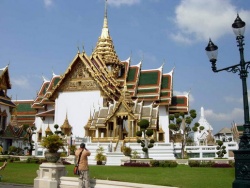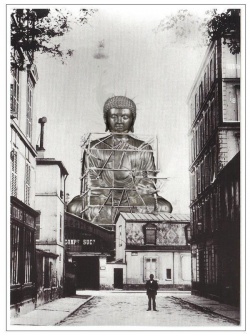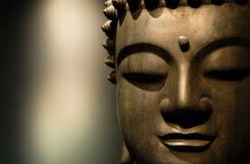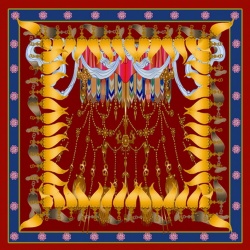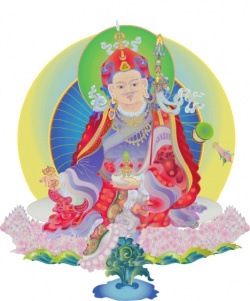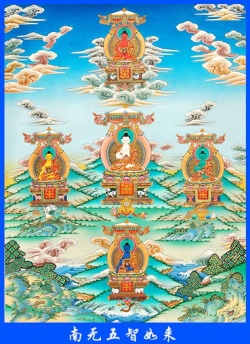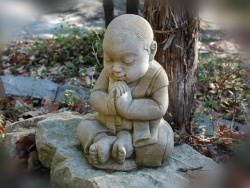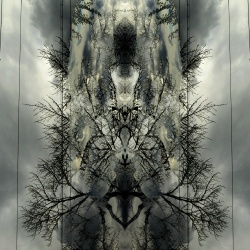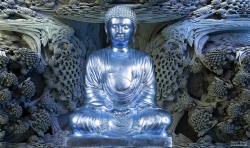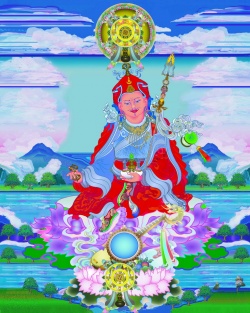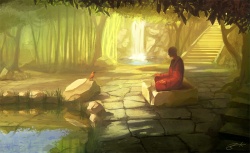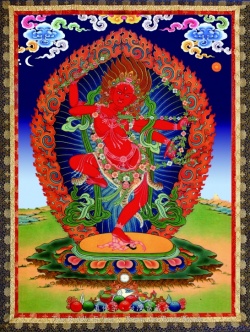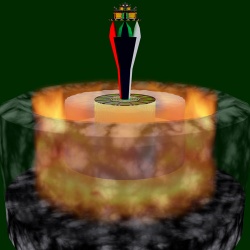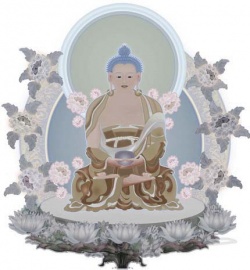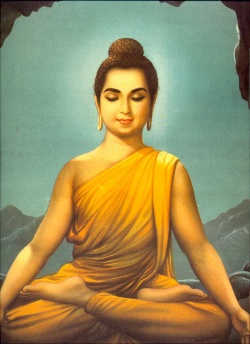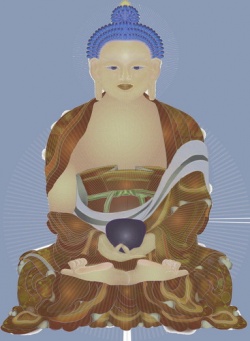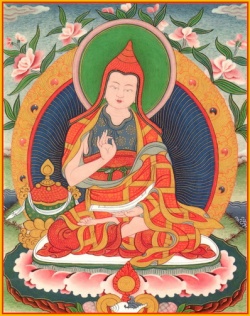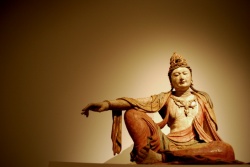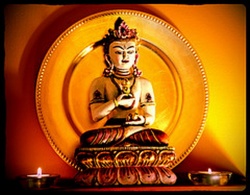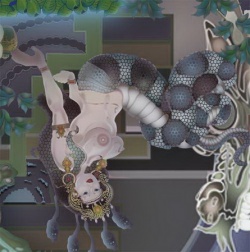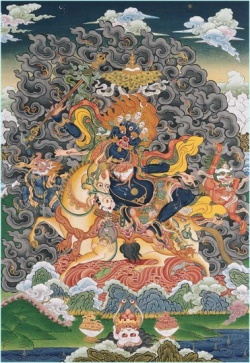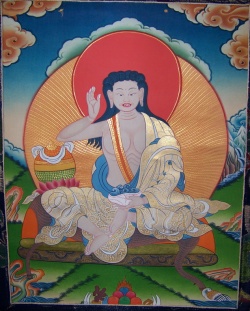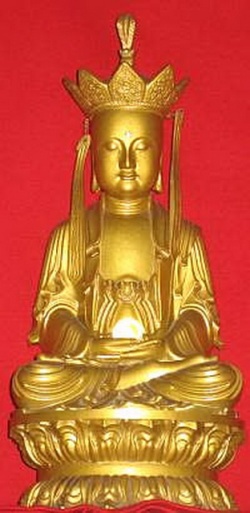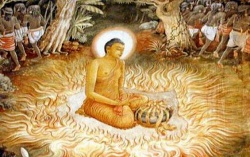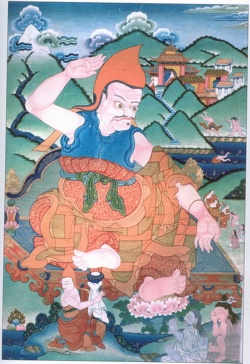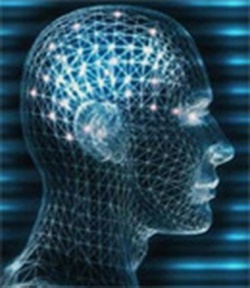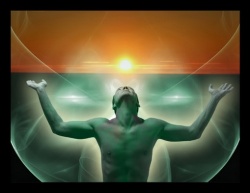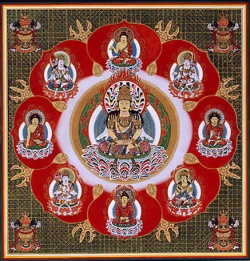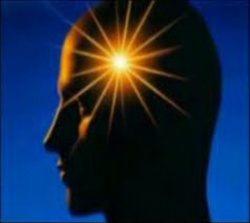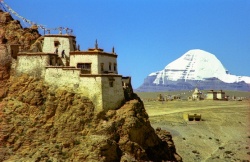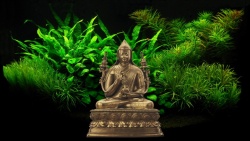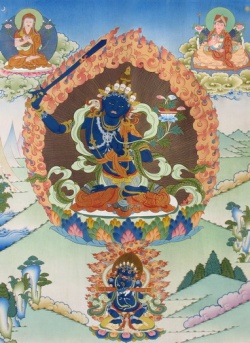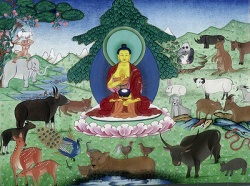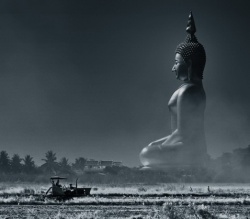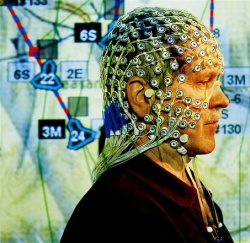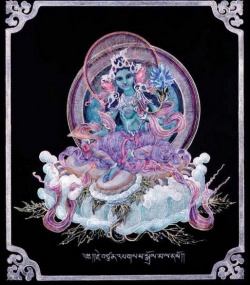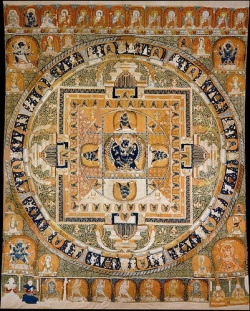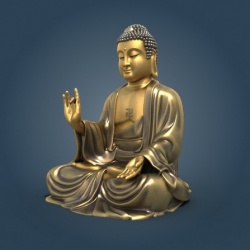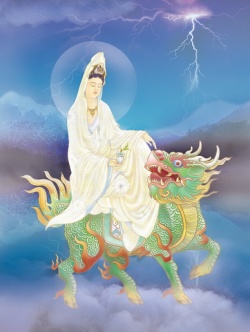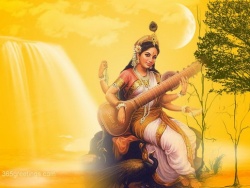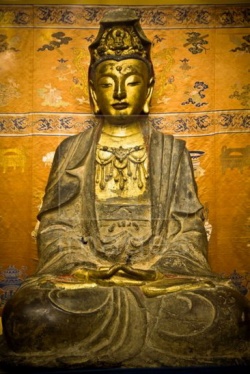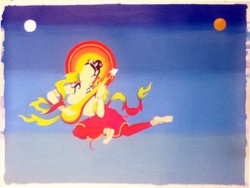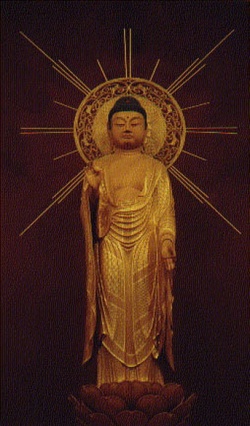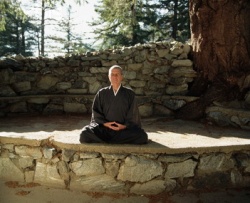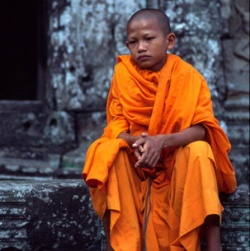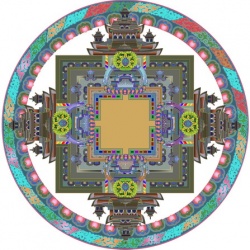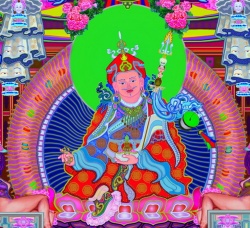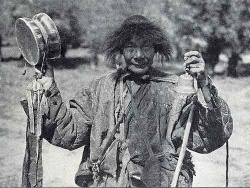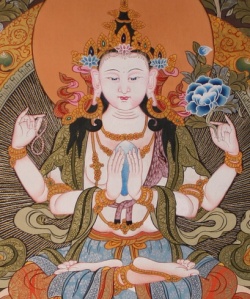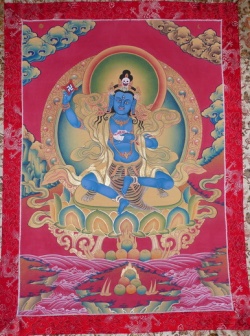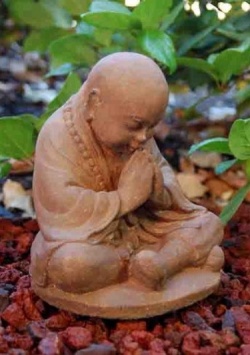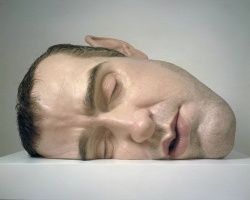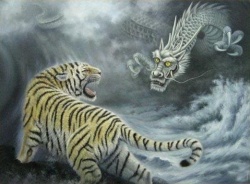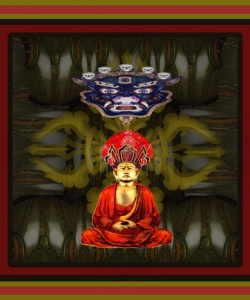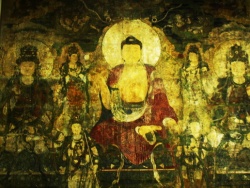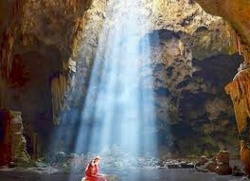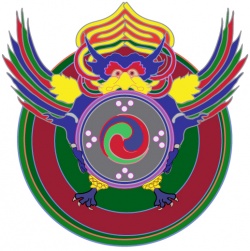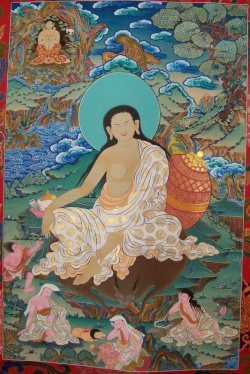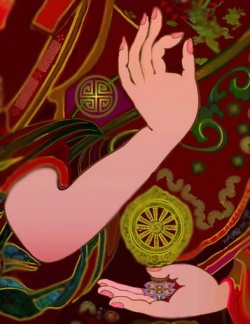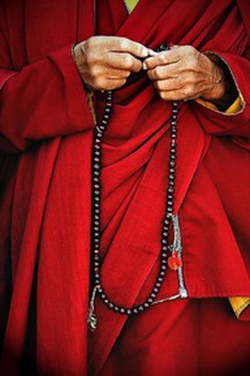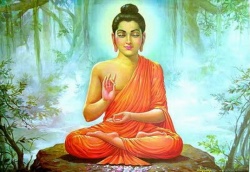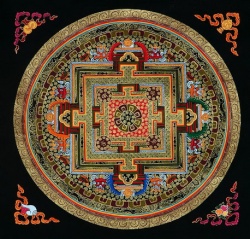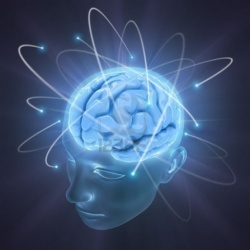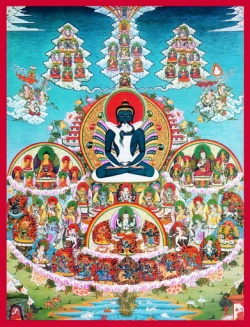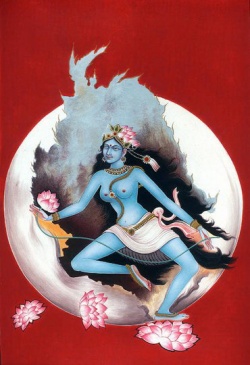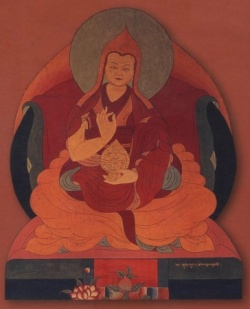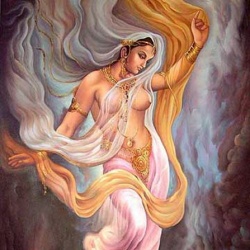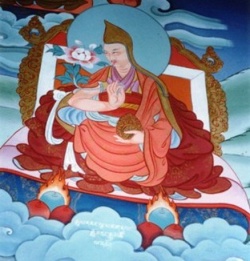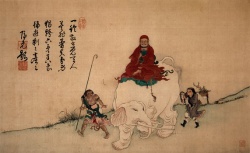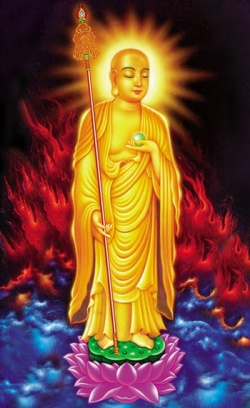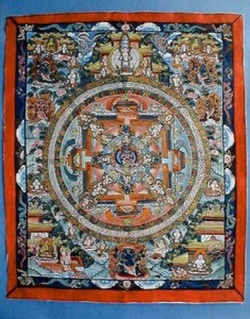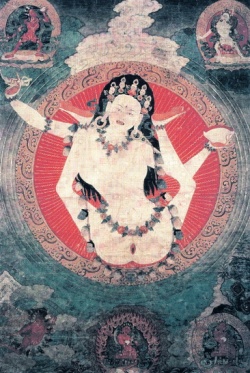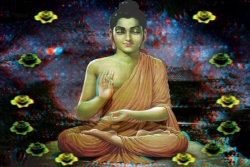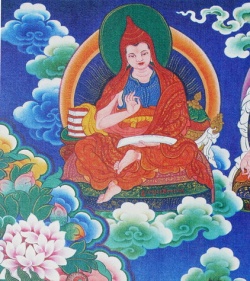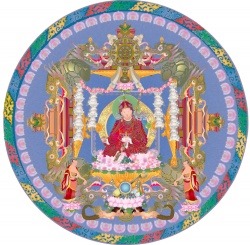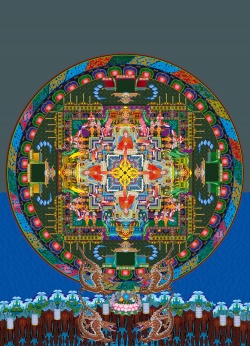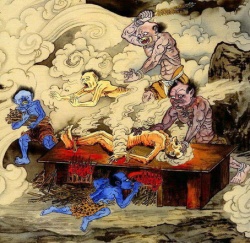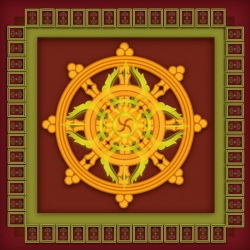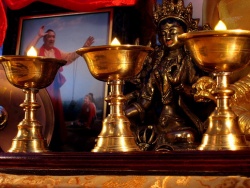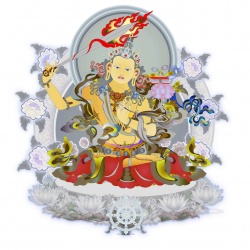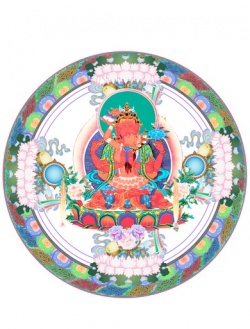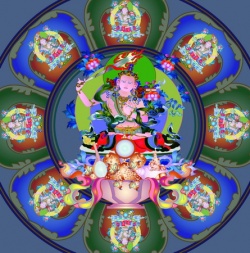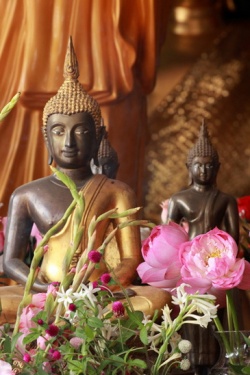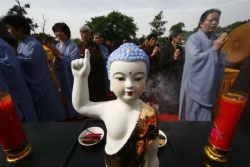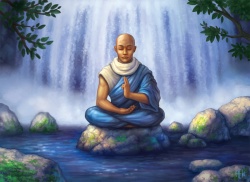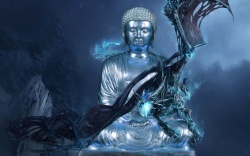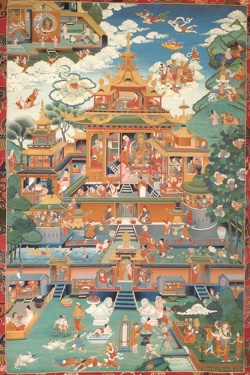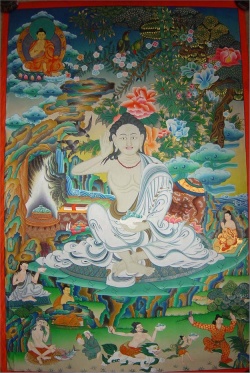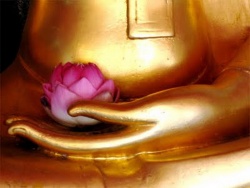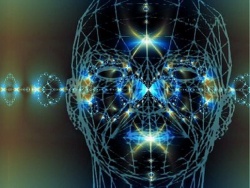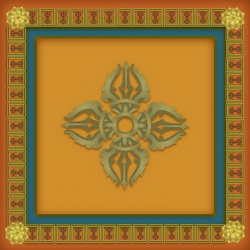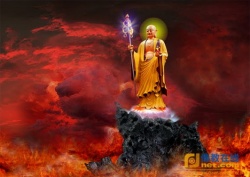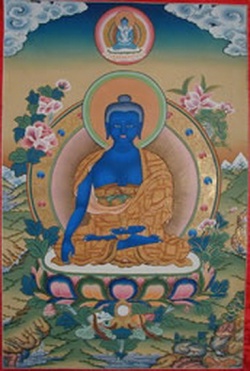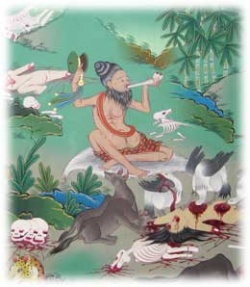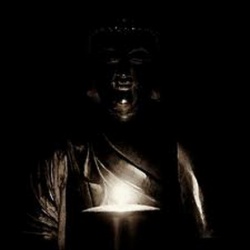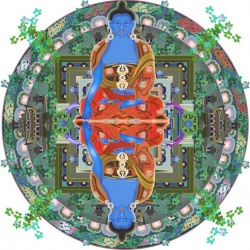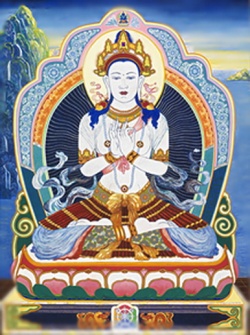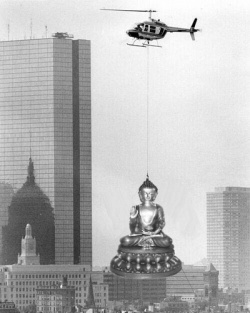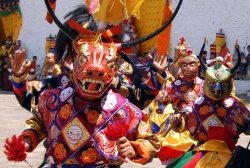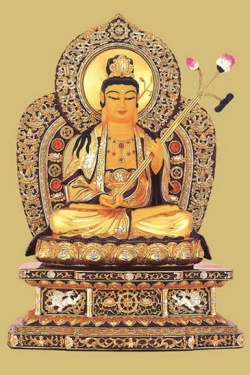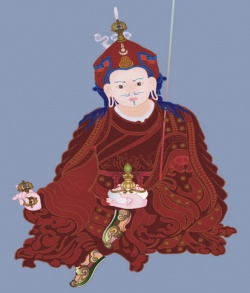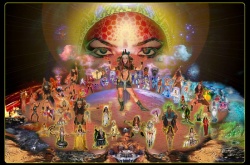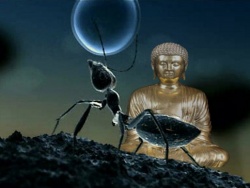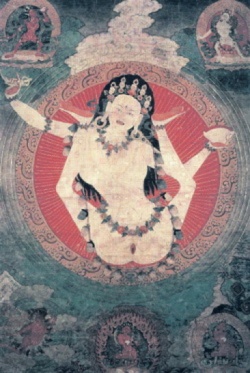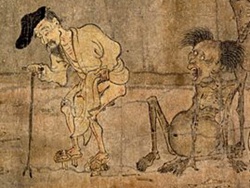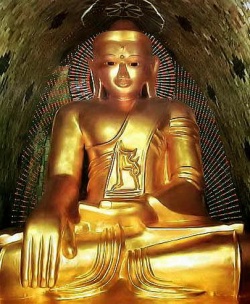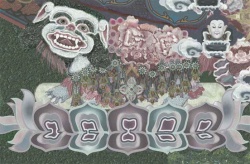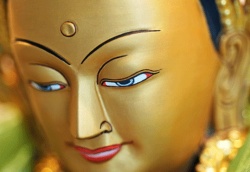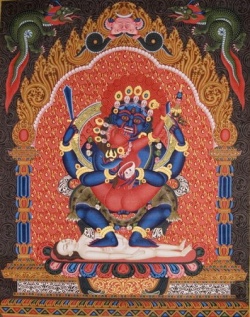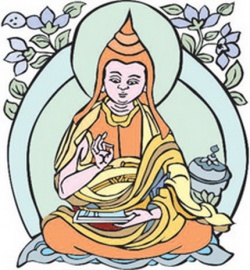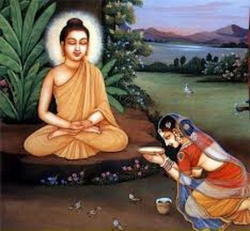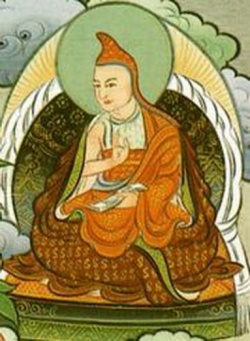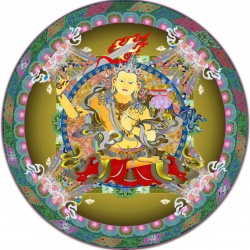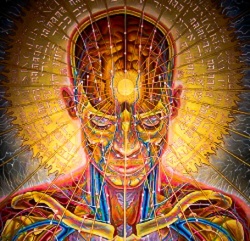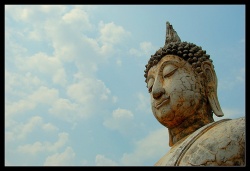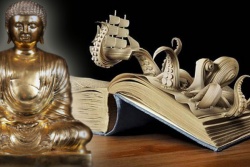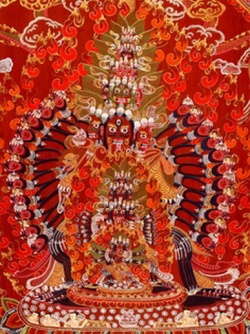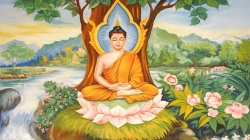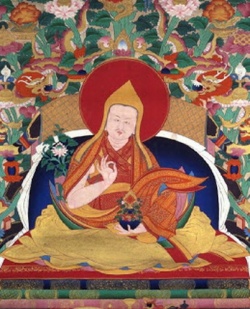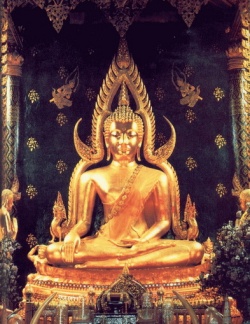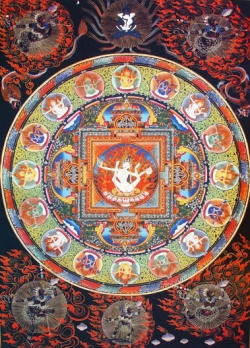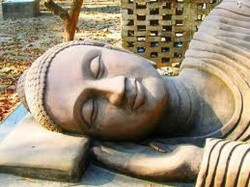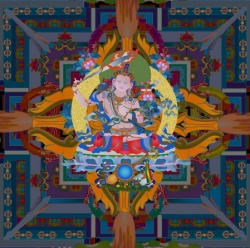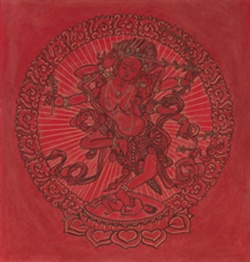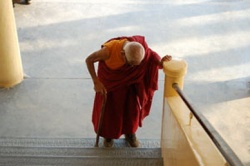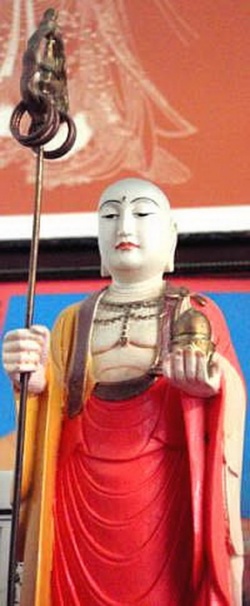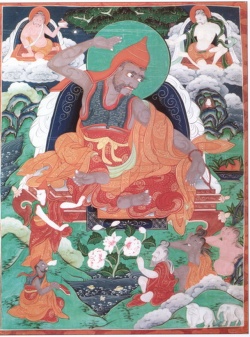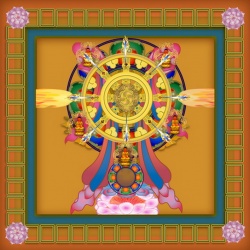The buddhist conception of omniscience
McMaster University
Lakshuman Pandey, M.A. (Banaras Hindu University) Shastri (Sanskrit University)
M.A. (MG~aster University)
Professor T.R.V. Murti
As its central purpose, the thesis outlines the Buddhist conception of human omniscience as developed by the philosophers of later Vijnanavada Buddhism, i.e., DharmakIrti, Prajnakaragupta ;- ,-
Santaraksita and Kamalasila. It attempts to show how those philosophers dialectically established the possibility of human omniscience and the omniscience of the Buddha.
The concept of human omniscience was introduced into Indian philosophy because of the religious controversies between Heterodox (Nastika) schools, such as Jainism and Buddhism, and Orthodox (Astika) schools, - , -- - -~ - - especially Nyaya-Vaise~ika, Sankhya-Yoga, Mimamsa and Vedanta. The Mlma~sakas began the argument with claims for the omniscience of the Vedas; the Naiyayikas followed with the attribution of omniscience to God. When the Buddhists, in turn, maintained the omniscience of the Buddha, the Mlma~sakas raised objections to the concept of human omniscience, the omniscience of the Buddha, of God, and of any human religious teacher.
In order to refute these objections and to assert once again the superiority of the Buddha and his teachings of Dharma, the later Buddhist philosophers sought to dialectically established the concept of human omniscience. The Buddhist argument was the product of constant interaction and debate with other Indian religious and philosophical schools, and it is clear that omniscience was and continues to be one of the pivotal topics for all schools of Indian philosophy. The Buddhists have used logical arguments to support the concept of human omniscience. They have established the omniscience of the Buddha using the logical methods of presumption and inference.
They have provided the answers . from the Buddhist point of view to the MImamsakas' objections against the concepts of human omniscience and the omniscience of the Buddha. The Buddhists maintain that an omniscient person perceives all objects of the world simultaneously in a single cognitive moment. They have also argued that only an omniscient person can teach Dharma. The aim of the Buddhists was to prove the superiority of Buddhism among all religions, because it is based on the teachings of an omniscient being. In brief, this thesis outlines the development of the concept of omniscience, which the Buddhists hold to be the necessary and sufficient condition for perception of supersensuous truths such as Dhatma. iii
ACKNOWLEDGEMENTS
It is with a very special sense of gratitude that the author acknowledges his Gur~ (teacher), Dr. T. R. V. Murti. To him alone is rendered sincere and differential gratitude for the kind encouragement t inspiration, direction, and supervision which led to the successful completion of this thesis. Professor Murti has been outstandingly generous, sympathetic and unfailing in his understanding of the time and effort which this research demanded. Every page and every line of this thesis represents the author's appreciation and gratitude for his Guru. The impact of his excellent guidance is felt everywhere but perhaps most of all in the area of personal fulfillment, for which the author is forever in his debt. Very sincere gratitude and appreciation are also expressed to Professor J. G. Arapura, Professor S. K. Sivaraman, Professor G. P. Grant, Professor Paul Younger, Professor L. I. Greenspan, Professor S. Ajzenstat, Professor A. E. Combs, Professor E. B. Heaven, and Professor P. C. Craigie.
The author would also like to offer his very sincere thanks and gratitude to Dr. E. P. Sanders, who was so generous with his time and advice.
Thanks are extended to McMaster University for awarding Graduate Teaching Fellowships which enabled the author to carryon his research.
A word of thanks to Mrs. Susan Phillips for her kind help in typing this thesis.
The substance of this dissertation consists of an examination in greater depth and more extensive scope of a topic which was examined in a preliminary way in the writer's M.A. thesis, The Buddha as an Omniscient Religious Teacher; that thesis was submitted to the Department of Religion, McMaster University, and accepted in 1969. TABLE OF CONTENTS
INTRODUCTION
In broad terms the purpose of this thesis is to present the logical proofs given in support of the omniscience (Sarvajnata) of the
- - Buddha by the later Buddhist philosophers: Dharmakirti, Prajnakaragupta Santaraksita and Kamalasila. These philosophers lived after the fifth century A.D. and their writings represent the last phase of Indian Vifnanavada Buddhism.
In Indian philosophy, logical argument was a commonly accepted method used to defend a religio-philosophical concept already accepted at the time. With this intention, the above named exponents of Buddhism have set forth logical evidence in order to establish the fact "that only the Buddha was an omniscient (Sarvajfia) religious teacher". Undoubtedly religious practices implying omniscience precede their actual conceptualization: but the concern here is not with the realization of omniscience, but with its rationalization. The main concern of this thesis will be to show that the Vijnanavadi Buddhist philosophers offer arguments that successfully answer the objections urged by the Mfmamsakas against the conception of human omniscience. In addition, we will also try to show that these Buddhist philosophers offer further arguments which establish the complete validity of this fundamental Buddhist tenet. Here they are not only philosophers or logicians but they are theologians defending the Buddhist tenets. In fact, the concept of omniscience is not only a philosophical and religious problem but also a theological problem. 1
The aim of these Buddhist philosophers is to prove the superiority of Buddhism among all religions, because it is based on the teachings of an omniscient teacher, that is, the Buddha, who is the only omniscient religious teacher according to them. By dialectical establishment of human omniscience and omniscience of the Buddha, these authors prove the authority and infa-libility of the Buddha and his teachings or Dharma. The Sanskrit word Sarvajna (Sarva meaning lI a1 1 11 and jua meaning "knower") is translated by the English as "omri.s ci ent " or "all-knowing" person. Here "Sarva" means all the existing things of the past, present and future. Thus, one who knows all the things of the universe either successively or simultaneously is called omniscient (SarvaJna). The Sanskrit words Sarvajna, Sarvasarvajna, Sarvakarajna, Sarv~karagrahi, ~~rvavit, Sarvasarvavit, Sarvavedl, Visvavedas, Visvavidvan, Visvacaksu, Visvadrasta are used as synonyms, meaning a person who knows everything. According to Paniniya Sanskrit grammar, he who knows everything is omn.lS.Clent (S arva.J~na) . 1 The Pali word Sabbannu and the Prakrta word
- - Kevalin are used for the omniscient person. In both Pali and Prakrta grammar, the meaning of the words Sabbannu and Kevalin, respectively, is similar to that of Paniniya Sanskrit grammar. The Sanskrit word Sarvajnata, the Pali word Sabbannuta-nana and the Prakrta word Kevala (Omniscience) mean to have the knowledge of each and every thing in the universe. However, the words Sarvajnata, Sabbannuta-nana and Kevala are translated into English by the word \arvam janatiti sarvajnah, ato'nupasarge kah , astadhyayi 3,2,3. 3
"oumt.scf.ence" or "all embracing knowledge". The concept of omniscience (sarvajnata) can be conceived from two points of view. From the objective point of view, "omrri.acLence" means knowing everything numerically and quantitatively. From the qualitative point of view, the word "omniscience" means to have the knowledge of the epitome of everything. This type of knowledge reveals two kinds of meaning: first, knowledge of Reality (tattvaJnata) and second, knowledge of Dharma (dharmajnata) In Indian philosophy the word Sarvajna has been nsed in a special sense to mean a person possessing the knowledge of supersensuous truths such as Dharma, heaven (svarga) and liberation (moksa), apart from the knowledge of the sensuous objects of the world. In other words, the omniscient person is the knower of reality (t at tvajfia) ,
To establish its o,vn authority, each school of Indian philosophy has developed a different concept of omniscience, and has used this word with a slightly different connotation. The School of Carvaka does not hold the possibility of omniscience. The School of Mimamsa maintains that the Vedas are omniscient, but that no being can be omniscient. The School of Nyayavai~esika Se£vara-Samkhya and Yoga maintain the omniscience of God. The School of Advaita Vedanta holds the omniscience of God as well as the omniscience of man. Although they do not believe the authority of the Vedas, or of God, or Prakrti, the Buddhists and Jainas hold that only a human being can become omniscient. The Buddhists hold that omniscience (sarvajnata) depends upon the full knowledge of all things, sensuous and supersensuous. According to the Buddhists, this follows from the removw_ of the hindrance of 4
affliction (kle§avarana) and hindrance of cognisable things (j"neyavarana). The Buddhists hold that that person alone is omniscient who knows the whole world in its real form of "soullessness" (anatmavada). They further assert that only the Buddha, not the other teachers, fulfills all the conditions of this definition. Therefore, he has been placed above all other religious teachers by the Buddhists. It seems that the concept of omniscience arose in Indian thought because of the desire to describe supersensuous realities such as Dharma, God, the self, heaven and liberation, etc. These supersensuous realities are commonly accepted by Indian religious traditions. They cannot be verified, however, by normal human perceptions. Consequently, the question arises as to whether anybody can have a direct vision of Dharma and other supersensuous truths. The limit of human knowledge arouses a desire to have an unlimited knowledge. Is this possible? This recurring problem in Indian metaphysical thinking has drawn the attention of Indian thinkers to the concept of Omniscience. Every understanding of religious authority is associated in some way with the concept of Omniscience and this has become a major matter of discussion in Indian philosophy.
It is the unique characteristic of Indian philosophy that it lays so much emphasis on the nature and limitation of knowledge. When all the limitations of knowledge are removed, the state of omniscience is achieved. In other words, omniscience is the culmination of knowledge. Indian thought generally takes the position that the limitations of knowledge can be removed and that one can acquire the knowledge of supersensuous realities. lihen the veil covering the knowledge is removed, 5
the knowledge of each and every thing of the universe can shine forth in the person's intellect. The intellect can reflect these objects like a mirror. This knowing in its most perfect form is called omniscience. Although every system of Indian philosophy deals with the concept of omniscience, Buddhism, Jainism and Mimamsa have dealt with it in greater detail.
In Indian thought Dharma is derived from two sources: first, the divine sources (like gods, God and the Vedas); second, human sources (like the Buddha and Mahavira). Divine sources are already attributed the concept of Omniscience. That is to say, all-knowingness is the very nature of divinity. Consequently, the Dharma can be revealed through divine sources. But, here the question arises whether the Dharma can be revealed by a human being. This is possible if a human being can become Omniscient. Although at first glance one might feel that this was an untenable position, Indian philosophy does not take that attitude since it refuses to accept that there is ultimately a distinction between man's most basic nature and divinity itself. Indian thought accepts the possibility of enlightenment by means of spiritual discipline (yoga). This enlightenment is the self-realization of the divIne character of man. A person who becomes enlightened also removes the hindrance which lies in the way of the acquisition of knowledge. Thus every enlightened person necessarily becomes omniscient. The enlightened person is fully entitled to reveal Dharma because Omniscience involves a revelation of Dharma.
Now the question is whether a supersensuous reality, like Dharma, can be directly perceived or not. The Carvaka and Mfmamsa hold 6
that Dharma cannot be perceived by any being. They do not believe in any omniscient being or a knower of Dharma. All other systems of Indiml philosophy believe in the direct intuitive realization of Dharma. They believe in the exist.ence of omniscient beings, either divine or human, as the perceivers of Dharma. Invariably every religious teacher has been declared the knower of highest truth or the secrets of Dharma because of his omniscience.
It is hard to trace when this concept; of omniscience appeared as a conscious religio-philosophical problem in Indian thought. It is also hard to say whether human omniscience came first, because every enlightened person was considered to be omniscient, or whether divine omniscience came first, because some gods of the Veda~ were attributed with omniscience, or whether God himself was conceived to be omniscient by the school of Nyaya Vai~e?ika, Se§vara- Sankhya, Yoga and Vedanta. It is evident from the Vedas that Indian thought has accepted the concept of human omniscience since the very beginning. Because the concept of human omniscience is prominent or popular from the very beginning of Indian thought, one might get the idea that human omniscience was introduced to Indiffil thought first and later on this idea gave rise to divine omniscience and gradually God, gods, and the Vedas were all accepted as omniscient. This view would seem to be supported by the Vedas themselves because the concept of human omniscience can be found there in that the Rsis (or seers) of the Vedas are thought of as omniscient.
Sankya Yoga, Nyaya. Vai.Ise.sika, Jainism and Buddhism each claim that their system was founded by an omniscient person. However, we do not agree with the view that human omniscience arose first in 7
Indian thought. We put the Vedas prior to any philosophical system of India. In the Vedas, the gods are thought of as omniscient and they in turn have the capacity to make people omniscient R..sis. Therefore we conclude that the concept of divine omniscience was developed first in Indian thought and it gradually gave rise to the concept of human omniscience.
Was the concept of human omniscience developed because of its attribution to God or the Vedas, or was the concept attributed to God or the Vedas because an enlightened person was thought to be omniscient? Or was this concept attributed to God, the Vedas and man simultaneously? These questions do not pertain particularly to the subject of this thesis.
It seems that this concept of human omniscience was first introduced into Indian thought as a philosophical concept because of the religious controversies among Heterodox (Nastika) Schools, specifically Jainism and Buddhism, and Orthodox (Astika) Schools, specifically
- I - - -- - --- Nyaya-Vaisesika, Sarikhya-Yoga , Purva-Hlrnafos a and Ut.t aram.lmarhs a , The religious teachers of some of the Nastika schools were claimed omniscient for themselves in order to prove the validity of their teachings. The Astika Schools had already accepted the omniscient authority of some supersensuous and super-human realities like God or the Vedas as proof of the validity of their religious teachings. But those who were not the followers of this tradition had to prove their o,vn religious authority by attributing omniscience to their religious teachers. Thus the concept of human omniscience came into philosophy as a reaction against the concept of divine omniscience attributed to the gods, God 8
or the Vedas.
In the period following the sixth century B.C. (that is, the time of the Buddha and Mahavira) there was a greal deal of discussion among Indian philosophers on the concept of human omniscience. Because the Buddha and Mahavira were considered to be omniscient teachers by their respective followers, a discussion ar08~ as to whether or not a person can be omniscient. As a result of this discussion, two main streams of thought have emerged concerning human omniscience. According to one position, that is, the Caravaka and Mimamsa, an omniscient person is an impossibility; to the other, that is, the school of the Nyaya-Vaiesika, Sankhya-Yoga, Advaita Vedanta, Buddhism and Jainism, omniscience can be achieved by a human being. From the time of the Buddha and onward, the concept of omniscience began to be used in Indian religious and philosophical systems in order to establish the omniscient authority of the Dharma. Whether or not this religious authority was a person or the Vedas or God, it was essential that the authority be considered omniscient. It was felt that only in this way was it possible to have the true Dharma, because an omniscient authority knows the true nature of everything, sensuous and supersensuous. Only the true Dharma, if followed properly, can fulfill the real purpose of life by leading the people to prosperity in this life and to the highest good or liberation after life. Thus the concept of omniscience was accepted as an essential part of the religio-philosophical discussions in the history of Indian thought, and every religious teacher or authority was necessarily considered to be omniscient.
9
Although the concept of omniscience was propounded in the sixth century B.C., it did not become prominent as a subject of philosophical debate and controversy until the second century A.D. The catalysts for this controversy were the numerous speculations on the true nature of Dharma by every school of Indian philosophy. They all agreed that the true nature of Dharma should be revealed by an omniscient authority. So the controversy over Dharma, its real nature, its revealer or teacher, led to the co-relative controversy over omniscience in the second century at the time of Jaimini the Mimamsaka. He was prompted to inquire into the true nature of Dharma, against Vadarayana the Uttaramimamsaka who desired to know the true nature of Brahman. This led naturally to the desire to define the true nature of omniscience. The concept of omniscience became a burning problem in Indian thought in the seventh century mainly because of the controversy regarding the concept of Dharma among Mimamsa, Jainism and Buddhist schools. The school of Mimamsa did not accept the possibility of omniscience in any human being and rejected this concept through various modes of argument. To refute the arguments of Mimamsa and to establish the concept of omniscience in general, and omniscience in particular (that is, human omniscience), the heterodox schools of Jainism and Buddhism dialectically established the concept of human omniscience. This concept of omniscience became very popular in religious and philosophical discussions of Indian thought; when Kwnarila tried to refute this concept of omniscience in any being and established the fact that Dharma can be known only through the omniscient Vedas, this concept became a matter for dispute among the other systems of Indian 10
thought. The Jains and the Buddhists became the main opponents of Mfmamsa on this issue and argued for the possibility of human omniscience. In fact they refuted the possibility of divine omniscience by rejecting the omniscience of gods, God, and the Vedas, but they did establish the concept of human omniscience. They emphasized th~t Qn1y a human being can be omniscient. They did this because they wanted to prove the validity and superiority of their own religion by proving that their religion was founded by an omniscient religious teacher. The omniscient knows the true nature of everything, sensuous or supersensuous. Therefore he cannot misguide people while teaching supersensuous realities like Dharma, heaven, hell, soul, rebirth, liberation, etc.
Early Buddhism does not lay emphasis on the omniscience of Buddha, yet still it asserts him as the knower of Dharma. However, the Mahayana Buddhist regards Buddha as the omniscient one and because of his all-knowingness he has been declared as the authority of Dharma. In the earliest Pali Nikayas the Buddha has not explicitly declared himself as the omniscient religious teacher nor has he been regarded by his disciples as an all-knowing religious teacher. In fact, Buddha did not like to involve himself in metaphysical discussions because his aim was confined to revealing the Dharma. He kept himself aloof from answering the fourteen unspeakable questions (avyakrta-pra~na). In the seventh century, A. D. Kumarila rejected the idea of a being (human or divine) as the knower of Dharma and tried to establish the authority of the Vedas for knowing Dharma. After that time it became essential for the Buddhist philosophers to counter the arguments of 11
Kumarila in order to establish the authority of the Buddha as a religious teacher. Dharmakfrti holds that Dharma can be perceived by a being directly, therefore a being can be the knower of the Dharma. Thus, by various modes of argument, he has established the authority of the Buddha as the only authoritative religious teacher in order to put Buddhism on at least an equal footing with other religious systems of India.
The omniscience of the Buddha is emphasized and elaborated mainly .<;>/- - by the Vijnanavad Buddhist philosophers, beginning about the fifth century A.D. The fifth century A.D. was the beginning of the golden period of Indian philosophy. Here we find a tripartite struggle between the Mfmarnsa, Nyaya and Buddhist schools. This tripartite struggle was originally started by Dinnaga, the father of medieval logic in India. He criticized the Nyaya-Sutra of Ak,sapada Gautama and its co~nentary Dignaga by the celebrity he won in disputations has been one of the most powerful propagators of Buddhism. He is credited with having achieved the "conquest of the wo r l.d , "* Just as a universal monarch brings under his sway all India, so is the successful winner of disputations the propagator of his creed over the whole of the continent of India. Cashmere seems to have been the only part of India where he has not been, but he was visited by representatives of that country who later on founded schools there. These schools carried on the study of his works and produced several celebrated logicians. 2 Dinnaga felt that the charges levelled by the school of ~timamsa and Nyaya against the Buddhist doctrines could not be disproved 2Th• Stcherbatsky, Buddhist Logic, Vol. I, "Introduction", p. 34. *Footnote No. I in original source. dig-vijaya. 12
without accepting a new form of logic. This new logic would enable Buddhism to be on an equal footing theologically, philosophically and religiously with the other Indian traditions. This was most essential since Buddhism until this time was devoid of an adequate framework in which to interpret the tradition of the Buddha. Dinnaga, however, gave a new definition of logic on the basis of Buddhist philosophy and from this standpoint he criticized the views of others and set forth a new logical proof of Buddhist doctrines: The Buddhist philosopher Dinnaga (c. 425 A.D.) may be regarded as the founder of the school of pure logic in Buddhism•.•. It is interesting to note that in the
hands of Dinnaga, Nyaya becomes a pure
science of 10gic.•.. With Dinnaga, as with other logicia~s of the Medieval School, the utility of Nyaya primarily lay in its being a means of defence and attack in the philosophical controversies that were then raging
in the country. He tries his best to demolish the position of Vatsyayana, the commentator of the Nyaya-sutras. Udzotakara (c. 550 A.D.) came forward to defend Vatsyayana against Dinnaga.
The task of defending Dinnaga against
Udyotakara was undertaken by DharmakIrti, (c. 600 A.D.) pupil's pupil of Dinnaga .••. DharmakIrti also criticizes the views of Dhartrhari and Kumarila as well. DharmakIrti in his turn is criticized by Vyomasiva, Akalanka, Haribhadra and Hayanta. 3
Eventually the Jaina, Sankhya-Yoga, MImamsa and Nyaya Schools also adopted their own logical methods to support their doctrines and criticize those of others. Uddyotakara, a propagator of the Nyaya 3A. S. Altekar, Introduction to the Pramanavartikabhashyam (ed. by Rahula Sankrtyayana, Banaras, 1953), pp. 6-7. 13
School, in his book Nyaya-Vartika, has tried to refute the arguments of Dinnaga against the Nyaya doctrines. God, he holds, is the basis of Dharma because He is the only omniscient supreme being. He has proved the sale omniscience of God on the basis of His function as creator of the whole universe. Only a being who is the creator of the universe can be omniscient. It is) therefore, impossible for any human being like the Buddha or Vardhamana Mahavfra to be the omniscient religious teacher.
To answer the objections of Uddyotakara, the Naiyayika and the Mfmamsakas and to re-establish the Buddhist doctrines, Dharmakfrti wrote the Pramana-Vartika. His criticism was answered by Vacaspati Misra in his book Nyaya-Vartike-Tatparya-Tfka. Dharmakirti also criticized vigorously the doctrine of the Mimarnsakas. His criticism
- I - was answered by Kumarila in his book Slokavartika. In order to reestablish the doctrine of Mfmamsa he severely attacked the Buddhist doctrines and attempted to prove the authority of the Vedas. He holds that only the Vedas can be omniscient and an omniscient being, whether a human being or a god, is an impossibility. According to him, the non-omniscient teachers like the Buddha or Vardhamana should not be accepted as authority for Dharma.
Thus the schools of Mfmamsa and Nyaya challenged the religious authority of Buddhism by seeking to disprove the omniscience of any human being. On this basis the Buddha's teachings regarding Dharma were not accepted as authoritative by them and were seen as misleading. The attack of Kumarila, Uddyotakara and Vacaspati Misra on the doctrines of Buddhism, and their refutation of the omniscience of the Buddha, 14
shook the position of Buddhism as a religion and it became difficult for people to have faith in the teachings of the Buddha . ... Buddhism in India was doomed. The most talented propagandist could not change the run of history. The time of Kumarila and Sankara-acarya, the great champions of brahmanical revival and opponents of Buddhism, was approaching .... What might have been the deeper causes of the decline of Buddhism in India proper and its survival in the border lands, we never perhaps will sufficiently know, but historians are unanimous in tel!ing us that Buddhism at the time of Dharmakirti was not on the ascendency, it was not flourishing in the same degree as at the time of the brothers Asanga and Vasubandhu. The popular masses begffil to return their face from that philosophic, critical and pessimistic religion, and reverted to the worship of the great brahmin gods ...•
Dharmakfrti seems to have had a foreboding of the ill fate of his religion in India. He was also grieved by the absence of pupils who could fully understand his system and to whom the continuation of his work could have been entrusted.
Just as Dignaga had no famous pupil, but his continuator emerged a generation later, so was it that Dharmakirti's real continuator emerged a generation later. 4
The Buddhist philosophers of the age felt the need to answer this challenge by establishing the Buddha as the only omniscient religious teacher in order to prove that Buddhism was as valid as the Vedic tradition, if not superior. They have tried to prove that only a human being could be OlIDliscient, not the Vedas or God. They also tried to demonstrate that among human beings who have been acclaimed as omniscient religious teachers only the Buddha is omniscient because his teachings have not been disproved by any valid means of cognition. 4TIl. Stcherbatsky, op. cit., p. 35.
15
They have used logical arguments to support the omniscience of the Buddha so that they could prove that Buddhism was the only true Dharma, since only Buddhism has been taught by an omniscient religious teacher. Dinnaga paved the way for development of the Buddhist proofs for the omniscience of the Buddha by providing the logical structure.
- r-:»: --
The later Sautrantika ViJnanavadi Buddhists adopted this dialectical method in discussing the omniscience of the Buddha. We should, however, remember that the logicians of the age had cultivated a purely rational outlook to a great extent. Dinnaga was no doubt held in high esteem by the Buddhists but this did not prevent Dharmakirti, his vartikakara, from dissenting fr~m him and maintaining that the example, or Udaharana, cannot form part of syllogism. The very emergence of vartika as a form of literature is a clear proof that rationalism was fairly well developed in the period; the vartikakaras wer e no doubt conunenting upon earlier works .... 5
Dharmakirti, however, has not rested his case on the omniscience of the Buddha, because he felt that the omniscience of any person cannot be examined by any empirical criterion. But he maintains that the Buddha is a reliable guide to Dharma, because he possesses true know- <V- - 6
ledge (jnanavan).
This is much more so because the whole chapter on the validity of knowledge is supposed to contain only a comment upon the initial stanza of Dignaga's work. This stanza contains a salutation to Buddha who along with the usual titles is here given the title of "Embodied Log!c~ (pramana-bh~ta).* The whole of
Mahayanistic Buddho1ogy, all the proofs of 5
A. S. Altekar, ~. cit., p , 7.
6 - - Prama~a-Vartika (edited by Rahul Saw<rityayana, Patna, 1938), II, pp. 145-146.
16
the existence of an absolute, Omniscient Being are discussed under that head.
We would naturally expect the work to begin with this chapter upon the validity of knowledge and the existence of an Omniscient Being .•.•A further notable fact is that the chapter on Buddhology, the religious part, is not only dropped in all the other treaties, but
Dharmakirti most emphatically and clearly expresses his opinion to the effect that the
absolute omniscient Buddha is a metaphysical entity, something beyond time, space and experience, and that therefore, our logical knowledge being limited to experience, we can neither think nor speak out anything definite about him,** we can neither assert nor deny his existence. 7
The omniscience of the Buddha was most convincingly demonstrated '-'- - in the last phase of Indian Vijnanavada Buddhism. Th. Stcherbatsky names it "The Third or Religious School of Commentators".8 The philosophers of this school have followed the logical tradition of Dinnaga and Dharmakirti in proving the validity of knowledge. In this connection they have logically established the concept of human omniscience as well as the omniscience of the Buddha. Prajtiakaragupta in Pramanavartika-Bhasyam (or Vartikalankarah), 1- 1 Santaraksita in his Tattvasangraha and Kamalasila in his Panjika have gone further than Dinnaga and Dharmakirti and have dialectically established the concept of human omniscience and the omniscience of the 7Th• Stcherbatsky, EE-' cit.,
while answering the objections of Vacaspatimisra and Kumarila. These Buddhist philosophers have accepted the possibility of human onmiscience and have maintained through various modes of logical argument that only the Buddha and no other religious teacher is omniscient, because his teachings of Dharma have not been disproved by the accepted valid means of cognition (pramana). By holding the concept of human omniscience and the omniscience of the Buddha, the Buddhists do not mean that the omniscient person should know all the objects of the world. Their primary aim is to prove that the Buddha has the knowledge of supersensuous truths and his teaching of Dharma is the means of attaining heaven and liberation. The knowledge of the Buddha is not hampered by obstacles because he is omniscient. The Buddhists dialectically establish the concept of human omniscience in order to prove the existence of a person who knows Dharma which is the means leading to heaven and freedom. 9 Their main aim is to prove that the authority for Dharma is the teachings of an omniscient teacher and only the Buddha is an omniscient religious teacher.
9Svargapavargasamprapti hetujno'sttti gamyate; Saksanna kevalam kintu sarvajno'pi pratiyate. Tattvasangraha (ed. by Pt. K. Krishnamacharya, Gai Baroda, 1926), Verse 3309.
CHAPTER I
THE CONCEPTION OF OMNISCIENCE IN THE VEDIC TRADITION
In this chapter we will attempt to trace the concept of omniscience in all of its multiple permutations throughout the Vedic tradition (viz. the Vedas, the Upani9ads, the schools of Vedanta, Sankhya, yoga, and Nyaya-Vai~e~ika). This is a necessary preliminary to enable one to understand the contrasting theories of omniscience in Buddhism and Jainism.
The Conception of Omniscience in the Vedas The concept of omniscience can be traced in the Vedas themselves. Many Vedic gods are conceived as omniscient. Although there is no mention of the word Sarvajna (omniscient), the other Sanskrit synonyms for omniscience are mentioned. The Sanskrit words with similar meanings are: Vi&vavit,l Vi~va-Vedas,2 Vi~va-Vidv~n~,3 Sarvavit,4 Vi~va-Chakshu,5 and Visva Drasta. 6 , , Such Vedic words have the implicit sense of the word omniscience. 1Rg. Veda, 19, 91, 31; Atharva Veda 1, 13, 4. ~igvedasamhita, with corny: of SNyana by F. M. MUller (London, 1892). 2Rg. Veda, 1, 21, l', Sarna Veda, 1, 1, 3. 3 Veda, 9, 4, 85, 10, 122, 2. ~g.
That is why the Vedic gods are sometimes referred 19
Both divine omniscience and human omniscience are found in the Vedas. The Vedas also ascribe omniscience to persons with supersensuous knowledge and supernatural power. It is evident from the Vedas themselves that the comprehension of supersensuous realities is possible; that is to say, a person can perceive or hear supersenuous truths like Dharma because of his omniscience.
A person with omniscience is called ~~i, one who has the intuitive realization of reality. The Vedic Gods are inspired sages (kavip). They too are ascribed with omniscience. The Vedic gods are beings enclawed with superSenSllQUS cognition. Themselves 8uperconscient, they have power to make others omniscient. In the Rg. Veda there is a description of the long-haired deities who are said to promote the vision of the Rsis. 7
to as the makers of Rsis (Rsikrt).
omniscient.
The gods Soma8 and Agni9 are called
The difference between a god and a -R.-s.-i is one of degree and not in the kind of power of omniscience. 10 Like Vedic gods, the R..sis also have the possibility of acquiring visionary knowledge of truth. The Vedic R..sis have knowledge of supersensuous truths. The 7Rg. Veda, 1, 164, 44.
knowledge ascribed to the -R.s.i-s is not discursive, nor ratiocinative, but has the nature of full-blo\Vll intuition. In the ~g. Veda the god Agni is considered to be omnipresent in the universe, in the sky, earth and waters. 11 He is also known as omn.lS.Clent (VvtlsIvavedas) . 12 He is also called thousand-eyed (Sahasr-aksa). 13 Furthermore, Agni is called the poet (Kavih). 14 He is also a mediator between man and gods,15 a Rsi inspired with vision. 16 -.-.- Agni is considered an omniscient god like Varuna. Varu~a is the omniscient god par excellence and Agni is both omnipresent and omniscient. 17 Agni has visional~ insight or omniscience. His omniscience is especially marked in the office of hot ar ,18 Agni has been also considered a divine being who promotes inspired thought and pro- vides omniscience to man. 19
Surya
Not only Agni but also the Surya is ascribed with the power of omniscience (vi£vacaksas) ,20 and "of wide vision" (urucaksas). 21 Sun is the eye of Mitra and Varuna. 22 He is also the eye of Heaven. 23 Varuna
The god Varuna is attributed with the power of omniscience. Varmla, the Orruliscient, sees all and makes revelations. 24
Varuna is
the upholder of the moral law (rta dhrta). He sits high above Gods and perceives all things. He governs the whole universe morally. Soma
The god Soma is all-knower (vi~vavid). He is the controller of the mind (Manasa Patih)25 and is endowed with a thousand eyes. 26 He has imnlediate insight into the nature of all things and is king of all worlds. 27
Vayu and Maruts
The wind god Vayu is omniscient like Agni and Varuna. His omniscience depends upon sight. Like Indra, Varuna and Agni, Vayu also has a thousand eyes. 28 In so far as Vayu goes everywhere and sees all things, he is omniscient as well.
In the Rg. Veda Dyayus (sky) is associated with Prithvi (earth), and is addressed as Dyavaprthivi (sky-earth). He is credited with ornn•lS•Clence ( V•lsI vavedas) . 29 Indra
Veda.
The god Indra is perhaps the most important deity of the ~. He is the all-perceiving god with manifold eyes (Sahasr-ak:a). 30 TI1US in the Vedas the concept of omniscience is a faculty of knowing which brings the intellect into intimate contact with every thing sensuous and supersenuous) the supersensuous reali~ies. Omniscience is not an attribute of all Vedic gods in general, but is specially an attribute of the sky gods and the gods who are connected with the heavenly realms of light. The Vedic gods are omniscient because their nature is self-luminous.
idea of self-realization of Brahman. The Upani~ads, however, do not give a comprehensive and elaborate account of the concept of omniscience. But they ma.lntalT. I t h at he Wh0 knows t he se lf , knows everythl.Ug. 31 The main stress is on the attainment of the knowledge of Atman (self). Thus, in the Upani~ads sarvajna means Atmajna (knower of the self). The word sarvaj~a is not used in the Vedas but it is frequently used in the Upanisads in the sense of Omniscience. The Conception of Onmiscience in the Advaita Vedanta Advaita Vedanta accepts the concept of human omniscience. By its nature, a jiva is not omniscient, but through spiritual discipline it can reach the state of omniscience which is penultimate to liberation. According to Sankara, omniscience should not be attributed to a liberated soul or Brahman. 32 However, he accepts that supernatural qualities like omniscience can be achieved by a person in the course of spiritual development by yoga. The supernatural qualities of Sagu~a Brahman, like omniscience, etc., can be achieved by a man (Saguua vidyavipaka sthanantvetat). Suresvara, in the commentary on Taittirlya Upani~ad, says that a human being can share in omniscience only through a relation with the divine, for omniscience is a divine quality and only God is omniscient and omnipotent. God's knowledge, like that of the yogi, is immediate. 33 31Yah Atmavid Sah Sarvavid, "Brhadaranyaka, Upani~ads, 4.5.6. 32 - - -
Sariraka-Bhasya (ed. by N. L. Shastri, Nirnaya Sagar Press, Bombay, 1927), 4,/f.6: . "Sarvajnatvam Sar've s va r a t varn ca .... na caitanyavat Svarupatva sambhavah".
The school of Advaita Vedanta maintains that the Saguna Brahman, who is the cause of the empirical world, is omniscient. 34
The liberated soul is not considered omniscient in Advaita Vedanta. Pure consciousness is the very nature of the soul. Neither bondage nor liberation of the soul is real; both are due to illusion. Only from an empirical standpoint is it said that a soul becomes free from bondage and becomes omniscient. However, in the state of liberation the soul becomes absolute non-dual consciousness. In this state the soul becomes pure consciousness and does not remain a knower. There is no otherness and there is nothing besides Brahman; therefore, it cannot know anything else but Brahman. The consciousness of outside objects is only due to ignorance, but in this state ignorance is completely annihilated. There is no object outside of it, so the liberated soul can know only itself. Consequently, Advaita Vedanta maintains that omniscience is not possible in the state of liberation.
Different Theories of Omniscience in the Advaita Vedanta The book Lights on Vedanta provides a detailed account of the concept of omniscience in the Advaita Vedanta. My interpretation of the concept of omniscience in Advaita Vedanta is based on this book. 35 34S-ar-iraka-Bh-asya, 2, 1, 14.
\~lereas the individual self is credited only with a limited knowledge, the Atman is credited with omniscience. Although Avidya is said to obscure the true nature of Atman and it projects the jiva, this obscuration does not alter the essential nature of the Atman which is described as both omniscient and omnipotent. These obscurations or limitations (kancuk) are four in number (kala, aVidya, raga, niyati). But the Advaitins emphasize the two primary limitations of the jiva, its limited knowledge, its limited power. The cognition of the jiva is restricted spatially, temporally, objectively, and can be divided into two categories: direct and indirect cognition. The immediate cognition of the jiva is dependent upon its various faculties or psychoses (vrtti); this is not the case with the Atman which is not dependent upon any faculty or vrtti. Rather, its omniscience operates without reference to any natural faculty (vrtti) of the jiva. The Advaitins have two theories concerning omniscience: one attributes omniscience to Atman itself which is pure consciousness and the other emanation or reflection of consciousness into the intellect (buddhi) which is a modification of mayi. - --
Bharatitirtha asserts that the Atman as consciousness, which is connected with its adjunct (upadhi) maya, contains the traces of all buddhis as their unchanging source and is capable of comprehending all their processes and content. The author of Praka.tartha also· upholds this second theory of omniscience and points to a parallelism between the cognition of the jlva via its adjunct (upadhi) antahkarara or mind and the omniscience of the Atman via its adjunct maya. In the former the cognition is nevertheless dependent upon i.ts psychoses or vrtti and arises only 26
with reference to external objects in the latter. The whole phenomenal world is upheld and transformed by virtue of maya, the adjunct of Atman. The buddhi or the reflection of the Atman as Cit operates in both cases, although it operates in an unlimited manner only in the latter.
~- Jnanaghana Pada, the author of Tattva-Suddhi establishes the omniscience of the Atman with respect to both future and past times and compares it to the memory of the jiva. Even before the emanation of the universe ~aya, because of the invisible powers (adrsta) of jivas, is changed into the prior apprehensions of all objects which are only later manifested. Brahman is the witness (saksi) of this transformation and indirectly acts as an agent for this transformation. So Brahman as Atman, reflected in the most subtle transformation of maya buddhi, has a prior knowledge of the whole phenomenal world. Just as past objects are cognized by recollection, so the total corpus of past phenomena can be cognized by the Atman by means of this creative association with maya and buddhi. We must distinguish between two classes of Vrtti. The first class or the Primordial Vrtti should be distinguished from the natural Vrtti which is diverse, discrete and empirically conditioned. The Primordial V:tti is all-encompassing and unlimited and immune from the limitations of empirical cognition. This Primordial Vrtti is the transformation of maya in situ and is associated with Atman as Cit (Cidan~a) and, together with the Sadansa (Truth-aspect), initiates the evolution of samsara, whereas the empirical Vrtti is the transformation of the mind, the necessary changes having been made, and it 27
acts together with the perceptive consciousness, Pramata or the jiva. This theory is critically scrutinized by Ramadvaya, the author of Vedanta-Kaumudi, who condemned this model of omniscience as unsatisfactory. Omniscience, being unconditioned and unlimited by nature, should not be described as conditioned by this Primordial Vrtti (or cognition through psychosis) and as reducible to a mere reflection of Atman in the buddhi. If it is so conditioned then instead of being unchanging and indestructible it would have to be described as destructible, as this Primordial Vrtti is subject to the same law of extinction as the gross elements. Such conditioning would then be transferred to omniscience itself, particularly to the omniscient Brahman as pure Consciousness (Cit). In this hypothetical situation, omniscience itself would perish which would paralyze the creative power of Brahman both with respect to its first transformation as maya, and also with respect to the gross elements preceded by iksana. Rather, he maintains that omniscience is the very nature of Brahman as pure Cit and is inherently capable of cognizing all that is created or manifested. It is capable of observing all that has been created or will be created in a spontaneous and unrestricted manner.
This is possible because the impressions of all things are preserved in maya like an unfinished picture. Thus to know maya completely through omniscience would entail knowing these impressions. Thus we can isolate three schools within Advaita. The Vivarana School maintains that the omniscient Atman can perceive the present object, through direct perception, the past object through memory and the future object through inference. Vacaspati repudiates both this 28
theory of omniscience associated with impressions or reflections, and the theory of omniscience which is associated with the Vrtti of maya. He maintains that omniscience is possible because of the selfconsciousness of Brahman 'Svar~pa Caitanya'. Consciousness cannot be described as any empirical product as it is one of the essential definitions of Brahman (Brahman as Cit). But consciousness, when linked to the perception of a particular object, is accomplished by Brahman. Thus the Atman is omniscient by nature, as all its objects of knowing are products of Brahman.
The third view is that of Suresvara who advocates a completely new theory which focuses on the necessity for I£vara to explain the possibility of omniscience. This explanation is dependent upon his Abhasa theory. All appearances of Brahman are possible only through the mediation of aVidya; specifically through the appearance of Sat or Cit in avidya. r,(vara as the Appearance of Cit through avidya, is the necessary causal link for all empirical entities and is described as naturally omniscient. Thus omniscience is explained by Suresvara without any reference to any modification of aVidya. The Conception of Omniscience in the Other Schools of Vedanta The dualists of the Vedanta School maintain a fundamental difference between the Brahman and the world. The finite souls and the material universe move according to the will of Brahman. Such a Brahman is omniscient, like the God of Nyaya. In the view of Visistadvaita, the Brahman is immanent in the world and is therefore omniscient. The Dvaitadvaita school holds that the Brahman is perfect 29
and all-embracing and that the finite Jivas are only imperfect forms of the Brahman. Undoubtedly, such a Brahman is omniscient. Dualistic Vedanta holds that omniscience can be attained after liberation. A liberated jiva becomes omniscient. This school maintains the difference between B~ahman and jiva and emphasizes that there cannot be any identity of the two. According to them, Brahman is determined and endowed with attributes (Saguna), unlike Nirguna •
Brahman. When the soul becomes liberated, it comes into inseparable association with Sagu~a Brahman; consequently, it acquires the omniscience and other qualities of Sagu~a Brahman. It seems that the omniscience attributed by these schools to the liberated soul is not of the same nature as the omniscience
- . I. J attributed to God by the schools of Nyaya, Valse~lka, Sesvara SaIDkhya, Yoga and Advaita Vedanta. The omniscience of God in these systems is eternal, unfettered and all-embracing. But the dualistic Vedantins believe that a jiva has a limited capacity for apprehension and that the jiva retains individuality at liberation and is not completely merged into God. Therefore, his limitations remain and he cannot become omniscient like God.
With his limited capacity, the liberated jiva does not have the ability to perceive constantly all cosmic things and the phenomena of all times and places as if they were always in the present. This type of omniscience is attributed to God, but it cannot be attributed to a jiva, because a jiva does not acquire all the powers of God. The maximum ability of a jiva is that he can know anything that he wants to know. In this sense alone he may be described as omniscient. 30
The Conception of Omniscience in the School of Yoga The school of Yoga emphatically stresses the purification of body, mind, and soul in order to achieve tranquility of mind (Citta). Patanjali mentions the vision of an enlightened person (siddhadar~anam)36 and states that as a result of meditation the yogi can discern everything (pratibhad va sarvam). According to the sub commentary of Vacaspatimisra37 on this passage, the intuitive knowledge of the yogin produces divine vision and leads to omniscience. This state is called pratibha, which is produced by the continued practice of concentration on the self. Therefore pratiblla is the supreme faculty of "omniscience". With the continued practice of concentration on the self, omniscience is gradually evolved.
By the continued practice of meditation, the Yogi is said to become omniscient in the last stage before self-realization. How this concentration leads to onmiscience is explained by the author of the conmlentary. According to the school of Yoga, the gunas are the essence of all things which have both the determinations and the objects of determinations as their essence, these gunas present themselves as being the essence of the object for sight in its totality to their owner, that is, the soul. 38 In other words, all things of the 36Yoga-Sutra (P-atanjala-Darsana) with Bhasya and Vyakhya (ed. Jivananda Vidyasagara, Calcutta, 1895), 3, 33. 37Ibid., 3, 36.
Yoga-Bhasya, 3, 49: "sarvatmano guna vyavasayavyavaseyatmakah svaminam ks e t r aj narh pratyasesardrsyatmatvenopasthitah". 31
universe and their knowledge are simultaneously revealed to the cosmic consciousness of the Yogi, because he reaches the state of selfconsciousness which is the state of omniscience. By gradually increasing his concentration a Yogi acquires the ability to perceive immediately (pratyaksa) the most remote or hidden or subtle or supersensuous things.
The school of Yoga accepts the omniscience of God39 in the sense that all objects of the universe, gross and subtle, past, present and future, are constantly in the knowledge of God in their perfect form and nothing is outside of his knowledge. The omniscience of God is permanent, but the omniscience of a Yogi is temporary, because it is gained by meditation and is lost when liberation is achieved and individuality is lost. Omniscience is not part of the natural endowment of the human soul and is only one of the achievements (siddhis) attained just before self-realization or liberation. TIle Conception of Omniscience in the School of Sankhya In the original early literature of Sankhya, we cannot find onmiscience attributed to either Prakrti or Purusa. However, according to the Jaina author Prabhacandracarya, in his book Prameyakamalamartanda, the cosmic principle Prakrti is held to be omniscient by some Sankhya philosophers. 40 They hold that Prakrti 39Tatra Niratisaya sarvajnatya bijam. Yoga-Sutra, Samadhipadah, 25.
40"Nikhila Jagatkartrttvaccasya Evasesajnattvamastu Prakrteh Sarvaj natyam Jagatkarttrtvam ceti Sankaprakarane". Prabha Chandra, Prameyakamalamartamda (ed. by Mahendra Kumar
as the creator of the world must necessarily be omniscient. The question arises concerning how unconscious Prakrti can be omniscient. Prakrti is unconscious and inactive before creation starts. Prakrti starts the world process when it comes into contact with conscious Purusa. On this basis they hold that the consciousness of Purusa .'
must also be reflected in -P-ra,k-rt-i. Although the consciousness of Prak;ti is not like the pure consciousness of Puru~a, Prak;ti as world creator must be regarded as omniscient. Intelligence and selfconsciousness are due to the derivative consciousness of Prakrti. The school of Sesvara Sankhya does not believe that Prak,rti becomes conscious at the time of creation. Therefore, they introduced God, who directs Prakrti toward the creation of the world in accordance with the Adrstas. According to them, this God is necessarily omniscient. In the original Sankhya school God is not mentioned. The liberated soul cannot become omniscient according to Sankhya because Purusa becomes disassociated from Prakrti in the state of liberation. However, they hold that a Yogi who is aspiring to liberation can achieve omniscience before liberation. They maintain that a Yogi acquires some supernatural ability to perceive by which he can apprehend the phenomena of all places and of all times. This is possible because they come into direct contact with Prakrti. Everything is evolved from Prakrti and everything is dissolved into Prakrti; nothing is outside Prakrti. Therefore, by seeing Prakrti he sees everything evolving out of it and dissolving into it. Thus a Yogi is able to perceive all things of the universe by coming into 33
contact W.lth t he un.lversa1 baS1.S 0 f a11 t h l.ngs, that 'lS, Praclrt'l. 41 , He establishes this contact through the practice of yoga. This supernatural power of a Yogi is called omniscience. Thus, the Sankhya philosophers do not believe in divine omniscience nor in the omniscience of a liberated soul, but they do believe in the omniscience of a person or Yogi who aspires to the achievement of liberation.
- I The Conception of Omniscience in the School of Nyaya Vaisesika The Nyaya and the Vaiiesika systems of philosophy maintain the theory of an omniscient and all-powerful God. Although, like the Samkhya philosophers, the Nyaya-Vai~esika systems admit the existence of an infinite number of eternal and uncreated souls, in the place of one Prak,rti they posit as an infinite number of atoms. According to the Naiyayikas, then, the world is constituted of an infinite nunilier of material atoms and an infinite number of souls, with Adrstas peculiar to each one of them.
The question thus arises: How do the bodies originate which are the means of the soul's varied worldly enjoyments and what is the originative cause of the physical world? Since the souls are by nature passive, they cannot create their bodies. The material atoms being inactive cannot create bodies either. Therefore, to explain the problem of world origination the Naiyayikas conceive of an all-powerful God, who creates the jiva in the body in order to experience the good and the bad fruits of their actions, and creates the world in order to function as the locus of such enjoyments. God's infinite intelligence is manifest in the world-process. The world is an effect (Karya) 34
of God's action. The effect is not automatic but caused. The cause is not material, but an effect of the intelligent cause that is God. In other words, an effect leads us to conclude that there is an intelligent agent behind it. God is thus the potter who is the efficient 42
cause of the pot (samsara).
The Naiyayikas conceive of God as necessarily omniscient. He makes a body and an environment for each soul exactly in accordance with its Adrsta. God not only creates the world but knows the purpose of creation. Creation is not a matter of blind chance but has purpose to be what it is. The world is a world of infinite possibilities. The possibilities of fruition and enjoyment presuppose a God with infinite intelligence and omniscience, for God must know what it is to be a God of infinite creative function.
The Nyaya-Vai~e~ika view of liberation (Apavarga) is an unconscious state. Just as omniscience is impossible in a being who has entered the state of Nirvana, similarly it is impossible in the state of absolute liberation to have consciousness. The Nyaya philosophy thus maintains that when liberation (Apavarga) is attained, all those attributes which are characteristics of the world (desire, pleasure, aversion, and effort, etc.) fall apart. In the state of liberation Juana or consciousness is absent like other attributes of the soul. The Vaiie~ikas also maintain that the state of liberation is a state of simultaneous annihilation of all its attributes, e.g., consciousness, etc. Like the expanse of sky, a liberated soul is unconscious. In the Nyaya-Vai~e?ika systems, a liberated soul thus cannot be omniscient. According to the Naiyayikas, the liberated soul has no 42
Isvarah kara~am puru~akarmaphalyadarsanat,Nyaya-Sutra, 4, 2. 35
consciousness. Consequently, the question of omniscience in an emancipated being does not arise. According to the Nyaya theory of knowledge it is impossible for the instrument (Karana) of knowledge to be simultaneously connected with more than one precept. Therefore, a simultaneous cognition of all things cannot be conceived. However, the Naiyayikas hold that the recollections of all things or the cause of the cognition of all things may simultaneously present themselves in a particular state of knowledge which relates to the whole collection of objects. Such a knowledge is constitutive of a totality of knowledge (samuhalambana) which is identical with omniscience. Silnilar to the Nyaya doctrine of samuhalambana is the Vai£e9ika conception of 'the knowledge of a seer' (Arsa-J~ana), which means omniscience.
The Concept of Omniscience in the School of Mimamsa The orthodox system of the Mimamsa is very firm supporter of the Vedas. It holds that only the Vedas are the omniscient authority for Dharma, because they are eternal and not written by any man. A human being cannot become omniscient because he is subject to moral, physical and intellectual limitations which cannot be transcended by any practice of ~a.
Taking omniscience as the necessary CUIldition for perceiving super-sensuous truths like Dharma, which cannot be known by the normal perception, the Mimamsakas, however, have attempted to prove the omniscience of the Vedas. The School of Mimamsa has raised many objections against tbe concept of human omniscience and the omniscience of the Buddha.
Here we shall see the objections lodged against the concept of omniscience by the Mimamsakas. The non-believers in omniscience like the Mimamsakas can raise three possible kinds of objections. The first objection concerns the proof for the existence of the omniscient person. The second objection concerns the nature of omniscience. The third objection concerns the relationship between omniscience and speech, which are considered contradictory to each other. Concerning the first type of objection, first, the existence of an omniscient person cannot be proved by any valid means of cognition. Second) in the whole world we do not at present see any omniscient person on the basis of which we can believe in the existence of an omniscient person in the past or in the future. Third, the achievement of omniscience, it is said, is possible by the means taught in the scriptures and the authority of the scriptures are accepted because they are revealed by an omniscient person. These are both mutually dependent assertions and cannot prove the existence of an omniscient person. Fourth, we do not find any valid proof to affirm or to negate the existence of an omniscient person. Therefore, the existence of an omniscient person is doubtful.
Regarding the second type of objection, it might first be asked whether the omniscient person perceives the objects of the world successively or simultaneously. If he perceives successively, there will never be a time when he will know all the objects of the world, because the objects will always continue to come into his cognition and his knowledge will remain incomplete. If he perceives simultaneously, he can have both omniscient and non-omniscient consciousness in a single cognitive moment of knowledge. Second, assuming he does know all the past, present and future things in a single moment, nothing remains to be kno'~l in the 37
second moment of consciousness. The second moment of cognition will be only a repetition of the first. Third, if the omniscient person can apprehend two opposite things like love and hatred in a single cognitive moment through his omniscient eye, then he himself should be associated with love and hatred. Fourth, if the omniscient person can perceive even the beginningless and endless objects, then the characteristic of beginninglessness and endlessness of those objects will be gone. In the third type of objection, omniscience and speech are considered to be contradictory; the presence of one implies the absence of the other. The speaker cannot be omniscient and the omniscient person cannot teach anyone or express his omniscience. These are the possible objections that have been lodged against the concept of omniscience by the school of ~ffmamsa. Thus we have seen how omniscience has been understood by the different Brahmanical schools. In the following chapter we shall examine the co-relative theories of omniscience in Jainism and Buddhism. This procedure will enable us to clarify the points of similarity and difference among the various schools in relation to this concept. CHAPTER II
THE CONCEPT OF OMNISCIENCE IN EARLY BUDDHISM
In this chapter we will attempt to trace the concept of omniscience in early Buddhism, especially in the Pali Nikayas. It has become a point of controversy among scholars whether in the earliest Pali Nikayas the Buddha was considered an OIDl1iscient religious teacher or whether he was just a religious teacher having the power of apprehending s upersensuous realities like dharma, heaven, rebirth, etc. In the earliest Pali Nikayas, which is generally considered to be the earliest Buddhist scripture, the Buddha cannot be said to be an omniscient religious teacher like Vardhamana, the Mahavira who was considered to be an omniscient religious teacher by the Jainas. However, the Buddha is depicted as an omniscient religious teacher in other works of early Buddhism and Mahayana Buddhism. According to the Dtgha-Nikaya, an Arhat possesses six kinds of supernatural knowledge (abhinna) . - - Although the Digha-Nikaya does not positively attribute omniscience to the Buddha, it does ascribe supernatural knowledge to him. The components of such a supernatural knowledge (abhinna) are as follows: clairaudience (dibbasota), thoughtreading (paracittavijanana), recollecting one's previous births (pubbenivasanussati), knowing other people's rebirths (sattanamcut~papata), certainty of emancipation already attained (asavakkhayakaranana), and clairvoyance with regard to the past and future of a living creature 38
(dibbacakkhu).l By this special wisdom the Buddha was able to know the doctrines of the previous Buddhas.
In the Digna-Nikaya, the following points can be gathered regarding the omniscience of the Buddha: (a) The Buddha does not deny, nor does he pos~tively affirm his omniscience -- omniscience understood in the sense of knowing everything. (b) The Buddha does disavow omniscience in the sense of knowing all things simultaneously (c) The Buddha does not claim an unlimited pure-cognitive knowledge of the future.
"It may happen, Cunda, that Handerers who hold other views than ours may declare: Concerning the past Gotama the Recluse reveals an infinite knowledge, and insight, but not so concerning the future, as to the what and the why of it". 2 (d) The Buddha owns Omniscience about the past; that is, his memory is unlimited.
ITNor does he in the Nikayas deny omniscience in the sense of knowing everything but not all at once. Yet it is clear that according to the earliest accounts in the Nikayas, the Buddha did not claim (an unlimited) precognitive knowledge. In the Pasadika Sutta, Digha Nikaya, it is said, 'It is possible that other heretical teachers may say "the Recluse Gotama has a limitless knowledge and vision with regard to the past but not with regard to the future" .... ' The Buddha goes on to explain that 'with regard to the past the Tathagata's consciousness follows in the wake of his memory' (atitam addhanam..• arabbha Tathagatassa satanusari vinna~aw hoti, loco cit.). He recalls as much as he likes (so yavatakam akankhati lDigha~Nikaya (ed. by T. H. Rhys Davids and J. E. Carpenter, 3 vol., PTS. London, 1890-1911), III, p. 281. 2Ibid., p , 134.
40
tavatakam anussarati, lac. cit.). 'With regard to the f~ture the Tathagata has the knowledge resulting from enlightenment that "this is the final birth.... " This appears to be an admission that the Buddha did not claim to have (at least an unlimited) precognitive knowledge of the future".3
(e) With regard to the future the Buddha claims to know that this was his last birth. Having once attained enlightenment he would not be born again.
"With regard to the future, the Tathagata has the knowledge resulting from enlightenment that 1 this is his final birth". 4
(f) The Buddha's knowledge is supposedly superior to that of Brahma in that the latter did not, or could not, know what the former knew. "The Great Br ahma , the Supreme One, the Mighty One, the All-seeing One, the Ruler, the Lord of all, the Controller, the Creator, the Chief of all, the Ancient of days, the
Father of all that are to be" could not answer.
In the Majjhima-Nikaya "s abbannu" (omniscient) and "sabba-das savt," (all seeing) were two controversial attributes at the time of the Buddha. These two terms are mentioned in a list of epithets falsely attributed to the Mahavira, the Jaina teacher:
"Vac cha , those who speak thus: the recluse Gotama is all knowing (sabbannu) and all seeing (sabbadassavi); he claims allembracing knowledge-and-vision, saying:
3K. N. Jayatilleke, Early Buddhist Theory of Knowledge (G. Allen and Unwin, London, 1963), p. 469. 4 - - Digha-Nikaya, III, p. 134.
5I bi.d., I, p. 220.
41
'Whether I am walking, standing still or asleep or awake, knowledge-and-vision is permanently and continuously before met -- these are not speaking of me in accordance with what has been said, but they are misrepresenting me with what is untrue, not fact ll
• 6
However, the Buddha mentions that omniscience in the above sense is impossible:
"King Pasenadi spoke thus to the Lord: "I have heard this about you, revered sir: 'The recluse Gotama speaks thus: There is neither a recluse nor a brahman who, all-knowing, all seeing, can claim all-embracing knowledgeand- vision -- this situation does not exist". Further, the Buddha says:
"Those, sire, who speak thus ... do not speak as I spoke II •
He continues:
"I, sire, claim to have spoken the words thus: There is neither a a recluse nor a brahman who at one and the same time can know all, 7 can see all -- this situation does not ex~st" Vacchagotta asks the Buddha whether he was omniscient, like the Mahavira, who was claimed to possess a constant of everything: "As to this, Sand aka , some teacher, ,,11knowing, all-seeing, claims all-embracing
knowledge-and-vision, saying: '~~ether I am walking or standing still or asleep or awake, knowledge-and-vision is constantly and perpetually before me".8
6Majjhima-Nikaya (translated by I. B. Homer, 1967), p. 482. 7 - - -
"Nat th f so s amano va brahmano va va sakideva s abb an nassati sabbam dakkhiti n'etan thanaJ)l vijjati". Majjhima N., op . cit., II, p. 127.
8Ma],]'hl'ma-Nr 'kja-ya , op , c t't ,.I, , p , 482 • 42
The Buddha refuses this type of omniscience. Further, he says that what is claimed for the Jain leader is not true: "He enters an empty place, and he does not obtain alms food , and a dog bites him, and he encounters a fierce elephant, and he encounters a fierce horse, and he encounters
a fierce bullock, and he asks a woman and a man their name and clan, and he asks the name of a village or a market town and the wayll.9
The Buddha has claimed only "threefold-knowledge (tisso vijj a) for himself. He knows about the past birth of anyone: "For I, Vaccha, whenever I please, recollect a variety of former habitations, that is to say one birth, two births, ... thus do I recollect diverse former habitations in all
their modes and details".
He knows everything about the present life of a person: "For I, Vaccha, whenever I please, with the purified deva-vision surpassing that of men... see beings as they pass hence and come to be; I comprehend that beings are mean, excellent, comely, ugly, well-going, ill-going, according to the consequences of deeds".
He knows the future birth of anybody:
"And I, Vaccha, by the destruction of the cankers, having realised here and now by my own super-knowledge the freedom of mind and the freedom of wisdom that are cankerless, entering thereon, abide therein" .10
In the Majjhima-Nikaya we find a list of a hundred attributes of the 9I bi d., I, p. 519.
10Ibl·d., I , p. 482 •
Buddha, but the epithet "sabbannu" and "sabbadassavi" are conspicuous bY t h el· r ab sence. 11
In the Samyutta-Nikaya the Buddha has been worshipped as the highest and holiest person. 12 He is the wisest teacher of gods and men, because he has conquered all the power of darkness. 13 He himself declares that knowledge has arisen in him: "It has arisen in me! It has arisen in me! °brothers. I have been blessed with the eye by which I can observe things which have not been taught before. Knowledge has
arisen in me, insight has arisen in me, wisdom has arisen in me, light has arisen in me",14
In the Samyutta-Nikaya there is a parable of Simasapa leaves. This parable is very revealing, although very easily misunderstood, with regard to the Buddha's onmiscience. The Buddha takes a handful of leaves and says that what he has taught is like the leaves in his hand, and what he did not teach is like the leaves in the forest. "Just so, monks, much more in number are those things I have found out, but not revealed; very few are the things I have revealed. And why, monks, have I not revealed them?
"Because they are not concerned with profit, they are not rudiments of the holy life, they conduce not to revlusion, to dispassion, to cessation, to tranquility, to full comprehension, to the perfect wisdom, to Nibbana.
That is why I have not revealed them" .15 llIbid., I, p , 482.
12Samyutta-Nik-aya (translated by F. L. Woodward, 1925), I, p. 47. l3 Ibi d., I, pp. 50, 132.
Certain significant implications could be drawn from this parable of the Simasapa leaves. In the first place, it is obvious that the Buddha claims to know much more than he actually taught. But to claim to know much more than one teaches is not the same as claiming omniscience. Infinity of knowledge and omniscience are logically two things; the former is possible without the latter. Also, the Buddha contends that his knowledge could not be doubted or challenged by an ordinary man ruled by passions. This, again, does not in fact imply that the Buddha was claiming omniscience, or that Buddha was wrong in according indubitability to his knowledge which was not omniscient. Knowledge of the dharma is possible without omniscience.
The Buddha reprimandingly warns a monk who was doubting his teaching of dharma:
"It is possible that some senseless fellow, sunk in ignorance and led astray by craving, may think to go beyond the Master's
teaching .... "16
In the Anguttara-Nikaya the Buddha has been considered superior to all the other beings because he has acquired knowledge of the ultimate truth. However, he is neither a god, nor a semi- 17 divine being nor a man.
There is a parable in the Allguttara-Nikaya where the monk Uttara compares the Buddha's teachings with a granary. 16Samyuttara-Nik-aya, ~. cit., III, 103. l7Anguttara-Nikaya (translated by E. M. Hare, London, 1961), II, 38.
"If there is a granary in the vicinity of a village or hamlet and people were to carry grain in pingoes, baskets, in their robes and hands ... then if one were to ask the question 'from where are you carrying this grain', the proper reply would be to say that it was from this large granary".
Further, he concludes that whatever words are spoken by him are only an echo of the words of the Buddha:
"Even so, whatever is well-spoken is the word of the Exalted One".lS
This parable involves a profound intent, although in a simple form, for here also the infinity of the Buddha's knowledge may be easily confused with his olmliscience. In this parable, Uttara accepts the superiority of the Buddha's knowledge and compares the Buddha with a large granary where one could collect grains according to the capacity and the space of his basket. Also, the fact that the Buddha's teachings are acknowledged as well-spoken does not imply that it is all that could be spoken, or that it is all that the Buddha would speak, or that the Buddha is omniscient. Although the Anguttara-Nikaya is significantly silent on the matter of the omniscience of the Buddha, it explicitly ascribes six intellectual powers and three-fold knowledge to him. The Buddha knows: (a) What is possible as possible. (b) What is impossible as impossible. (c) The effects according to their conditions and causes. (d) Performance of karma in the past, present and future. (e) Corruption and perfection. (f) Concentration and attainment of nirvana. lSIbid., IV, 164.
"While the Aggi-Vacchagotta Sutta mentioned that the Tathagata had a three-fold knowledge, we find it mentioned in one place in the Allguttara that 'there are six intellectual powers of the Tathagata' (cha yimani ... Tathagatassa Tathagatabalani, A. III. 417). The six constitute, in addition to the
three-fold knowledge, the following: (i) 'the Tathagata knows, as it really is, what is possible as possible and what is impossible as impossible' ( ... Tathagato thanan ca . thanato atthanan ca atthanato yathabhutam pajanati,·ioc. cit.),·Cii) 'the Tathagat~ knows as it really is, the effects according to their conditions and causes, of the
performance of karma in the past, present and future' ( ... Tathagato atitanagatapaccupannanam kammasamadananam thanaso hetuso
vipakam y~thabhutam hajanati: loco cit.), and (iii) 'the Tathagata knows~s it really is, the corruption, perfection and arising from contemplative states of release, concentration and attainment' ( .. ,Tathagato
jhanavimokkhasamadhisamapattinam saml<ilesam vodanam vutthanam yathabhutam p~jan~ti, lo~. cit.),,:19 •• .
Sutta-Nipata does not attribute the concept of omniscience to the Buddha. However, it accepts him as the perceiver of everything, 20 because he is an all-enlightened sage. He is an all-seeing one who 21 removes all darkness, and he has proclaimed the doctrine of the truth on earth. 22
In the Vinaya Pitaka, it is said that the Buddha has become the embodiment of vision, not only this, but also he has become 19K• N. Jayatilleke, Early Buddhist Theory of Knowledge,
knowledge, dhamma and even Brahma, etc. It is also said that there are some disciples who have become the embodiment of reason. The Kathavatthu of Abhidhamma-Pitaka, which goes one step further than the Diggha-Nikaya and Majjhima-Nikaya, attributes onmiscience to the Buddha: "Conqueror, Master, Buddha Supreme, All-knowing (Sabbanna) , All-seeing (Sabbadassavi), Lord of the Norm, Fountain-head of the Norm".23
The Patisambhida-Magga clarifies the nature of omniscience attributed to the Buddha: "What is meant by the omniscience of the Tathagata" (katamam 'I'athagatas aa s abb annut anau 131). Omniscience consists in "knowing everything conditioned and unconditioned without remainder" (sabbam sankhatam assankhatam anavasosam janati ti, 131) and in "knowing everything in the past, present and future" (atftam••• anagatam... paccuppannam sabbam j anati ti, p. 131). The passage continues giving the components of the Buddha's omniscience, the last of which is "he knows everything that has been seen, heard, sensed, thought, attained, sought and searched by the minds of those who inhabit the entire world of gods and men" (Yavata sadevakassa lokassa..• dittham sutam mutam vinnatam patjam pariyesitam anuvicaritam manas-a sabbam ja- n-ati., 131). 24
The Niddesa, the eleventh book of the Khuddaka-Nikaya, goes positively further than the earlier claims of the Pali Nikayas. The 23Katha Vatthu, III, 1, translated by S. Z. Aung and Mrs. R. Davids, 1969.
24K. N. Jayatilleke, op . cLt , , p. 380. 48
earlier Pali Nikayas maintain that it is impossible to know all things all at once. It is still conceded that the Buddha's olnniscience is not like that of the Mahavira. It is said that the knowledge of each and every thing is constantly present in the mind of the Mahavira. Although the omniscience of the Buddha is not like that of the Mahavira, it is accepted that the Buddha can encompass the whole within his consciousness. The all-seeing eyes of the Buddha are called omniscience. Nothing remains unseen by the Buddha, because he possesses the all-seeing eyes. 25
In the Udana the Buddha's oW1iscience has been given three meanings. They are as follows: (a) That the Buddha knows more than the ordinary people do. (b) That the Buddha's knowledge surpasses the knowledge of other recluses, Brahmans and wanderers. (c) That the Buddha's knowledge is not partial, but is total and the whole vision of reality:
"Thereupon, monks, that rajah went up to the blind men and said to each, 'Well, blind man, have you seen the elephant?' 'Yes, sire.' 'Then tell me, blind men, what sort of thing is an elephant.' Thereupon those who had been presented with the head answered, 'Sire, an elephant is like a pot.' And those who had observed an ear only replied. 'An
elephant is like a winnowing-basket. ' .... Then they began to quarrel, shouting, 'Yes, it is!. 'No, it is not!' IAn elephant is not that!' 'Yes, it's like that!' and so on, till they carne to fisticuffs over the matter .••. Just so are these Wanderers holding other views, blind, unseeing, knowing not the profitable, knowing not the unprofitable. They know not dhamma , They know not what 25
is not dhamma. In their ignorance of these things they are by nature quarrelsome,
wrangling and disputatious, each maintaining it is thus and thus".26
The parable quoted above represents a fact, both logical and historical. Its real intent is to bring home the consequences when false claims to omniscience are made. The claims for omniscience were made by almost all the religious teachers of India, and yet the claims were mutually incompatible, even contradictory. In true omniscience the awareness that dhamma is such and such, and only such and such, is not possible. And this is exactly what all the" wanderers did. The implication of the parable is that the wanderer s claimed universality for a knowledge which actually was partial. 'Dhamma is such and such, dhamma is not such and such' .27 The J~takas
The concept of omniscience can also be traced in the Jatakas. There is a description of an ascetic having divine wisdom who therefore was able to know the doings of his friend. 28
Here the word
omniscience has been used in the sense of having an extraordinary ability of sight. Again it is said in praise of olnniscience that the eye of an omniscient one is more valued than an ordinary eye with its capacity increased a hundred times (sabbann-utana- nakkhim). 29 26 -
Udana (Khuddaka Nik~ya), 68-69, translated by F. W. Woodward, 1948.
27I bi d., 67.
28 -
The Jataka (ed. V. Fausboll, 6 vols., London, 1895-1907), II, 412. 29I bi d., IV, 407.
It is interesting to note that in the Jatakas, words spoken or recited in verses by a person qualified by omniscience are regarded as highly as the words of the omniscient BUddha. 3D
Further,
metaphors and similes are used freely to express the power of omniscience. Consequently, in the Jatakas there are found very 31
lively, positive characterizations of the omniscient Buddha. The Omniscient knows how best to deal with all creatures, he is capable of performing highly uncommon deeds and is capable of reading other 50
m.lllds f rom a 1ang dlIstance. 32 He is filled with compassion and mercy, trnth and patience, tranquillity and wisdom, discernment and knowledge, etc. The omniscient person is the highest among the world of men and Gods; he knows things which exist, have existed and will exist. 33
Milindapanha
According to the Milindapanha, the Buddhas have eighteen characteristics (dhammas). They possess the highest knowledge, because they become free from the mental obsessions (khinasava). In this text a question is raised with regard to (a) whether the 30I b i d. , V, 484.
3lIb i d., I, 321.
32I bi d. , VI, 314.
33Ib i c!.. , I, 335.
51
Buddha was omniscient and (b) to what extent. The Buddha's omniscience is affirmed, but not in the sense that his insight of all things was present all at once. That is, the Buddha's omniscience did not consist in his knowledge of all things being consciously and constantly present before him. The Buddha's omniscience is said to be dependent on the inclination (avajjana) of the Buddha himself, that is, the Buddha could know anything anytime provided he wanted to know. The question may arise concerning whether the very claim for omniscience is lost if the Buddha had to seek omniscience. The objection is over-ruled on the grounds (a) that the Buddhas have ten powers, (b) that they are endowed with the eighteen characteristics of the Buddha, (c) that their thinking power is brought into operation quickly and with ease, (d) and that the all-embracing knowledge of the Buddha is faster than the opening or shutting of the eyes. 3l
Was the Buddha Considered Omniscient in the Pali Nikayas? In the earliest Pali Nikayas, for example the Sutta-Pitaka, we scarcely get a clear and positive establishment of the omniscience of the Buddha as it has been maintained by the later Buddhist literature. We have already seen that in the Majjhima-Nikaya the Buddha has condemned the Jaina's concept of omniscience attributed to his contemporary Jaina teacher the Mahavira. Because of the ambiguity regarding the concept of omniscience in the early Pali Nikayas, modern thinkers are divided into two groups concerning the 34Milindapanha, pp. 102 f. [Translated by T. W. Rhys Davids under the title The Question of King Milinda (Oxford University Press, 1925).]
52
the nature of this attribute of the Buddha. According to one group
- - the omniscience of Buddha is accepted in the early Pali Nikayas.
- - In the view of the other group of thinkers, the early Pali Nikayas do not establish the omniscience of Buddha. Here, we intend to examine the arguments of these two groups of modern thinkers on this issue.
Some modern scholars have asserted emphatically that the Buddha has been accepted as an omniscient religious teacher in the Pali Nikayas. The arguments in support of the onmiscience of the Buddha have been presented by Kern, Oldenberg, Keith and Poussin. They have argued in favour of the idea of the omniscience of the Buddha in the early Pali Nikayas in order to prove that early Buddhism is an authoritarian religion preached by an omniscient religious teacher, that is, the Buddha. Now it is important to re-examine the above-mentioned passages to find out whether omniscience is attributed to the Buddha or whether He has declared himself to be omniscient. In order to establish the concept of omniscience in the early Pali Nikayas, we should not follow modern interpreters blindly, but we should go to the original sources for our evidence. The omniscience of the Buddha cannot be established in the early Pali Nikayas on the basis of textual evidence.
Now, we should start with the view of H. Kern. He holds that: "The Buddha is the adept in the wisdom of Buddhism (Bodhijnana), whose first duty, so long as he remains on earth) is to
communicate his wisdom to those who are willing to receive it. These willing
53
learners are the "Bodhfs att vas!", so called from their hearts being inclined to the Hisdom of Buddhism, and "Sanghas", from their companionship Hith one another, and Hith their Buddha or teacher, in the Viharas on coenobitical establishments. The
Bodhisattva or Sangha continues to be such until he has surmounted the very last grade of that vast and laborious ascent by Hhich he is instructed that he can "scale the heavens", and pluck immortal Hisdom from its resplendent source: Hhich achievement performed, he becomes a Buddha, that
is, an Omniscient beingll
Oldenberg also observes that the concept of the omniscience of the Buddha is found in the early Pali Nikayas: One night, the old traditions narrate,
the decisive turning point came, the
moment Hherein Has vouchsafed to the
seeker the certainty of discovery.
Sitting under the tree, since then
named the Tree of KnoHledge, he Hent
through successively purer and purer
stages of abstraction of consciousness, until the sense of omniscient illulninatioD came over him: in all-piercing
intuition he pressed on to apprehend the Handerings of spirits in the mazes of
transmigration, and to attain the knoHledge of the sources whence flows the
suffering of the world, and of the path Hhich leads to the extinction of this
suffering. 36
Poussin argued for the.omniscience of the Buddha in the Pali Nikayas when addressing the third international congress of religions: "He is anxious to shew in this paper that 'Buddhism is contradiction itself' and that 'it has been no happier in making out a comprehensive 35Cited from H. Kern in his introduction to the translation of Saddharma-Pundarika, p. xxxv, by. B. H. Hodgson, Essays on the Language, Literature and Religion of Nepal and Tibet, p. 62. 37Hermann Oldenberg, Buddha: His Life, His Doctrine, His Order, p. 107.
theory of the relations between faith, reason and intuition' (loc. cit.). He says that 'Buddhism was at the same time a faith in revealed truths and a philosophical intuition' (~. cit., p. 33) and makes the following observations: 'documents and theories point to conflicting statements: the old Buddhism pretends and rightly to be a creed. But it admits the principle of 'libre examen'; still more it considers critical inquiry as the one key to the comprehension of truth .... ' (loc. cit.). 'Buddhism is a faith and a creed, a respectful and close adhesion to the world of the one Omniscient' (op , cit., p. 34). He adds, 'innumerable are the documents which establish this point' (loc. cit.), but not a single reference is given to the Pali Canon where it is said or implied that the Buddha was omniscient. He does not make it clear whether on his view the Buddha claimed to be omniscient and/or was acclaimed omniscient by his disciples, though he holds that at least the latter is true: 'according to his disciples the Buddha alone knows everything .... ' (1 . t )" 38 ~. cr. ••
But it is notable that Poussin did not establish the omniscience of Buddha on the basis of textual evidence from the Pali Nikayas. He proves the omniscience of the Buddha on the basis of Milindapa~ha,39 where 'omniscient' is said to be an epithet of the Tathagata. However, Poussin has given other, more satisfactory, quotations in 38K• N. Jayatilleke, op. cit., p. 378. 39I bi d., p. 377.
support of his thesis regarding the omniscience of the Buddha. Yet he has failed to trace out the chronological order and overlooks the fact that the Milindapanha was written in the first century B.C. and the Pali Nikayas were written in the fifth or sixth century B.C. , soon after the death of Buddha. Thus we cannot establish the omniscience of the Buddha in early Pali Nikayas on the basis of statements made in the Milindapanho, even though the original Milindapanho was written in the Pali language. Only on the basis of linguistic similarities between the Milindapanho and the Pali Nikayas, we cannot argue for the omniscience of the Buddha in the Pali Nikayas because there is probably a gap of four or five hundred years between these two works.
Keith establishes the-omniscience of the- Buddha in the 'light of the textual evidences of the Pali Nikayas. In these texts the omniscience of Buddha is established in two ways. Either the Buddha claims the omniscience for Himself or He was attributed with omniscience by his disciples. The main sources quoted by Keith are Pasadika Suttanta, Kevaddha Sutta and Anguttara Nikaya. On the basis of P-as-adika Suttanta, 40 A. B. Keith holds the Buddha to be onmiscient, although he has more capacity to know the past things in comparison to the future things. On the contrary, the Tathagata, while able to remember all the past, has enlightenment as to the future to the effect: "This is the last birth; there is no more coming to be." Nor does the 'I'athagata reveal all 40Digha Nikaya, op. cit., III, 134 ff.
that is past; what is not true, what is not fact, what does not redound to the good of mankind, he leaves alone; nor does he reveal what is true, what is fact, but what does not redound to good; but he reveals what redounds to the benefit of man desirous of salvation, both as regards the past, the present, and the future. He knows whatever throughout the world is discerned, striven for, accomplished, or devised, by gods or men; all that he spoke between his enlightenment and his passing away was true; and he
does according to his word, as his word is according to his going, he is styled
Tathagata.41
There is a reference in Anguttara-Nik~yawhere the Buddha is compared to a granary, from which men gather good teachings as they collect grains from a granary. In the Kevaddha-Sutta, Buddha claimed superiority in wisdom even to Brah~ because he claims to know U,e answer of a question which is not known even to Brahma. Again, we have a parable of the elephant and the blind men. In the parable of the elephant it is said that there is always something lacking in human wisdom; therefore one must refer to an omniscient being in order to achieve liberation. On the basis of these two examples, Keith remarks that Buddhism is "a faith and creed". The text Kevaddha-Sutta shows that the Buddha is able to answer the question which was unanswerable for Brahma, but we cannot draw the conclusion that the Buddha is omniscient because, unlike Brahma, he was able to answer the question. The Buddha does 41A. B. Keith, Buddhist Philosophy in India and Ceylon (Oxford: The Clarendon Press, 1963), p. 44. Also cited by Keith in footnote 2 are: JRAS, 1898, pp. 103 ff., 865 ff.; AJP XXXII, p. 205; Franke, DN, p. 287; Eliot, Hinduism and Buddhism, p. 133, Np. 2. 57
not claim to be omniscient while answering the question. We have already seen that in the early Pali Nikayas the Buddha is claimed to have some supernatural power to know some supersensuous things, but is not acclaimed omniscient. The inferiority of Brahma can be traced from the beginning of the Pali Nikayas, especially in the Kevaddha-Sutta~ After obtaining enlightenment, he wanted to enter Nirvana. At that time Brahma appeared before him and requested him to preach the dharma to mankind. Here Brahma is also ignorant regarding the concept of Nirvana. This text establishes that Brahma is inferior to Buddha regarding the knowledge of the supersensuous realities like dharma. However, the Kevaddha-Sutta maintains that Buddha has three-fold knowledge, but it does not establish his omniscience.
Now we come to the parable of the blind man and the elephant in the Kevaddha-Sutta. This parable, too, fails to establish the omniscience of Buddha. The conclusion that we may derive is that the other teachers have a partial vision of reality. By implication it seems that only the Buddha had perfect vision of reality but it does not establish his onmiscience as Keith holds. If only on the ground of his assertions that he had the clear vision of reality the Buddha is regarded as the omniscient religious teacher, then every religious teacher who claims to have the thorough vision of reality also should be regarded as an omniscient person. But this is not the'case. Thus we see that Keith has taken the statements out of context, for they do not claim that the Buddha is omniscient. 42 42K. N. Jayatilleke, op. cit., pp. 379 f. 58
It is not proper to establish the omniscience of the Buddha on the basis of such uncertain evidence when we have already a positive statement made by the Buddha himself in the Majjhima-Nik~ya43 rejecting his omniscience. He flatly condemns the attributes of omniscience attributed to the Mahavira, and accepts 'a three-fold knowledge', which can be acquired by others also. It is evident that until the composition of the Vibhanga the Buddha was not considered omniscient. Here we find a detailed account of his supernatural knowledge but there is no mention of omniscience. The Nik~yas also gives a long list of the Buddha's qualities but there is no mention of omniscience or similar attributes. 44 lbus ou the basis of the above arguments we cannot accept the omniscience of the
- - Buddha on the basis of the evidence available in the Pali Nikayas. Nalinaksha Dutt also holds the position that the concept of the Buddha's omniscience is not openly asserted in the earliest Pali "Of the extraordinary spiritual power s attained by a Buddha, the Hinay~nists say very little. We have in the Nikayas the remark that Buddhas (including Paccekabuddhas) attain perfect knowledge by themselves, and by following the dharma unheard before.* A Samyaksambuddha preaches the dhamma and becomes the founder of a religion and the leader of men and the gods. He is sabbannu (omniscient)** and his knowledge in any matter whatsoever does not require any avajjana (reflection); he
possesses ten balas, and four vesarajjas .... 43Majjhima-Nik~ya, op. cit., 1,482.
44K. N. Jayatilleke, ."1'.' cit., p , 380. 59
In their literature the Hinayanists tried to prove that a Buddha is a rare being and superior to the men and the gods, but they
mention also that there is hardly any distinction between an Arhat and a Buddha except
that the latter is a founder and
teacher of a religion.***45
- Footnote No. 4 in original source.
Anguttara, III, p. 9; Pug. P., p. 14.
- Footnote No. 5 in original source. _ Majjhima, I, p , 482: s abb annii aabb adaesjivL aparisesam nanadassanam patijanati.
- Footnote No. 8 in original source.
- Footnote No. 8 in original source.
- Footnote No. 5 in original source. _ Majjhima, I, p , 482: s abb annii aabb adaesjivL aparisesam nanadassanam patijanati.
For a comparison of the Sravakas,
Pratyekabuddhas and Buddhas see ch. II, pp. 80-4. Dial. of Buddha, II, 1-3;
III, 6.
E. J. Thomas maintains that the Buddha was not considered as
- - an omniscient religious teacher in the Pali Nikayas. This attribute of omniscience was gradually attributed to the Buddha in the later works of Buddhism. M1en asked if he were omniscient, the Buddha claimed the last three of the ten powers, these being the three knowledges of an Arhat. At the time when Majjhima-Nikaya was compiled, the claim of the Buddha's omniscience had not been made, but later this quality was attributed to him. This claim is to be found in the latest parts of the Pali Nikayas as an apparent development of the doctrine of the ten powers. The difference between omniscience and the knowledge involved in the ten powers is discussed by Buddhaghosa in his comments on the above passage. Other schools, Buddhaghosa says, hold that the knowledge of the ten powers is not knowledge of the particular objects while omniscience 45Nalinaksha Dutt, Aspects of Mahayana and Its Relation to Hinayana, p. 285.
is. Buddhaghosa does not regard this as the principle of division. Through the ten powers the Buddha knows each one's particular duty and omniscience is everything beyond this. It is infinitely extended human knowledge, which, however, does not produce freedom. The trance or magic power can be known by it, the knowledge of how to perform them is not included under it. "One might know the path, but could not thereby get rid of the depravities. That belongs to the three knowledges of the Path. They are intuitive and direct, d h b I ' ,,46 an ave to e rea lzed .
Jayatilleke also concludes that the Buddha neither claims omniscience nor has omniscience attributed to him. Further, his omniscience cannot be traced out even in the early Pali Nikayas until most of the books of Abhidhau@a were completed: "But the Buddha appears to have been acclaimed omniscient in the Theravada school sometime before the Pali Canon was finally completed for we find such a claim made in the
Patisambaidamagga and the Kathavatthu. The Patisambaidamagga in its section called 'the discourse on knowledge' (nanakatha) specifies 'what is meant by the omnis~ience of the Tathagata' (katamam Tathagatassa
sabbannutanam, 131), It begins by saying that his omniscience consists in 'knowing everything conditioned and unconditioned without remainder' (sabbam sankhatam
asankhatam anavasesam janati ti, lo~. cit.) and in 'k~owing everything in the past-,-present and future' (atitam... anagatam .•.
paccuppanna')l s abb atp janati ti loco cit.). It then goes on to list a number of components of his omniscience, the last of which is that 'he knows everything that has been seen, heard, sensed, thought, attained, sought and 46E. J. Thomas, op. cit., pp. 149-150.
searched by the minds of those who inhabit the entire world of gods and men.' This is followed by the inquiry as to the sense in which the Buddha is 'all-seeing' (kenatthena samantacakkhu, op. cit., p. 133). Thi~' word (samantacakkhu) is used with a slightly different connotation from that of sabbannu and curiously enough the 'omniscience of the Buddha' comes to be classified as one of the fourteen kinds of knowledge, which constitute the knowledge of the Buddha (cp. cuddasa Buddhananani ... sabbannutannanam Buddhananam, loco cf.t i ) • Whatever tfi i s may mean, it is clear from this section that omniscience is claimed for the Buddha by disciples far removed in time from the
Buddha himself. Similarly, the Kathavatthu urges as a matter of common belief that the Buddha is omniscient (sabbannu) and allseeing (sabbadassavi). These two epithets
occur in a list of eight epithets
(Tathagato, Jin~, Sattha, Samma-sambuddho Sabbannu, Sabbadassavi Dhammassami
Dhammapatisarano, Kvu. 228) five of which (see footnotes) are found in the Sutta
Pitaka as regular epithets of the Buddha. It may be concluded from the above that neither did the Buddha claim omniscience nor was omniscience acclaimed of the
Buddha until the very latest stratum in the Pali Canon and that it was even after most of the books of the Abhidhamma had been complete. 47
We have already examined the quotable references regarding the omniscience of the Buddha from the Majjhima-Nikaya of Sutta-Pitaka. Buddha has not claimed the supreme authority for his teachings by virtue of his omniscience. Again, it has been also established that he did not receive his knowledge of dharma from any other omniscient religious teacher or divine being.
47K• N. Jayatilleke, ££. cit., pp. 380-381. 62
The Mahavira, the religious teacher of the Jainas, was roughly a contemporary of the Buddha. The Mahavira was accepted by his followers as omniscient in the sense of having knowledge of each and every thing of the universe, at each individual moment, while standing or walking, sleeping or awake. In his life the Buddha himself was asked by his disciples whether he was an omniscient religious teacher like the Mahavira. He replied that the type of omniscience which was attributed to the Mahavira was ridiculous as well as impossible, rod that those who claimed that they had this kind of knowledge were in error. There is no doubt that the Buddha admitted possessing supe~~atural power of knowing supersensuous realities which are not knm<n by normal human cognition. He had the power to remember the past and future births of anyone if he so desired. Moreover, he was able to know everything in the present because of his removal from t he hindrances of knowledge (-asavas). 48 The ideal of Hinayana Buddhism is Arhathood, which is attained by the removal of the hindrance of affliction (Kle~avarana). An Arhat is essentially self-centred, caring only for his own liberation, and having no concern for the liberation of other people. A Buddha, on the other hand, foregoes his own liberation for the sake of others. He takes a vow that he will not enter liberation until the whole world is liberated. 49 This distinction is clearly implied in 48Majjhima-Nikaya, op. cit., I, 482.
49Bodhicary-avat-ara of S-antideva (ed. Poussin, Bib., Ind., 1902), 8, 108.
the Majjhima-Nikaya, where the Buddha is called the originator of the path, the perceiver of the unknown path and preacher of the un- 50
preached path. In other words, he has discovered a way by which one can be liberated, has realized this unique path by his selfeffort in the samadhi and has taught this means of liberation to others, as it had never been taught before. The question is raised in Majjhima, iii, 8, whether there is a monk endowed in every way with the qualities that the Lord
possesses. The only difference there
mentioned is that the Lord was the originator of the Path, and the preacher of the
Path that had not been preached. 5l
A further development in the growth of the concept of Buddhahood in Mah;-;yana was that the Buddha was considered the possessor of "r.en-rpower-s" (daS'abala). Rather than being a new idea, this was development of ascription of superhuman powers to an Arhat in Pali Nikayas.
(1) He knows what is possible as possible, and what is impossible as impossible.
(2) He knows the ripening of karmas, past, present, and future.
(3) He knows whither all paths (of conduct) lead.
(4) He knows the many and various elements or factors of the world (existence).
(5) He knows the various intentions of
individuals.
(6) He knows the faculties of other beings, whether quick or slow, etc.
50,e.,iaj"jhl'.ma N1'Icaya , Ope c t'tI, ,II~.8 5lE• J. Thomas, ~£. cit., p. 149.
(7) He knows the impurity, purity, and growth of the trances, releases, concentrations, and attainments.
(8) He knows numberless former existences. (9) With his divine eye he sees beings passing away and being reborn according to their karma.
(10) With the destruction of the asavas he has of himself attained and realized-release of mind and knowledge in this life and
abides in it. 52
These supernatural powers of a Buddha are only the developments '--
of the qualities of an Arhat.
We have seen above in the Pali Nikayas that the Buddha was not originally conceived of as an OTOl1iscient religious teacher, as he was in the later works of early Buddhism or in Mahayana Buddhism. It is true that in the later period of the Pali Nikayas (Vinaya-Pitaka and Abhidhamma-Pitaka) the Buddha was given the attribute oTOl1iscient, but in the earliest Pali Nikayas (Sutta-Pitaka) the Buddha was not depicted as an omniscient religious teacher. Undoubtedly, he was thought to have some power to apprehend supernatural things, like the actions in the previous life of an individual, everything in his present life and the results that those actions would have on his future life. In the Sutta-Pitaka the attribute of oTOl1iscience was not claimed by the Buddha nor was it claimed for him by his disciples, even though the contemporaneous Jaina teacher, the Mahavira, had claimed omniscience for himself and had been called oTOl1iscient by his 52E• J. Thomas, 2£. cit., p. 149. Cf. Majjhima-Nikaya, i, 69; Dhs., 76; Mvyut., 7; commentary in Vibhanga, 335-344. 65
disciples.
It seems that it was the result of the religious controversies between Jainism and Buddhism and also because of the influence of the Vedic tradition that the concept of omniscience arose in the later part of Pali Nikayas and Mahayana Buddhism, and the Buddha was gradually accepted as an omniscient religious teacher. This might have been done to make Buddhism a more convincing religion and to make the teachings of the Buddha the only true dharma. Because the Buddha himself was omniscient he was therefore able to know the true nature of dharma.
The concept of omniscience seems to have been developed because of religious controversies rather than philosophical disputes. Buddhism was a missionary religion and at the time of Asoka, that is, the third century B.C., it had crossed the border of India and spread to central Asia. In order to make the peaceful spread of Buddhism easier, it was essential that the founder of Buddhism be considered omniscient since he was not a divine incarnation. In the case of divine incarnation the people have blind faith, but in order to develop faith in a human being as a religious teacher, that human being must be considered omniscient.
CHAPTER III
THE CONCEPT OF OMNISCIENCE IN MAHAYANA BUDDHISM
In the previous chapter, we have seen that the Buddha was not regarded as an omniscient religious teacher in the early texts of Hinayana Buddhism. However, in the later works of Hinayana and Mahayana Buddhism he is considered as an omniscient religious teacher. Mahayana Buddhism conceives onniscience as an essential attribute of the Buddha. TIle Buddha is omniscient because of his enlightenment (bodhi). In this chapter, we will attempt to describe the concept of human omniscience as understood in the Indian Mahayana Buddhist literature. The Mahayanists hold that the knowledge and power of a Buddha are far superior to those of an Arhat who is the ideal of Hinayana Buddhism. A Buddha, according to them, is omniscient on account of the removal of both the hindrances of affliction (kle~avarana) and cognition (j'~eyavara~a), while an Arhat is not, because he removes only Kle§avarana. In Mahayana Buddhism the Buddha is held to be a free phenomenal Being. Just like the Tfrthankaras of the Jainas, he is considered to be God. He possesses all powers, knowledges, acts, etcetera. He has removed all his passions, actions and true obscurations of affliction and cognition. He is omniscient because he has complete knowledge of the Absolute Reality and empirical world. Apart from his omniscience the Buddha possesses ten powers (da$'abala), four confidences (catvart vai~aradyani), and thirty-two compassions (dvatrin~at mahakarunah). 66
Obermiller's
Acta
Buddha is Bhagavan , God, endowed as he is with power and perfection. He possesses, in entirety, all power, splendour, fame, wealth, knowledge and act.* He has completely eliffiinated all passion and karma and the two obscurations (klesavara\la and jneyavarana).** He is omniscient (sarvaj~a and sarvakarajna), having a full knowledge of the Absolute Truth (prajha-paramita) and of the empirical world likewise. His wisdom is spoken of as consisting of five varieties: (1) "The perfectly pure intuition of the Absolute, there
being no bifurcation into the 'is' and the 'is not' (advaya-jnanam); (2) the knowledge resembling a mirror wherein everything is reflected (adarsajnana); (3) the discriminative knowledge precisely cognisin~ all the separate objects and elements without confounding any of them (pratyaveksanajIi'ana); (4) the cognition of the unity, the equality' of oneself and of others as possessed by the unique Essence of Buddhahood (samatajnana); and (5) the active wisdom pursuing the welfare of all living beings (kr t yanust hanajriana) " . ** The first two forms of knowledge, especially the first, belong to the Dharmakaya of the Buddha ; the third and the fourth (pratyaveksanji and samatajnana) to the Sambhoga IGya (body of Bliss) and the. pursuit of the welfare of beings to the Nirma\lak5:ya (Apparitional Body). Besides omniscient knowledge, Buddha possesses several other perfecti.ons such as Ten Powers -- (da§abala),*** Four confidences (catvari vaisaradyani), Thirty-two mercies (dvatl.'iilisat mahakaruniih) , etc. 1
- Footnote No. 1 in original source•
.,al•s.1varyasya samagrasya ru- pasya yas/ asahs"re1ya,; jn1Inasyatha praya tnasya ~annam bhaga iti sruti~l". so'syastIti samagraisvaryadiman Bhagayan. "kleta-karma t athf j anma kles'ajneyavrti tatha; yena vaipaklilika bhagnas teneha bhagavan smrt ah"; AAA. p , 9.
- Footnote No. 2 in original source..
- Footnote No. 2 in original source..
The Doctrine of PraiT{aparamita, p. 45. Orientalia, vol. XI.
- Footnote No.3 in orignlal source.
- Footnote No.3 in orignlal source.
Mahavyutpatti, pp. 2-·4 (B. Budd. Edn.). IT. R. V. Marti, The Central Philos~ll:L9i..lJuddllclsm (London: George Allen and Unwin, 1960), p. 230.
Saddharma-Pundarika
The Saddharma-Pundarika establishes the concept of human omniscience as well as the omniscience of the Buddha to prove the religious authority of his teachings of Dharma. It holds the doctrine that every individual can attain the state of omniscient Buddhahood. Here we find a very clear distinction between the schools of Hinayana and Mahayana Buddhism. This distinction is based on two different manners of teaching Dharma set forth by the Buddha. It maintains that the Buddha advocated different types of teaching of the Dharma as an expedient resort (upaya-kausalya). His main aim was to attract the people of lower intellect towards his teaching of the Dharma leading to liberation. Only with this view in mind he taught the doctrine of Hinayana. The doctrine of Hinayana does not reveal the whole truth. Here he has taught the "Four Noble Truths" (catvari arya-satyani), the "Noble Eight Fold Path" (arya-astangika-marga), the doctrine of "Dependent Origination" (pratftyasamutpada), the doctrine of soulless- /- - -
ness (pudgala-sunyata) and thirty-seven bodhipak~iya dharmas to remove the hindrance of affliction (kle~avarana). By following these teachings of Dharma, a person can reach only the state of Arhathood. However, the teachings of Mahayana Buddhism go further than the teachings of Hinayana Buddhism by prescribing a further spiritual discipline leading to the state of omniscience and to the Buddhahood. According to the Saddharma-Pundarfka, an Arhat has to practice the spiritual discipline of the Bodhisattvas in order to become an omniscient Buddha. Furthermore, he has to realize the voidness of elements /- - - (dharma-sunyata) and the identity of all the elements (dharma-samata) which would remove the hindrance of cognition (jneyavara'!a). Then he would become a perfect enlightened (samyak-sarnbuddha) omniscient religious teacher.
The Saddharma-Pundarika holds that the different paths (~na) are only an expedient resort of the Buddha leading to omniscience and / - -
perfect Buddhahood. This distinction of Sravakayana, Pratyekabuddhayana and Boddhisattvayana is only from a practical point of view. Really there is only one path named as the Buddhayana which leads to the state of omniscience and to the perfect Buddhahood. The Buddha has taught the Dharma to all beings by means of only the Buddhayana which finally leads .. 2 to ornnLsc r.en.c e , :
The omniscient Buddha teaches the Dharma to all beings of the five states of existence, who are followers of either Mahayana, Pratyeka-Buddhayana or Sravakayana according to their particular disposition. Really there are not three paths (yana). In fact, the different beings act in various ways. On this ground the Buddha has
- 3 declared that there are three paths (yana). Really there is only one path (yana), viz., the Buddhayana; there is no se~ond or third path 2 /-
te'pi sarve sariputra buddha bhagavanta ekam eva yanam arabhya sattvanam dharmam de;itavantah; yadidam buddhayanam sarvajnataparyavsanam. The Saddhalua-Pundarika-Sutra, p. 27.
3 - -- rv..-v-- " .•. tathagatanam arhatam samyaksambuddhanarii sarvajnajnanacittaprabha sarve~m ba;>cagatyupapanne\lu sattve\lu yathadhdmukt uh mahayanikapratyeka-· buddhayanikasravakayanikesu saddharmadesana samam pravartate .•.. na santi kasy~pa trt1,1i yanani. ke~alam anyonyacar!ta\"1 sattv ah ; tena tri1,1i yanarii prajnapyante". The Saddharma ·~Pundarika-Sut ra , p , 90. 70
The Saddharma-Pundarika holds that the ultimate goal of all the spiritual disciplines is to reach the state of omniscience. The Buddha is the master, king and lord of Dh~rma. The Dharma taught by the Buddha finally leads to the state of omniscience. The Buddha knows the real meaning of Dharma, because he reaches the highest perfection of knowledge, that is, omniscience. Therefore he is able to know and decide the Dharma, he can apprehend the knowledge of omniscience, he can impart the knowledge of omniscience and he can produce the knowledge of omniscience because he is perfectly en1ightened. S
On account of his perfect wisdom, the Buddha is omniscient, knowing all and seeing all. He knows this world as well as the other worlds in their real form. He is the indicator of the path, preacher of the path, knower of the path and acquainted with the path. By hearing the Dharma taught by the Buddha a person can remove the hindrances. The removal of the hindrances ultimately leads to the state of omniscience. 6
The Buddha has taught only one Dhapna. which is always the same. 4
" •. • ekamevedam yanam
trtiyam va yanam samvidyate".
yaduta buddhayanam. na dvitiyam na
The Saddharma-Pundarika Siit.ra , p , 91. 5 -- -/ - dhalma-svami kasyapa tathagatah sarva-dharma~am raja prabhur vasi•••. (tatlwpanik?ipati) yatha te dharmah saIvajnabhumnn eva gacchanti I _ - - -,! - •••• sarvadharmartha-vasitapraptah sarvadharmadhyasayaprapta1' sarvadharmavdnLscayakauaalya jnanaparam.aparmnitapraptah. sarvajnaj"nanasamdar~ akah sarvajnajnan~vatarakahsarvajnajnmlopaniksepakah kasyapa • '. • ,L,
t athagato I rhan samyak-csambuddhah", The Saddhalma-Punda:>:ika Siltra, p , 84. 6I bi d . , pp. 84-S.
The essence of Dharma is liberation, it is free from passion and annihilation and it ends with the knowledge of omniscience (sarvajnajnanaparyavasanah). This knowledge of omniscience is not revealed all of a sudden. The state of omniscience is reached by following the Dharma taught by the Buddha. 7
That person is called omniscient who kuows the five transcendental faculties. Those who are desirous to achieve the state of omniscience should remove ignorance. By removing ignorance one would become omniscient and acquire the knowledge of Dharma and the five transceudental faculties. Without reaching the state of omniscience, liberation is not possible. 8
I - - Dasabhumikasutra
I - - The Dasabhumikasutra also accepts the concept of human omniscience. A Bodhisattva enters the tenth Bhumi (stage) named Dharmamegha or Parama-Vihara after crossing the ninth Bhumi, through his practice of yoga. In this Bh~mi he obtains the knowledge of the form of all things and becomes omniscient:
A bodhi~attva on completion of the duties of the ninth bhumi passes to the tenth.* Now he masters countless samadhis, and as the result, a lotus of infinite splendour and size appears and he is found to be seated on it with an equally resplendent body and established in the sa~dhi of omniscience (sarvajnajnanavisesabhi~eka).** \Vhile he is thus seated on the lotus, rays come forth from the 'I'athagat as and consecrate him as 7I bi d., p . 85.
8Ibi d., V, 71-75, p. 95.
a Samyaksambuddha possessed of omniscience, and hence this bh~mi is called Abhisekabhumi. It is after the tenth bh~mi that a bodhisattva becomes a Tathagata, and so the ~ankavatara salls this stage Tathagatabhumi.**** The Satasahasrika also remarks that a bodhisattva in the tenth bhumi can be called a Tathagata. 9
- Footnote No.3 in original source. The Mtu. , I, p , 142, has nothing corresponding to the account of the Dasa. It mentions something connected with the Bodhisattva's descent from the Tusita heaven and birth in the world of mortal beings.
- Footnote No.4 in original source. Cf. B. Bh. 24.
- Footnote No.4 in original source. Cf. B. Bh. 24.
I
Asvaghosa
- .... I _.l_
In his book the Mahayana Sraddhotpada'-Sastra, which is trans-
- -~ / lated into English as the Awakening of Faith in the Mahayana, Asvagho~a has accepted the concept of human omniscience. He maintains a difference between a Bodhisattva and a Buddha. A Buddha is one who has become omniscient on account of his perfect enlightenment (bodhi). A Bodhisattva is one who aspires to achieve the state of omniscience and perfect enlightenment through the following of three prescribed practices of spiritual disciplines (~). First, through the perfection of faith. Second, through understanding and action. Third, through intuition. 10 9Nalinaksha Dutt, Aspects of Mahayana and Its Relation to Hinayana, pp. 283-84.
10The Mahayana Sraddhotpada-Sastra, English translation ith commentary by Yoshito S. Hakeda with the title "The Awakening of Faith" (New York: Columbia University Press, 1967), p. 80. 73
The practice of the perfection of faith produces three characteristics in the intellect. First, the intellect becomes centered in meditation upon Tathata (suchness). Second, it becomes profoundly mature by the introduction of all kinds of unlimited good qualities into the intellect. Third, it becomes compassionate towards removing the sufferings of all beings. l l
According to A';;'aghosa, the Absolute Reality (dharmat.a) is one without a second and it is pure consciousness. This consciousness is conceived from two aspects. From the absolute point of view, the same consciousness is called Tathata. From the phenomenal point of view the same consciousness is called the Samsara (world) which is based on Tath-agata-Garbha. 12 The real nature of man is the Tathata- itself. However, it is associated with impurities and defilements. These ~~- purities and defilements are removed through good actions as well as meditation upon Tathata-.13
Through the means of understanding and action a Bodhisattva has the correct realization of Tathata and has no attachment for his o~~ action. He acquires the perfect med:ttation upon Tathata which is calm an d f ree f rom a·gno rance, 14
llIbid., p • 82.
l2 I b<d . , 31 36 ~ pp , -.
13 I bi d., p , 82••
l4 I bi d•• p , 86.
Through intuition a Bodhisattva realizes the Tathata. There is no realization of any object in the intuitive realization of the Tathata. In fact, there is only intuition into Tathata which transcends the subject-object duality. This is also called the realization of the Dharmakaya (the cosmical body) which is identical with the Absolute Reality. The Bodhisattva becomes the highest being due to the realization of Tathata. Then he manifests himself into the heaven named Akanistha which is the highest heaven in the world of form (rlipavacara) according to the Buddhists. The unity of his intellect with Tathat~ suddenly removes his ignorance. By the removal of his ignorance he becomes omniscient. Now he can perform supra-rational acts spontaneously and he is able to appear everywhere in the universe and can help all b . 15 elngs.
Is it possible for the omniscient person to know the unlimited objects of the senses and minds of the innumerable beings of all the worlds? Again, there would be no thought in the mind of the omniscient person when his ignorance is destroyed. How can he be called an omniscient person in the sense of knowing each and every thing of the universe? Asvaghosa answers these objections by holding the view that the objects of the world are mere appearance of the Tathata which is beyond the categories of thought. The non-omniscient person, because of his ignorance, imposes lliuitations on his own intellect while apprehending the objects of the world. The categories of thought do not correspond to the Absolute Reality (dharmata). The mind of the non-omniscient l5I b1'd. , pp. 87- 89 .
person is like a mirror coated with the dirt of defilements. It cannot reflect the Dharmakaya of the Buddha until it is purified. The DharmakHya of the Buddha is omnipresent. The omniscient Buddha is free from any limitation of thought. In other words, he is free from all perverse views of thought. His intellect is pure and real. It is the very essential nature of the things. He can perceive into every corner of the universe and can illumine all the things which appear due to , ignorance, because he is endowed with such great wisdom. He has the capacity of understanding the thoughts of all the beings. He can reveal the true Dharma because he is omniscient. 16 Abhisamay~lank~ra or Prajn~ paramitopade£a§~~traffiintends, as described in the beginning, that the wise man should observe the path of omniscience and by remembering the meaning of the Sutra, should blissfully reach the ten-fold religious virtue. The perfect wisdom (prajn~paramit~) is attained through the means of omniscience. The knowledge of the form of all objects (sarv~k~rajnat~) is attained through the knowledge of the path (margajnata). The knowledge of the fonn of all the obj ects leads to omniscience. The excellence of omniscience is the highest wisdom which leads to Buddhahood.
- /- According to Abhisamayalankara, a Sravaka removes only the veil of affliction. A Pratyekabuddha removes both the veil of affliction and cognition which is imagined by the subject only. Thus, it should be noted that only a partial veil of affliction and cognition is removed by a Pratyekabuddha. The perfect omniscience and Buddhahood is attained by 16 I bi d" p. 90,
76
th~ removal of th~ v~il of affliction and cognition, Omnisci~nc~, which means the true b>owledge of all things, is of two kinds: the knowledge of the objects that are near, and those that are remote. The Bodhicaryavatara includes the Sravaka and the Pratyekabuddha in Hinayana Buddhism. The aim of Mahayana Buddhism is to reach the state of omniscience and the perfect enlightenment (buddhatva). The realization of the voidness of elements (dharmanairatmya) removes the hindrance of cognition, which leads to omniscience and Buddhahood. 1 7
Nagarjuna
Nagarjuna has not given an elaborate description of the omniscience of the Buddha, nor has he established his omniscience dialectically, although he describes the Buddha as a great religious teacher (~asta). In his MUlamadhyamaka-Karika, he reverentially adores the perfectly enlightened Buddha as the propounder of "dependent origination" (pratityasamutpada) and as the teacher of true Dharma out of compassion: 8although he does not ascribe omniscience to him. However, this does not mean that he has rejected the omniscience of the Buddha. He starts his book Ratnavali with all religious fervour by saluting the omniscient Buddha who is free from all faults (defects), adorned na
17 I ~ - • k.Lesajrieyavrt Lt amah
bhavayati tam kathmn. The
1- /rr pratipakso ni sunyata; sighra
Bodhicaryavatara, 9-55.
sarvaj nat akffini
I yah saddharmam adesayat;
namasyam L g aut amam,
18yahprat'ltyasamutpadam prapan~cop,asamam S-l,vam; de~ayamasa sailibuddhas'tam vande vadat~ var~. MUlamdhyamaka Karika, 1, 2.
sarva drsti prahanaya
anukamp~'upadaya'tam
Ibid." xxyi.L, 30.
tive and clear knowledge of all things. 77
with all the good qualities, and the only relative of all the beings. 19 Vasubandhu and Sthiramati
The concept of human onmiscience can also be traced in the Vifllapti-Matrata-Siddhih-Timsika. In his commentary, JrilTIsikavij"naptibhasyam, Sthiramati says that Vasubandhu talks about two kinds of hindrances. The first is the hindrance of affliction 1- (klesavarana). The second is the hindrance of cognisable things (jneyavarana). Frist, the hindrance of affliction is due to the false notion of the reality of the self and it is the cause of all sorts of suffering. Second, the hindrance of cognisable things is due to the false notion of the reality of the external elements and it hides the real nature of all the elements. The denial of substance (pudgala-nairatmya) and the denial of elements (dharma-nairatmya) remove the hindrances of affliction and cognisable things. The removal of the hindrances of affliction and cognisable things leads to liberation and omniscience, respectively. The affliction brings hindrance in obtaining liberation. Consequently, the destruction of the affliction leads to freedom. The hindrance of cognisable things is ignorance (ajnana) which brings hindrance in the knowledge of all the objects. The destruction of this hindrance causes immediate intui- Th1"8 18 ca11ed omU"1SClence. 20
19sarva-dosa-Vl"lllrmku tam gunaLl h
pranamya'sarvajnam aham s~rva
RatTlavalf, Ve~se 1. .
sarvair alankrtam;
sattvaikabandhavaw.
20pudgaladharmanaira- tmyapratipa-danam puna~ klesajneya-varana-prahavartham...• klesajneyavara~aprahavamapi mok~asarvainatvadhigamartham. klesa hi mok~aprapteravaranamiti, atas te9u prahi~esu mok?o'dhigamyate. jnyavar~am api sarvasmin jneye jnanapravrttipratibandhabhutam aklistam 73
1_
A Sravaka destroys only the hindrance of affliction. Therefore he can on 1y 0 b tal"nl"1beratl"on. 21 That is to say, the destruction of the hindrance of affliction can only provide liberation, but it cannot provide omniscience, which is possible only by the removal of cognisable things. However, a Bodhisattva obtains both liberation and omniscience because he removes both the hindrances of affliction and cognisable h " 22 t angs .
Dharmakirti
The Mjffi;;jnsakas hold that no being can become omniscient and can teach Dharma. Only the Vedas, no other being, not even God, can provide knowledge of supersensuous realities like Dharma, heaven, hell, self, rebirth and liberation, etc. Consequently, they accept the !edas as the only authority for Dharma. Against this view of the Mjffi;;jnsakas, Dharmakirti holds that a person can acquire the lUlowledge of supersensuous truths like Dharma. He further affirms that the Buddha is the only authority for Dharma (religious truths). In his book Pramanavartika, he has saluted the Buddha as being pure consciousness transcending all categories of thought, from whom the rays of consciousness radiate in all directions; being pure existence, the embodiment of compassion; aj[;anam. tasmin prahine sarvakare jneye t saktam apratihatam ca jilanam pravartata ity atah sa~ajnatvmn adhigamyate. TriffisikavijnaPtibha~yam, p , 27.
21 /- - - I - -- kl.e savar-anaprahanat sravakanam v Imukt fkayah. Ibid., p. 101. 22/ - -, -
sravakabodhisattvayoh. adyasya klesabijam, itarasya dvayavaranabijam. tadudghatat sarvajnatavaptirbhavatiti. Ibid., p. 101. • .
79
23 being full of bliss in every respect. However, he does not dialect ically establish, as have his followers, the omniscience of the Buddha, because according to him
.. f 24 omn~SClence a anyone.
it is impossible to examine and prove the There is no valid means of cognition by which we can establish whether or not a particular person is with or without vices.
25
This does not mean that Dharmakirti has rejected the possibility of omniscience. Undoubtedly he accepts the possibility of an omniscient person, but he rejects the possibility of verifying this omniscience by any empirical method. In the beginning of his commentary named Svopajnav:ti on his own book Pram~nav~rtika-svarth;numana,he has accepted the omniscience of the Buddha and has saluted him with all r/- religious fervour, addressing him as omniscient (o~ nama~_ sarvajnaya). He further admits that a yogi who has mystical knowl.edg e apprehends everything very clearly, because his knowledge is produced by the force 26
of contemplation and is free from all categories of thought. Also 23vidh-utakalpan-aj-ala gambh-iro-dara~urtaye. namah semant abhadrjiya samantasphuranar.vise. TbLd , , 1, 1. .
24pUTU-satis/aya-peksam yatha- rthamapare viduh. istotyamarthah sakyeta jnat~ sotisaya Yadi. Ibid., Svarthanumana, Verse 219.
25 I bi d. , Verse 220.
26pra-g uktam yoginam - - j nanaip te~~ tad bh-avanamayam. ; v Ldhiit;a ka!Panajalam spastam ev avabhasate. Pramanava~tika-PratyaksaParicched~; Verse 281. . 80
in his Nyayabindu, Dharmakirti holds that a yogi can attain a direct apprehension of all things.
Although Dharmakirti does not bother to prove the omniscience of the Buddha dialectically, he accepts him as the knower of ultimate r-:-: - reality (Jnanavan). On this basis he asserts that the Buddha should be accepted as the authority for Dharma like a valid knowledge. Dharmakirti holds that valid knowledge has two characteristics: f l.Tst, 1.~t s hau Ld 1ead to frU'ltfu· lac'tlvl.ty28 an d secand, 'It shau ld re- veal something which was not kno,m before. 29 The Buddha has both these characteristics of valid knowledge. First, he has taught true Dharma which leads to the final emancipation, if it is properly followed. Second, since it was not known to anybody else before, he was the first person to perceive Dhalma and reveal it to mAnkind. Again, he has taught momentariness so as to remove the concept of permanent entity such as self or God. He has taught what exists to remove what does not exist. Not only this, but he has taught the means of obtaining the realization of ultimate reality. For this reason, the Buddha should be accepted as the authority for Dharma since his teachings 30
lead to frUitful activity and reveal the unknown. 27bh-ut-arthabha- van-aprakarsa-paryantajam yogij"n'-an~ ceti. Nyayabindu?, Prathamaparicchedah; p. 14. . 28
pramanam avisamvadi jn:;nam .. ,
Pramanavartika,"1,3.
29 ~- - f ajnatartha prakaso va•..
Ibid., 1, 7.
30 tadvat pramanam bhagav-an abhuta v In rvrt t aye ; bhUtoktiJ,1 sadhim ape~sa tato yukta prallla~ata. Ibid., 1, 9.
031
Dharmakirti has given seven arguments to prove that the Buddha is reliable as a religious teacher in order to prove the infallibility of his revealed Dharma.
Only that person should be ac-
First, the &lddha should be accepted as h kn
because he is t e ower of truth.
the authority for Dharma
cepted as the authority for Dharma who knows the transcendental reality. Only one who has become enlightened can know the ul timate reality of the universe. Consequently, he is the knower of Dharma as a means of liberation. Liberation is the highest aim of life, but one cannot attain it unless one follows its method, that is the Dharma taught by a person who has directly realized it. In other words, the perfect method leading to liberation should be taught by a person who, because of his enlightenment, is the knower of the ultimate truth. That is to say, only an enlightened person should reveal the Dharma because he is the knower of the ultimate truth. An unenlightened person, being under the influence of ignorance, cannot reveal Dharma as a means of liberation. There is always a fear that he may misguide, due to his ignorance , 32
Second, Dharmaklrti establishes in his book the Pram~nav~rtika that the Buddha should be accepted as the authority forD!la~ because 31 jn~-anattv-at bhagav-an prama~~. Pram-anav- atika, p. 50. 32 - - -~-
prama~y~ ca parok~artha-jnan.~l tat sadhanasya ca; a~havan nasty anu~t~an~ iti kecit pTacak~ate. jnanavan mrgyate kascit tadukta-pratipattaye; ajilopadeiakara~e vipralaffibhana-sankabhir. Ibi~., 1, 30-31.
he knows what should be accepted as good and what should be rejected as bad.
He affirms that a person can acquire the knowledge of supersensuous realities through his self-effort and spiritual discipline. Such a person can become the knower of Dharm~, which is essential for mankind. The importance of his knowledge is that he should know perfectly all those things which are useful for the spiritual attailllUents (purus~rtha) of mankind. In other words, the religious teacher should know all those things which are necessary for liberation. We should enquire for only that knowledge which can be practised for the highest good. It is not very important and useful that a religious teacher should know all the minute details of the universe or that he ehould know all the TItmloer of insects of the world through his 'vide range of knowledge.
Dharmakfrti accepts the Buddha as the authority for Dharma, not because he is omniscient and knows each and every thing of the universe, but because he knows what should be sought and what should be rejected. It is not essential for our lives that we should know each and every thing of the world, but it is absolutely essential to know what is good for us and what is bad for us. 35 This type of knowledge 33heyop-adeya vedakatv-at bhag avan prama,:,aI!" Pram-anav-artika., p. 51.
Ibid. ,
t asmad anu s t heyag a t am jnauam
kitasF.dlkhy~·parlj'.;{anam tasya.
Verse L, 32.. .
- - asya vicaryatam;
nah kvopayuj yat;e ,
35 ... - -
heyopade.ya tattvasya hanyupayasya vedakah; yah prama"Q-81p. asll'vi?tD na ttl sarvasya vadakah, Ibid. , Verse. 1, 33.
is essential for our worldly as well as spiritual attainment and highest good. Among the four noble truths, the first two, that is, "there is suff erLng " and "there is a cause of suff ering!", refer to truths that are not desirable, Consequently, the suffering and its cause should be rejected. The last two truths, that is, "there is cessation of suffering" and "there is a way leading to the cessation of suffering", are good and should be accepted and sought after. The world is full of suffering. In order to understand the suffering, we should know the cause of suffering. Without knowing the cause of suffering, suffering cannot be removed. When there is no cause, the effect cannot remain. Therefore the k.~owledge of the first two noble truths is essential. In the same way, the knowledge of the cessation of suffering and the way leading to the cessation of suffering is essential. Unless we know the way of cessation of suffering we cannot achieve the cessation of suffering. Consequently, a person who knows the things worth accepting or worth rejecting should be accepted as an authority for Dharma.
It is not essential that a person should be accepted as authority for Dha~. who knows all things of the world. It is also not essential that he should perceive the things which are remote. If perceiving of things which are remote is the criterion for knowing Dharma, in that case we should accept an eagle as authority for Dhamla because its visual perception is greater than that of human beings. 36 The most 36 - I I durarp pasyatu va TIl? va tat.tvam i~t8IU tu pasyaru ; prama"9-am duradars",. ::edeta gfdhra!l upasmahe , Ibi.'!.. , Verse 1, 34.
desired authority for Dharma is one who knows all those things which are desired. If he knows only those things which are desired in this life, our aim is fulfilled. Thus, Dharmakirti holds that that person should be accepted as authority for Dhal~a who has a clear-cut knowledge of acceptable and non-acceptable things. He is not concerned with establishing the existence of a person who ~~ows everything of the world.
Third, the Buddha is the authority for Dharma due to his great compassion. 37 Re:re compassion means the desire. to remove the suffering and the cause of suffering of the whole world. The Buddha practised this kind of compassion ill the stages of Bodhisattva. 38 When Buddha saw the suffering of the people, compassion arose in him~ He wondered how to remove the suffering of the world. He practised this compassion constantly through his different lives. Consequently, ~his compassion became embodied in him. He desired to teach the way leading to the cessation of Buff ering. In order to do so, he intuitively realized the four noble truths. After this realization he taught these truths for the people of the world. Thus, due to compassion the Buddha realized the four noble truths and taught them for the welfare of mankind. 39
37 k-arunikatva- d bhagavan prama':!8J!1' .!bid., p. 52. 38sa-dhanam karuc-a- bhy-as-at sa- buddhere-dehasans/iray-at ; asiddhobhyasa iti cenn-asraya pratis.edhatah.. Verse 1, 35. 39 tatha- hi m-ulam-abhy-asa!t purvah purvah parasya tu; kl'pa-vairagya -bo dhades c Lt t adharmssya patave. krpatmakatvam-abhyasad glrrnfivaf.r..~gyara.gavat; nispanna--karunotkarsah para-duhkhakaamerLtall, dayavan duhkh~-hana~tham.-upayesv-abhiyujyat~; paroks-opeya taddhet08 tad~khv~n~ hi duskar~n. Verses 1°, 131-33. J 4 ~
Therefore, he should be accepted as the authority for Dharma because he has no self-interest in teaching it. Fourth, the Buddha is the authority for Dharma because he is a /- 40
Sasta. He has taught the four noble truths. The meaning of the word 1- .... /_ ....
Sasta is one who rules or controls. Buddha is called Sasta not beca~se he is ruling people like a king but because he is ruling the hearts of people by his teachings. A compassionate person tries to remove the suffering of others and he tries to find the means of removing this suffering. If a compassionate person does not hlOW the method of removing suffering, he cannot teach it. The scripture and reason combined are sufficient to examine the teachings of a person. The teaching / .
.
of the means of removing suffering is called Sasan~. &lddha has tWJght /- - these truths, so he is called Sasta. Consequently, he is accepted as the authority on Dharma.
Fifth, Dharmaklrti accepted the Buddha as the authority for Dharma because he Ls sugata. 42 Here Sugata maans one who has removed the cause of suffering. The Buddha has completely removed the cause of suffering. Therefore, he is called Sugata. The literal translation of the word Sugata is one who has gone away in a perfect manner. Here the prefix Su has three meanings: well or very well, once for all, and completely. The Buddha is very well gone because no suffering is residing in him and he does not believe in the existence of a permanent 36
soul. A person who believes in the existence of a permanent soul falls in love with the soul. Consequently, he rotates in the circle of birth and death because he wants to get rid of suffering and obtain pleasure. A person who does not believe io the concept of a permanent soul does not fall into the circle of birth and death. Buddha is also well gone because he proceeds toward the way which he has realized and he also uses his reason for that. He does not believe in the concept of a permanent soul, which is the cause of birth and death. Therefore, he will not come again in the circle of birth and death. Once he has removed the. sufferLng, he cannot fall in the grip of suffering again. He is ~a~_ becanse he has become perfect in the teaching of the four noble truths due to his removal of all suffering. By practice of ~_~ he has removed the hindrances to spe.ech and intellect. Due to these three qualities of Suga~, the Buddha is accepted as the authority for ~3
Dharma.
The sixth argument given by Dharmakj.rt L in support of the Buddha's authority for Dharma is his T-ayitva. 44 Taya means to teach the way which has be~l perceived or realized by oneself. Due to this 43ni.spatte.h prath,amam bhavat hetur-uktam-ida"m. dvayam; hetoh. prahan'"am trigun@. u. sugatatvam anih srayad. .' duh khasya sastam nairatmya drstes tad~lktito pi va; pu~aravrttir ityuktau jaTh~adoVTao (talk)sooludbhavau.
- • I - • _ atma-darsana-bijasya hanad-apunaragama~; t adbhiit.a bhinnatmataya's'esam akleS'anirjaram. kaya-vag-buddhi-vaigullyam'margokty-apatutapi va; a~esahana~-abhyasadukty5der-dosa-smnk$ayah. Ibid_., Verses' 1 , 140-43. .
t ayftvad bhag avan pramanam. Jbi<!:, p , 118. H7
type of teaching, the Buddha takes the people of the world beyond the ocean of suffering. Thus he is called Ta~. We cannot doubt his teachings of Dharma because he cannot tell a lie. Lies are told only by those who are interested in their o'<n pleasure or who are ignorant. The Buddha has realized the ultimate reality and has destroyed the concept of a permanent soul. Consequently, neither is he ignorant nor has he a desire for self-pleasure and happiness. Moreover, the Buddha was compassionate. That is why whatever spiritual discipline he practised in order to realize the four noble truths was only for the sake of others and not for himself. Due to these things, there is not even the least suspicion that he has spoken any lie in his t each.lngs , He is Tayi_ because he has taught the way realized by him and his teachings are free from any error or lie, that is, they are truthf-ul. The Buddhists give another meaning of the word Taya, that is, the revelation of the four noble truths. The Buddha has revealed these four noble truths to mankind. He is the first person in the world to realize these truths and to teach them to people. Thus Buddha is Tayi in both the aforementioned ways. Due to this, he is the authority for 45
Dharma,
Seventh, Dharmakirti accepts the Buddha as authority fot pharma. because whatever he has taught is found to be correct upon due examina- 45 - N- hetusvabhava jnanena taj -jnana'll api sadhyate; ti'iyah svadrata marg goktir vaiphalyad vakti nanrtam . dayalutvat' parartham ca sarv-arambh-abhiyogatah; tatah prama\l.am tayo' va cat uh sattya prakasanam: Ib;~~., Verses 1, 146-47. .
46 tion. DiAn;Iga, in his book Pramanasamu ccaya , has eulogized the Buddha and accepted the Buddha as authority because his teachings are selfconsistent and can be proved by valid means of cognition. The knowledge which leads to fruitful activity and is not contradicted at any time is considered to be authority. Whatever Buddha has taught is true forever. There is no contradiction in his teaching. Neither has he taught anything which is incorrect. The ultimate reality is the same as has been taught by the Buddha. There is consistency between his teachings and the nature of reality. 47 That is why his teachings of Dharma are consistent and he is thus the authority for-Dharma. Thus Dharmakirti, setting aside the question of omniscience, demonstrates that the Buddha is the only knower of pharma. In his book Pram;;:nav;;:rtikalankarah, Prajn;;:karagupta goes a step further than Dharmakirti and accepts the Buddha both as the knower of Dharma and also an omniscient person. He also accepts that any xogi can obtain omniscience like the Buddha: through removal of attachments an d hindrances, it is possible for the yogi in his consciousness to know everything. A person becomes Vitaraga by the removal of attachment , Following the same line of spiritual discipline (~) a Vftaraga, by a little Inore effort, will sooner or later become omniscient. 48
As
46 samv-adakatv-at bhag avan prama,:,,"!. Ibid., p , 165. 47tatah parartha tantratvam siddharthasy-aviramatah; .- I - "d' - - dayaya sreya acaste jnanadbhutam sasadbanarn. t acc-jibht.yog aviin . ~a.ktur~ yat as-et asmtit; pr~a~ata; upadesa tathabhava stuti.s t adupadesatah, IbId , , Verses 1, 283-84. •
t ato ' sya vitaragatve aarvartha jnanasaffibhavah; samahitasya sakalam cakast iti ·viniscitem. 89
1- we shall see in the following chapters, Santaraksita and Karnalasfla follow the same line as Prajnakaragnpta to establish the omniscience of the Buddha.
- r earve.sam v Lt arag anani e.ta~ kasmiin na -vidyate..~ xag&di ksayamatre'hi tairyatnasya pravartanat. punah kfiiantare te~ar:l sarvaJnagu1J-aragilJam; alpayatnena sarvajnaaya siddhir avarita.. .Pramal;avartikalankara, p , 329.
CHAPTER IV
OBJECTIONS AGAINST THE CONCEPT OF HUMAN OMNISCIENCE
The school of Mimmnsa maintains that only the Vedas are omniscient authority for Dharma. No human being can be omniscient because of the mind's inherent limitation. Only the Vedas are omniscient, because they are a work in a spacio-temporal dimension -- they are not written by man, for they are eternal. The Vedas are the only basis upon which man can know the supersensuous truths, because they are omniscient (sarvaj~a). Therefore the Vedas are the only authority upon which Dharma (religious truths) can correctly be based (codaEilak~a~oarth6 dharmah). The knowledge of the supersensuous reality like Dharma is possible only through the Vedas. Only the Vedas can give us the knowledge of past, present and the future, and I subtle, hidden and transcendental substance. It should be noted that this school is the most orthodox and firm supporter of the Vedas. It denies, through various arguments, the existence of a creator of the universe as well as the possibility of human omni8cience~ According to this school, an omniscient person is lcodana hi bhutam bhavan t am bhavLsyafrt am SUk?"l~ vyavahLt am viprakrstamityevam jatiyakam artham - avagam~yit1Jm' alaI!'_ Sabara Bhasya, 1.1.2.'.. .
non-existent, like a sky-lotus, because he is not apprehended by any of the valid means of cognition. All objects cannot be known by anyone. Here the term "all" (sarva ) does not mean objects other than Dharma and Adharnla (anti-religion), such as oil, water, butter, and so on. 2
Miffiamsakas are prepared to accept a person as omniscient if he knows everything, but they are not prepared to accept him as Dharmajna (knower of Dharma). A person can know everything, but he cannot be called Dharmajna (knower of religious truths). Only the :"edas can reveal the Dharma, because they are the knower of the past, present and
future (trikaladarsi). They have rejected the existence of an omniscient being. Their main attempt is not to reject the concept of omniscience but to deny the existence of a knower of Dharma. They believe that the knowledge of Dharma and Adharma is possible only through the yed~ (dharmachodanaiva prmnanam). They have no hesitation in aco ,
cepting a person who lenows everything of the universe, but they are not ready to accept any being who knows Dharma and Adharma. 3. In order to maintain the omniscience of the Vedas which are the only authority for Dharma, the Mim;;;Usakas have raised many objections against the existence of an omniscient person. First, they deny the 2athapi prakrtaDl kincittailodakaghrtadivat; tena sarven~ sarvajnas tathapyast~ na varyate. Tattvasangraha, Ver~e 3131.
3dharmajnatva nisedha£cet kevalo'tropayujyate; sarvam anyad vijananah puru~ah kena varyate. Ibid., Verse 3128.
possibility of hmnan omniscience by logical arguments. Second, they argue that the existence of an omniscient person cannot be proven by any of the valid means of cognition.
This school has established that the Vedas should be taken as the supreme authority regarding Dharma, heaven (svarga), liberation (moksa) and other supersensuous truths. Kumari1a asserts that it is always doubtful whether the words uttered by a person are valid or not. Therefore, only tlte·Vedas can be omniscient, because they are impersonal. 4 It is natural that this school would deny the existence of an omniscient person. Even those schools which believe in the existence of an omniscient person have criticized each other on the concept of human omniscience. The Buddhists say that Vardhamana, the Jaina teacher, should not be regarded as an omniscient teacher, because his teachings of Syadvada and other doctrines are false. On the other hand, the Jainas say that the Buddha should not be regarded as an omniscient teacher, because his teachings regarding the doctrine of momentariness (ksanikavada), etc., are incorrect. Both the Jainas and the Buddhists have put forth reasons and counter-reasons, but no definite criterion has been established to verify the omliscience of a person. On this basis, the Mimamsakas conclude that the existence of such a person who knows everything of the universe cannot be proved by any valid means of cogn Lt Lon ,
4dDs-a hsan"tl na sant it"l pumvacyesu h"1 sIam. kyate; I • - - •• s-rutau kartur abhavan na dosasankaiva nast I uah, Ibid., Verse 2087; cf.S1oka Varttika, p. 74 (Chou. ed.\, cited in The Central Philosophy of Buddhism, op. cit., p. 281. 93
There are two possible interpretations of human omniscience. First, a person may superficially know the universe as a whole. Second, he may know the whole of the universe in full detail. However, it is futile to accept the first possibility. The objects of the world are either existent (bhava-r~pa) or non-existent (abhava-r~pa). A man could not be called omniscient by knowing only an epitome of the world. 5 Again, a person may not be called omniscient knowable (jneya) and cognisable
on the basis of this Icnowledge that all objects of the world are 6 (prameya). Some philosophers have
reached the conclusion that the world is divided into certain limited categories. The Buddhists have postulated the "Five Groups" (pancaa-: / -
kafidha ) , the Vaise.sika have postulated "Six Categories" (s,atpadarthah). The Naiyayikas have. accepted "Sixteen Categories", and the Sarikhya have accepted "Twenty-five Principles" (tattvas). But it is absurd to conceive of them as omniscient, because those who read their philosophical doctrines would also become omniscient. 7 It is also impossible to regard a person as omniscient if he cognises six kinds of objects through 5bh-av-abh-avasvaru-pam va jagatsar vall yadocyate; tatsa~ksepena sarvajnah puru~a~ ken ne~yate, Tattvasangraha, Verse'3132,
6evarn jneyaprameyatvasamksepenapi sarvatam; a£ritya yadi sarvajnah.k~stall varayitum k~amah, Ibid., Verse 3133.
7 - - ,
padartha yaisca yavantah sarvatvenavadharitah; tajjnatvenapi sarvajna~'sarve tadgranthavedina~. Ibid" Verse 3134.
the six valid means of cognition (pramana}, Consequently, that a person is omniscient cannot be proven on the basis that he knows a little about the universe as a whole. 8 As far as the second alternative is concerned, a person cannot know in full detail all the atoms contained even in a single body. How then is one to know all the little details that constitute the whole universe? It is impossible to have the knowledge of the entire universe even in a hundred years. At the same time, this knowledge is as futile as examining the teeth of a crow, because it has no bearing upon Dha~ and Adharma and it "'-ill not fulfill any purpose of mankind. 9 Human omuiscience cannot be established by perception and otl~r valid means of cognition, so Dharma and Adhanna can be known only 10 through the Vedas. It is impossible to know them through the teachings of the Buddha and other religious teachers, because these teachings are not contained
either in the Veda~ or in the Upveda (sub-- revealed lite.ature like A~rveda_, Dhanurveda and t ha like), nor in the 8tatha sadbhih pramanairyah satpramcyavivekavan; sotpi saffiksiptasarv~j~ahkasya nama na sammata~. Ibid., Verse 3135. . .
gekasyaiva ~arirasya yavantah paramaQava~; kes'aromani yavanti kast anL j-natumarhati. samastav~yavavyaktivistarajnanasadhanam; kakadanta-pariksavat kriyamanam anaTthakarn. IbLd, , Verses 3137-3138. . •
10 - - - -- sarvapramatrsarnbaddhapratyaksadinivaranat; kevalagamag~yatvaill lapsy~te·pu~yapapaYo~. Ibid., Verse 3142.
11naca ved-opaveda-n' gapratyan. g-adyarthab0d. hanam. ; / ~J_ buddhader d.syate vaKyffin sa sarvajna~ kathanl mudha. Ibi~., Verse 3146.
Allgas (subsidiary sciences) of the Vedas or in the Pratyangas (auxiliaries) of the Vedas. Again, these teachers have not composed any scripture which provides the knowledge of all the objects. It is wrong to say that those objects which are not mentioned in their teachings might have been known to them. In that case, all the poets should be regarde d as omn.lS.Clent due to t he compos.lt.lon 0f thel'Y po~~s.12 There are many teachers, such as the Buddha, Kapila, Kanada, Gautama, Var dhamana and others, who are regarded as omniscient by their respective followers. But it is not proper to regard them all as omniscient, because they have taught mutually contradictory doctrines regarding super s en suou s objects. If the Buddha is omniscient, then what is the proof that Kapila is not also? If both are omniscient then there S hiould not be any dl. ff erence ofr o"pm r on be.tween t hem. 13 Again, the Buddhists are not right in saying that that person alone can be regarded as omniscient whose teachings cannot be contra~ dieted by any valid means of cognition. The Buddhists assert that the Buddha should be regarded as omniscient in the sense that he directly knows the true nature of all things. His omniscience is derived from his unique teachings, teachings which are in accord with reality. In 12svagranthesvanibaddho'pi svajnato'rtho yadisyate; sarvajfiah kavayah sarve ayuh svakavyanibandhanat • .!!,_id., Verse
13 . .-v - .-
sarvaJne~u ca bhuyas8u vi~uddhaTthopdesi~u; tulyahetu?u sarve?u ko namaiko'vadharyatmn. sugato yadi sarvajnah kapilo neti lea prama; athobhavapi sarvajna~ matabhedastayoh kBth~. Ibi~., Verses 3148-3149. .
other words, the Buddha is omniscient according to the Buddhists because his teachings are not heard or inferred from any external source and because they describe the true nature of things. The same reasoning i.s used by t hne Da'gam. bara Ja'anas to prove the o"mm.sc rence 0 f Vardham-ana. 14 Here again, the matter is doubtful because both the Buddhists and Jainas have criticised each other on the conception of omniscience. On this
ground, the Mimasakas have refuted their doctrines very successfully. The Mfmasakas assert that no being can perceive supersensuous truths, they can be observed only through the Vedas. 16 It is not correct to say that the Buddhists know supersensuous truths through the
words uttered by other Buddhas such as Kanaka, Kasyapa and Dipankara and not through the Vedas, because the. reliability of tr..etr t.eachings also can be ascertained no more than that of the Buddha. 17 The Buddhists are also not correct in saying that the line of the Buddhas is beginningless. Therefore, the teachings propounded by the Buddha should be regarded as defect less and without beginning just like the Vedic tradition. The Mim~sakas declare that the teachings 14Pa'"njik-a, 3153, p. 823.
1e5vam. sarva j.nva-k alpe'suhUJ. atesu parasparam. ; alpas'esikrtan sarvan vedavadI hanLsyatL, Tattvasangraha, Ver~e 3154.
... tasmadatindriyarthanam. saksaddrasta na vidyate; .~ . ,.
vacanena tu nityena ya~ pasyati sa pasyate. .!bi!., Verse 3175.
l7I bi d., Verses 3176-3177.
of the Buddha are not reliable because he has no direct knowledge of 18
Dharma. The mere fact that the teachings of the Buddha are beginningless, as the Buddhists hold, also does not prove that they are reliable. Neither reliability nor unreliability is necessarily connected with the beginninglessness~ For instance, real gold has been in use since the beginning of time, just like unreal god, but both are not equally real. 19 It is also wrong to say that both the Buddha and the Vedas are equal sources of right knowledge, because both are omniscient. The Mfmasakas do not believe in the existence of an omniscient person, be.- cause such a person cannot be proven by any valid means of cognition except non-apprehension (abhava). Therefore the omniscient person who falls witllin the scope~of non-apprehension cannot be placed at the same level as the Vedas. 20
Also, the exfst~lce of an omniscient person cannot be proved on the basis of the proclamation of the Buddha himself, such as uI am omniscient, perceiving all things, there is nothing tha.t is unknown to the
- 21 n Tathagata", because there is interdependence in this assertion. 18 f - --. na sauddhodanivakyanam paratant.ryatpramanata; apasyatah svayam dharmam tatha sauddhoda~er api • .Ibid., Verse. 3179 •.
19 I bi d., Verses 3183-3184.
20 ro./ - Panj Lka , 3185, p , 830.
21 .IV ( • ~~ - - sarvaJno ham sa.rvadars~ nasti tathagatasya kincidajnatam ityadi.
Ibid., 3187, p. 831.
22,Tattavasang•l'a,,h,,., Verse 3188'" 98
This statement cannot be accepted as reliable unless it is proved that it was spoken by an omniscient person. How can he be accepted as omniscient on the basis of his own dec1aration?23
Again, the Buddha cannot be accepted as omniscient on the basis / - ,-
of the assertion of the Sravakas such as Sariputra and others, who declare the Buddha, the worthy scion of the Sakya family, as omniscient. 24 This type of statement made by a non-omniscient person cannot establish the omniscience of the Buddha. If a person accepts this statement as authoorr it.t y , wh y doe.s he not ha1d h1'.8 own wards as author'Lty'r?25 The Buddhists hold that there has been a series of innumerable Buddhas in the past and this series is going to continue in the future also. The knowledge of the omniscience of the Buddha is derived from the words of these Buddhas. 26 In other words, the omniscience of the Buddha is affirmed by the assertion of another omniscient person, that is, another Buddha. On this basis, the Buddhists establish the omniscience of the Buddha. The Mlm~sakas, however, do not accept this view as very convincing. If a single one of the Buddhas happens to be nonomniscient, then the omniscience of the Buddha cannot be establi.shed through the words of the Buddha.
23 sarvaj.nNokktat aya- vakyam• satyam. tena tadastita; kat.ham t adubhyam siddhyat siddhan m;:;"lantarad r t;e , Ib~d., Verse 3189.
"Sarvaj rio r yam sakyakulanandana Lt L", Panjika, 3190, p. 832.
25Tattvasangraha, Verse 3190.
26 panji.ka, 3191, p. 832.
27 Tattvas?ngraha, Ve::se 3191.
The Mim:;;msakas further argue that the people of the present time are not able to know an omniscient person because no such person is present before them. Even a man contemporaneous with the rnnniscient person cannot know him as omniscient unless he himself becomes omniscient; for such a man who is not omniscient, the teachings of the so-called omniscient person would be non-reliable and doubtful. In fact, the reliability of his words would not be more than the words of any other 28 per-son,
It is also not proper to call a person omniscient who can know all things that are known to his disciple, because it is not possible for him to know all the knowable objects of other different worlds. It is impossible to believe that all men approach the Buddha simultaneously and he answers all their que.stions, because all men of the past, present 29 and future from allover the world cannot be brought together. The omniscient person must know the things of the past and the future also. Other~~.se, he would be only a partial knower. However, it is impossible to know the things of the future. Nobody can know future things by sense perception, because what is still in the future, that is, non-existent, cannot be an object for knowledge because a future thing is not a real object. Inference and other valid means of cognition also cannot prove the apprehension of future things, because there 28Tattvasan. grah a, Verse 3"l9~~.
29 I,. •• h" . sarvas~syalr apl Juatan art an saffivaaayannapl; na sarv~jp~o bhaved anyalokaj;:;atarthavarj,~nat. na ca sarvanarajna"tajneyasm1ivadasalllbhavah; k81atravatrilokasthair narair na ca samagamah. 1.bid., Verses 3194-3195. .
are no inferential marks (Lfngabhavad ) , and other necessary factors. Just like future things, there will be no apprehension of past things also because sense perception or any other valid means of cognition cannot be applied here, as that also is a non-entity,31 In addition, the description of the omniscience of Brahma and o t he.r Hindu deities is found in the Itihasa and the Purana of Brahmanic (Hindu) li.terature. The Mimamsakas take these descriptions as commencat.or y . - 32
declaration (arthavada) Or it can be said that their knowl.ed ga is certain regarding the objects spoken of in the Itihasa and Purana. Their knowledge is certain because they know Dharma in their own selves through meditation. 33 According to this literature, knowledge is one of the I
ten imperishable qualities of Lord Sankar a , but he is not called. omni « scient. His knowledge consists only in the direct perception of his pure self, 34
anagatena drstam ca platyaksasya managapi; samarthyam ~a~umanadijaIima iingadibhir vina, Ibid., Verse 3174.
Panjika, 3174, p. 328.
32itihasapuranesu brahmadir yo'pi sarvavit; jnanam apratigham yasya vairagyarn ceti k1rtitam. gaunatvenaiva vaktavyah so t pi mant rnrt havadavat ; yad~al prakrtadharmadi jnana(prati)ghatocyate. Jattvasangraha, Verses 3199-3200.
33I bi d., Verses 3201-3205.
34 jiM'nam vairagyam aisvaryam iti yo 'pi da~avyayah; sankarah sruyate so~pi jnanavan atmavittaya, . lbi~., Verse 3206:
Apart from this, Brahma, Visnu and Mahe~vara are the embodiments of the Vedas and the Vedas consist of the knowledge of all things. These gods are omniscient in this sense. But the knowledge of the Buddha is dependent upon himself.
Furthermore, they are deities, superior to all human beings, so they can acquire the pure knowledge through meditation. They are mentioned in the Vedas, because they are equipped with eternal qualities and eternal function. 36 It is better to accept the fact that Dharma is taught by the Vedas than to hold that the omni37 scient person is mentioned in the Vedas. According to the Mim~sakas, the clear and direct knowledge of Dhanna is obtained from the Vedas because it provides a clear knowledge of everything. On the other hand, the omniscient person provides in- 38
direct and indistinct Imowledge of Dharma, because he has retired into Nirva~a (liberation) and therefore cannot be clearly perceived. If it is accepted that he has not entered Nirvana and is clearly perceptible, even then he would not impart any teaching, because after reaching that 35 - ,
athapi vedadehatvad brahmavisnumahesvarah; sarvajnanamayad ve.dat ~arvajna manuaasya kim. kvaca buddhadayo martyah kvaca devct t amat r ayam; yena tatsparddhaya te'pi sarvajna iti mol~d~k. Ibid., Verses 3208-3209.
36 I bi d., Verses 3210-3211.
37anityasya tu buddhad er na nityagamsgamyata; nityatve cagamasyes t;e v:r;tha sar-vaj nakal.pana, Ibid., Ver se 3212. . •
38!?i~!:, Verses 3213·.,3214.
state he has no desire for anything. Even if he imparts some teaching at this stage, it could not be heard by all men of the past, present 39
and future.
Thus the Mbn;;;Usakas conclude that a person like the Buddha or Vardhamana should not be regarded as the knower of Dharma on the basis of the knowledge of a few supersensuous realities unless he is proved to be omniscient. Even if the omniscience of the Buddha is accepted, says Kumarila, his teachings cannot be accepted as authority for Dharma. Omniscience and speaking cannot co-exist, because they are contrary to each other. The presence of omniscience implies the absence of speaking and vice versa. The Buddha cannot speak while he is rapt in meditation in the tenth stage (bhumi). At this stage, his mind would be completely concentrated. Consequently, he would not be able to propound any teaching of Dharma.
Valid Means of Cognition (Pram~a)
The Mfmamsakas hold that the existence of an omniscient person cannot be supported by any valid means of cognition. Perception (pratyak~a), inference (anumana ) , analogy (upamana), presumption on 39tirohitastu vedabodhitasarvajnaj~atodhannas tasy~ nirvanarngatasyaprakatatvat. Anirvanavasthayam apy anicchaya tadup~desabhavat. upadesie "pi sarvatra sarvada sarves;;;U sravanabhavat. Panjika, 3214, p. 838.
40;ud~h~ sphaSika tu1lena sarvam_jnanena ~uddhyate. dhyanapa.n... nasca sarvartha visaymn dharanam dadhat. / '..'.- tatha vyaptasca sarvarthaih saktau naivopadesane. Tattvasangraha, Verses 3238-3239. .
necessary implication (ar.!:~patti), words (s'abc!'!c) and non-apprehension (abhav~), all these valid means of cognition cannot prove the existence of an all-knowing person.
A man is called cmmiscient because he knows all things. This knowledge of all things could be attained either through sense perception ~ ~- 41
(indriyajnana) or through mental perception (manojnana). Sense perception is limited in scope. Consequently, the apprehension of all things through perception is impossible. Otherwise, all the different things, such as taste, odour and so on, would be apprehended through a single cognition at one. and the same time, which is not possible; there would be no apprehension of many things such as the mental thinking of 1,2
other men and those things which are far away or very ffioall or hidden. All characteristics, otherwise, could be attributed to all things. The apprehension of all things through mental perception is also not possible. Mental perception has no independent operation of its own. It is supported by the fact that the deaf or blli,d persons also are found in the
sarvapadarthajnanat sarvajna isyate, tacca sakalavastuparijnanaITI kadacid indriyajnanena va bhavet, manojnanena va. Panji.ka, 3157, p , 824. 42 - - _- , -
rna bhud ekena jnanena yug apadasesar thasya gr ahanam , anekena bhavisyatiti.. yato yugapad anEkavijilanasarnbhavat. saJilbh~ve'pi. na sarvapad~rthagrahanamasti, paracittasyendriyajn~navisayatvat, - -. - agocara- ~ / - praptasya ca durasITk~avyavahitaderarthasya tena gfhitum asakyatvat. Panjika, 3158, p , 824.
the world. Therefore, it follows from this that mental perception envisages only those things which are apprehended by sense perception. 43
It is inconsistent to say that a person can become omniscient by improving his power of intelligence (prajna) through the practice of ~ and meditation. The power of intellect cannot reach the highest stage of perfection through any kind of yogic practice. Sense perception cannot transcend its inherent limitation, and the mental cognition cannot surpass the range of knowledge by repeated experiences. The intellect may become superior, but it cannot reach perfection. By practice, a man can jump to fifteen feet high in the sky but he cannot jump to the height of eight miles. 44 All cannot know all. The knowledge of all objects cannot rest in one man. No one can become amniscient. 45 Again, the omniscient person cannot be the object of mental perception. In mental perception a man can only apprehend those ideas which occur in his own mind. He cannot comprehend the thought pro·- cesses which are going on in the minds of other people. Also, the omniscient person cannot be proved to exist by mystic cognition (yogi-
·jnanal., because it is doubtful whether he is apprehended in such perception or not. Therefore, it cannot be said with certainty that an 43Pa~njik-a, 3159, p , 825.
dasahastantararn vyomno yo n~otplutya gacchati; na yojananm asau gantum, 8akto~bhyasasatair api. Tattvasangraha, Verse 3168.
45 h . - - .~ sarva. sarvam na jarratt sarvaJno nopapadyat8; naikatra parinistha tsti jnanasya puruse kvactt. LbLd, , Verse 3173. .• .
omn.1SC.1ent person 1.S seen by a myst1. c (YOg71) . 46 2. Inference (anumana )
The omniscient person cannot be proved to exist by inference. The Buddhists rega-rd inference as based upon three kinds of mark (li~a): (1.) non-capprehens Ion (anupalabdhih); (2) causal relation (brvakaranabhavah); and (3) the nature of things (svabhavah). He cannot be proved by non-apprehension because positive~ not negative, reasoning is required to prove his ~xistence. He cannot be proved by causal relation, bEcause the casual relation is always based upon perception. The reason based upon the nature. of things also cannot prove the existence of the omniscient person. His nature cannot be kn own, because he l·S not seen. 47
There could be three kinds of fallacy in the reasoning for proving the existence of the omniscient person: (1) inadmissible (asiddha); (2) contradictory (vLruddha ) ; and (3) inconclusive (anaikantika). Any reason may be adduced as a property belonging to a positive entity (bhavad~arm~), or to a negative entity (abhavadharma), or to both. These three are the only possible alternatives. The reason adduced as a property belonging to a positive entity is inadmissible, because that positive entity, that is, the omniscient person is still to be proved. The reason adduced as a property belonging to a negative 46Pa~njik-a, 3186, p . 830.
47I bi d . , 3186, pp. 830-31.
Such a reason would prove the non-existence of the entity, that is, the omniscient person. The reason cannot belong to both, because such a reason would be inconclusive. Thus, none of the three kinds of TIlark can prove the inference of the existence of the omniscient person. Nor is he seen by us at the present time. 48
3. Analogy (upamana )
The omniscient person cannot be proved to exist by analogy which is based on similarity (sadrs'ya) and its adjuncts (upadh.:iJ. No person is seen at the present time who may be called similar to the omniscient perSOllG Hence the existence of the omniscient person cannot be proved on the basis of analogy. On the contrary, it is deduced from the analogy that there is no existence of an omniscient person~49 4. Presumption (arthapatti}
The omniscient person cannot be proved to eKist through presumpt Lon, The teachings of the Buddha regarding Dharma and Adharma can be accepted as authority only when his omniscience is established. As a matter of fact, no relationship has been perceived between the omni~ scient person and the teachings of Dl"a~ and Adh!"..~. It can only be. 48 aarvajn~o dr sIvat;e t a- vanneda-n.i,m. a smao•a drL, bh.1Lh.; •. I <V' - •
dr~to na caikadesc tsti lingam va yo Inumapayet. Tattvasangraha., Verse. 3186.
4q N - sarv- ajna sa.drs'ah ka a/c fLd adi dr s/yet aae-mp r at t, ; ., -./ - --- tada g amyet a sarvajnasadbhava upamabaLa t , Ibid., Verse 3215.
. an instance of inference from a nniversal premise. According to the Nfmamsakas, the teaching of Dharma may be due to dream, delusion, wrong teaching or the Vedas themselves. 50 The Buddha is ignorant of the Vedas, which has been accepted by the Buddhists themselves. Therefore, it is deduced that the teachings of the Buddha and other wicked teachers 51 might have proceeded from sheer delusion for deceiving people. Because a man who is ignorant of the Vedas cannot base his teachings upon the Vedas. In fact, the Buddha has imparted his teachings only to the / ignorant persons and to the Sudras. If his teachings regarding Dha~ had been based upon the Vedas, then he would have imparted his teachings to the Vedic scholars and the learned Brahmanas as Manu and the other 52 B-.ra-b-m'a-n,i-.c-s' who wer e Learned in thee Vedas have done. Manu and other t eacher s were Lea'rried in t he Veda~ and they were dependent on thee yedas so far as the teaching of Dharm~ was concerned. They were well kno,vn mnong the B:al@a~~ and the Vedic scholars who accepted their teachings because their wor ks have been based on their un de.rs t an dLng of thee Ved_as. 53 50 /
npadeeso hi buddhader anyatha'py upapadyate; svapnadf.dr at an vyiunohat vedjid va tatha srutat. Jbid., Verse 3223 . . . .
upade.so hi vyamohadapi bhavati, asati vyamohe vedadapI bhavatiti. iabara--.!!E.oc:'sya., cited in Panj ika, 3223, p. 839. 51 - ._ - -
ye hi tavadaveedajnas tesam vedadasarnbhavah; upadesakrto, yas taiy vyamoholadeva keval~t. si~yavy~ohanarthaffiva vyamohad vartadairyat; loke dustopadestrnfun upadesah pravarttate. TattvasaJ'lgraha, Verses 322.4-3225: .
52I bi d . , Verses 3226-3227; cf., ~anjiki.. 3226-3227. 53ye tu manvadayah si.ddhal;1 pradhanyena trayividam;
- I • _. trayividasl'itagranthas t e vedaprabhavokt ayah, Tattvasa~g~ah~, Verse 3228.
5. I
Words (sabda )
/ The knowledge which proceeds from words (sabda ) is called verbal cognition (£abda pram&na).
I
This Sabda Pramana is based on two sources; first, that which is based on eternal words (nityaS'abdajanitam), and the second, that which is based on the utterance of men (p~uru~eyadhvanihetukam). 54 The human omniscience cannot be established by the I _
means of Sabda Pramana. There is no declaration in the Vefta~ regarding the existence of an omniscient person. At the same time, he cannot be proved by an artificial truth, 55 The Upani.sad i.c declarations, such as HHe who is truthful in words, truthful in volition, truthful in desLre s , 56
should be sought and should be desire.d to he k..-"1.0'lVI1", a re only commendatory dec LaratLcn accordI ng t.o the Himar~lsakas.. There can be reliability in the human asse.rtion such as it has been quoted in the Buddhist scriptures: "The blessed Lord the Tath;:[gata, the Arha.!C, is truly Enlightened". 57 I
'l;hus human omniscience cannot be supported by Sabda Pramana. 54 s/abda-d- asanUrkl'rste I rthe yaJ' j ayate J,l~la-llffil.l dvividhaffi nitya~abdajanitam p&uruseyadhvanihetukaffi p . 831.
tacchabadalll, tacca
ca. Panjikii, 3187,
55na cagamavidhi~ ka~cinnityasarvajnabodhaka~; k{trime~a ea satyena sa katham pratipadyate. Tattvas~ngraha, Verse 3187.
56"··yah satyavaIt:
vij ijn;:[sitavyah'·'. From
satyasankaipah satyakmnah so'nvestavyah sa Upanisad, cited in Panjika, 3I87;'p, 831. 57 ~. ;7 "sa'rvaj no "ham sarvadars L,
1L. ty-ad1'" ~ C.J'L..t; e d r'n Pa~n' 'k- 3187 J 1 a, ~ p , nasti tathagatasya kincid ajnatwl
6. Non-apprehension (abhRva)
The existence of an omniscient person cannot be proved by any of the above mentioned five valid means of cognition. Therefore it is concluded that his existence can be affirmed only by non-apprehension (abhava),58 the sixth valid means of cognition. This prama~a, however, can only prove the non~existence of such an omniscient person as the Buddha.
Thus Kl@arila, the expounder of the Mtmamsa school, establishes the fact that human omniscience cannot be proved by reason or any valid means of cognition.
!tr~uments of Samata and Yajii'ata
~ Samata and Yajnata hold that the concept of human omniscience is purely baseless. It is a wonder how people believe in an omniscient 59
person.
Does the rnnniscient person know all things simultaneously or in succession? Does he know them as possessing one nature or only very important aspects'? Or, is he called omniscient because he has the power to knrow a11 r•ha' rig s ,:60 Just as fire is called the "all-devourer" (sarv_<;. 58 ~ -J bl" . . "" 1 - _ I _ evam p auca n.r apa. pramalJalx na sarvaj na 1 siddhyatiti parisesyad abhavenatv a gamyata iti siddho 'bbavapramana--visavikrtavigr ahatvjid ity ayam het uh, PaT(jil<8', 3229, pp. 340-41.' ". 59. ~ - . . - d- evam sarvajnata punsam svatantryena niraspa a; idam. c a eintyate bhuyah sarvadar~i natham matah, Tattvasangraha, Verse 3247. .
60yugapat paripatya va sarvam caikasvabhavata~; janan yathapradhanam va sakt ya ve,~yeta oarvavt.t , Ibl~., Verse 3248.
bhugiti), although it is not devouring all things, either simultaneously or succes sa.ve1y 61 6
If it is accepted that the omniscient person apprehends all things simultaneously, that is, at one and the sanle time, then there are two possible alternative views regarding his apprehension. First, does he apprehend all things by a single cognition? Or does he apprehend all things at once through several cognitions? The first alternative cannot be accepted because two contradictory situations cannot be cognized by a single cognition. The second alternative is not convLqcing either, because many divergent cognitions cannot appear at one and the same time.
In fact, there has never been an exper Lence of several ... . 1 . 63
cognt.t r.oris J.n one. s mg ~ consc aou sne ss , Just what does it mean to speak of cognizing all things by several cognitions in one moment? It is not possible to know, even in hundreds of years, all the innumerable things of the past, present and 64
future.
If it is accepted that the omniscient person apprehends only the "universal forms" (s;;u,anyarupa) of all thing s and he does not perceive 61 .~ • -
Panj2.ka, 3248, p , 845.
yugapacchucyasucyadisvabhavanam
jnanal!l n a Lkadhf.ya dr s t ara bhi.nnji Tattvasangaha, Verse 3249. . ..
63Pa'n"j ik-a, 32.49, p , 845.
virodhill8m;
va gatayah kvacit.
64bh~tam bhavad bhavisyacca vastvanantam krarnena kah; pratyekaill saknuyad boddhura vat sar-anarh 8'atair~pi. . Tattvasangraha, Verse 3250.
111
their "specific individualities" (sva.Iaksananf ) , 65 then what is the use ~---.-.--
of such a person who knows only the "universal form" and not the "specific individuality"?
Again, the apprehension of the "universal form" by the said omniscient person may be either true or false. If it is true, then it means that all things are one, that is, free from duality. This oneness of all things is contrary to our normal experience. 66 In that case there would be no difference between the disciple, the omniscient person, Dhanna, Adharma and the teachings of the omniscient persoll, bec.ause. the "distinctive characteristic" (svabhava ) of these things cannot be cogu.lzed ~ 67
The omnrls cLent person would become a deluded person if his cognition of the oneness of all things is f al.se . In that case, there would be no faith in his words which are as good as the words of an intoxicated 68
person.
The Buddhists hold that the omniscient person percej~es all actions (karmas) and their causes through extraordinary cognition produced by communion (samadhi).69 However, the validity of this statement 65 I bi d., Verse 3251.
66 I b i d., Verse 3253.
67 tataS-ca sisyasarvajnadharm::idharma taduktayah; na syur vo bluinnariipa t've svabh3v;navadhara~at. Ibid., Verse 3254.
68 Ib~'d., ",erse 32.55, .
69 sahet;u saphalam karma r:;ane.nalauki~.ena YU9-; samadhtj ena janati sa. s arvajfio "pad t syat.e , Jbid!, Verse 3256.
cannot be proved. There is no valid means of cognition to establish the fact that an omniscient person perceives through extraordinary cognition. Neither perception nor inference nor scripture C£abda) proves that the 70 omniscient person does so or not. When the apprehension of the omniscient person through extraordinary cognition itself is not evident, there is no use in inferring whether he perceives all things simultaneously or successively.
Either "the power of perceiving all things" itself does not exist, or, if it exists, it should be present in all persons. 71 Consequently, all persons should know all things. But it is a fact that all people do not know all things.
Thus the Mim~msakas conclude that
human omniscience cannot be established by any accepted valid means of cognition. 73 When the existence of an omniscient person is not proved, the Dharma cannot be knolID by human assertion. 74 Consequently, the teachings of the Buddha or.any other so-called omniscient person cannot be taken as authority for Dharma.
Ibid. ,
70pratyaksam anumanam. -va
pr amanatii asya aadbhave
Verse 3257.
7lI bi d., Verse 3258.
72I bi d., Verse 3259.
73 I bi d., Verse 3260.
/"... . .... .
sabdam va tadatatkrtam;
nastiti nasti tad,iah.
74l. tthaarmi yada- na sarvaJ'n~a hkaSC/ldapyupapadyate; na dharmadhigame hetuh pauruseyam tada vacah. .' . Ibid., Verse 3261. 113
These are the possible objections that can be lodged against the concept of omniscience. The Mfmamsakas have raised these objections and have refuted the possibility of omniscience in any being, as well as the omniscience of the Buddha,through logical reasoning. Now we shall look at the Buddhist point of view. First we will see that omniscience is important to the school of Mahayana Buddhism. Then we will proceed by discussing the concept of human omniscience as well as the omniscience of the Buddha according to Mahayana Buddhism in order to prove the authority of Buddhism as true Dharma.
CHAPTER V
BUDDHISTS' ARGUMENTS IN SUPPORT OF HU~~ OMNISCIENCE
In the previous chapter we outlined the arguments which the MimalTIsakas made against the possible existence of an omniscient person. They argue froln what is logically possible and impossible and from what for them is the only accepted authority for truth regarding Dharma and Adharma, that is, the Vedas. Now we must show how the Buddhists attempt to meet these objections to their thesis that human omniscience is possible and the Buddha is the only omniscient religious teacher of Dharma. In this chapter we will try to show ,-
logical arguments offered by the Buddhists, for example, Santaraksita ,-
and Kamalasila, to support the concept of human omniscience. In order to establish the possibility of human omniscience, Santaraksita and Kamala$Ila have set forth various modes.of argument. First, they give the definition and criterion of an omniscient person. Second, they establish that the possibility of human omniscience cannot be denied by any of the valid means of cognition. W110 is an omniscient person? Holding the Buddhist view, 1-
Santaraksita claims that that particular person should be called omniscient who has the true knowledge of all the objects and whose knowledge has been found quite reasonable and satisfactory after careful examination. These criteria of an omniscient person, he asserts, cannot be 114
contradicted.
1
In fact, omniscience means the true and perfect lcnowledge of each and every object without exception. The true knower cannot misconceive anything.
2
Only an omniscient person can be a true knower of 1-
everything. That is why Santaraksita holds that that person is omniscient who knows the real nature of the universe as soulless, momentary and full of suffering. 3
1- Kama1asi1a further adds that that person alone should be regarded as omniscient whose teachings cannot be contradicted by any valid means of cognition. 4
What is the criterion to determine whether or uot a particular ,-
person is omniscient? The Buddhists hold, says Santaraksita, that the criterion of an omniscient person is that he imparts teaching regarding heaven (svarga) and liberation (apavarga) very clearly and distinctly because he knows their real significance. Otherwise, there is no use in finding out a person who possesses the knowledge of other things than the above, for instance, the knowledge of the nmnber of sands of lsamyak sarvapadarthanam tattvaj;~n~cca sarvavit; hetavato na sambodhya sandigdhavyatirekit~. Tattvasangraha, Verse 3330.
2 ~ - Panjika, 3330, p. 867.
3anirdi~tavi;e9o 'pi sarvajnah ko 'pi sambhavet; yo yathavat jagatsarvam vettyan~tmadirupata~. Tattvasangraha, Verse 3337.
4 ~ -
Panjika, 3151, p. 823.
the. 5
ocean.
It is their conviction that the knowledge of an omniscient person regarding prosperity, heaven, liberation, Dharma, self and other supersensuous truths is untrammelled by normal experience. 6 An omniscient person is one who apprehends the true nature of all things of the past s present and future. He. perceives existing things as existent, and non-existing things of the past and future as non-existent. In other words, the cognition of an omniscient person is unlimited.? He is called omniscient because he knows all actions with their causes and effects through a single extraordinary cognI tion produced by meditation _. 8
and communion (samadhi).
Santar-akstt a and Kamalasila, the expounders of Buddhism, hold that only an omniscient person can perceive Dha~, because he knows each and every thing about the universe including superssllsuoUS t1l1ths like Dhanua., heaven, and liberation. In fact, by proving the existence of an omniscient person through logical arguments they do not mean to seek a man who Imows everything other than Dharma. Their main aim is 5 - - I svargapavargamatrasya vispastamupadesatah; pradhanarthaparij;anatsarvajna iti gamyate. samudrasikatasankhyavijnanam kvopayuj yate; tasyasmakmnatoTnyarthajnanasarnvedanena kim. Tattvas~E~, Verses 3528-3529.
IbiQ. ,
Ibid. ,
6yasmadabhyudaye mokse sahaitaih sadhitaIn purah; jnanamapratigham te.~amav.ainikaJ;lati8phut.am. . Verse 3533.
7....,- - /.-v ekajnanaksanavyaptanihsesajneyamandalah; prasadhit; hi sarvajn~h kramo nasriyate tatah. Verse 3657; d. Panjcika, '3627, p. 929. . 8sahetu saphalamkarme j~anenalaukikene yah; 'v / aamiidhf.j ena jaDa~i sa servajrio tpad Lsyat;e • .Tattvasat>graha, Ver se 3638.
117
to search for a person who knows Dharm~. This is possible only through an omniscient person. The mind of an omniscient person becomes free /- from the hindrances of affliction (klesavarana) and the cognisable things (jB'eyavarana). On account of the latter, DhaTIlla and other supersensuous realities aTe revealed to his consciousness. 9 Is it possible to apprehend supersensuous realities? Certainly it is not possible through normal vision. However, it is possible for an omniscient person, because he removes the hindrances of cognisable things by the practice of yoga. The Buddhists hold that the manifestat ion of supersensuous truths is possible because of the illuminative characteristic of knowledge. In other wor ds , the nature of knowledge is that of light. It is clear (ninnala) because it is free f r om the hindrances of affliction and the cognisable things. It is not shaken by the force of passion. Just like a lamp, it throHs light on the ob10 j ect s ,
'I'her ef or'e , it is quite possible for an omniscient person to have direct knowledge of supersensuous truths like Dharma and others, because he acquires perfect wisdom by the means of ~. How can a person be the perceiver of Dharma when he also perceives the unclean things like taste and others simultaneously? In fact, an omniscient person perceives only through the mind ,rithout the help of sense-contact with the objects. He may not be detracted frrnu his situation as the perceiver of Dharma, even if he has the sense cantact 9 rV - Panjika, 3267, p. 847.
lOIbi_d.." 326-9 ,p..8,' 7.
with the objects, because the objects of the world are only illusory. The objects of the world are only manifestations of consciousness (vijnana). Therefore, his five-fold actions are not influenced by the afflictions, and his mind also cannot be disordered by perceiving impure things, because he perceives the objects of the world in their real illusory form. 11 This objectiou is possible only on the theory of realism where matter is conceived as eternal and real. But it is not applicable in idealism in which the Buddhists believe that the world arises only from consciousness. The omniscient person removes all the impurities and realizes the absolute reality, so he does not perceive the objects in the same form as they appear in the apprehension of ordl'nary men as rea1 . 12
Santaraksita does not agree with the view of the Mfmamsakas that the omniscient person is not perceived by any of the valid means of cognition (pramana ) except non-apprehension, so only the omniscient eternal Vedas should be accepted as the authority for Dharma. His first argument is that according to the view of the Mfmamsakas the author of the Vedas would have to be a person who has the power of perceiving supersensuous truths. In other words, he should be omniscient, because he l.S supposed to Imow t he true nature 0 f a11 t hiang s , 13 11bh-uta- rthabha-vanodbh-uta-manasenaiva cetasa; aprapta eva vedyante nindita api sari,vrtau. Tattvasangraha, Verse 3319.
Panjika, 3319, pp. 864-65.
13, - .v / • l.tthmn yada na sarvajna~ kascldapyupapadyate; na dharrnadhigarne hetuh pauruseysm tada vacah. iti mImWfisakah prahuh'svatantra irutilalasa; vistare~a ca ~edan~l sadhita pauru?eyata. Tattvasangraha, Verses 3261-3262.
119
The Buddhists have already proved that the author of the Vedas can be only a person who has acquired the knowledge of supersensuous truths like -Dh-a-nn-a. Thus it follows that the existence of an omniscient person must be accepted who is the direct perceiver (s;:;ks;:;t.-d r as t a) of supersensuous truths. It is not possible to perceive anything through the Vedas. 14
His second argument is that it is not possible to know Dhanna and other supersensuous truths through the Vedas. In fact, the Vedas which are considered to be omniscient and eternal words by the Mfmmnsakas are impossible. Even if it is accepted that there is a possibility of having the eternal Vedas, even then it is not proper to accept that they are the means of knowing the supersensuous truths, like Dhanna, Svarga and Moksa. They cannot reveal their meanings in succession, because when the cause is present, there, the effect should appear all at once. Again, in that case they will reveal the first effect over and again even at the succeeding moments. Furthermore, the capacity of revealing their meanings is not inherent in the Vedas. Otherwise they should reveal their meanings simultaneously. Also, the capacity of revealing their meanings cannot be due to any other instrumental cause, because that capacity is not considered different from the very nature of the Vedas. Even if the instrumental cause is accepted, there could be no relationship between it and the Vedas.
tasmadatindriyarthanam saksaddrastaiva vidyate; natu nityena vacasa kascit·pasyatYasambhavat. Ibid., Verse 3263.
lSNl'tyasya vacasah sIaIctl.r na 8vato vap.l nanyatah ; svarthajnane s~,utpadye kramakramavirodhata~. Ibid., Verse 3264, and Pa~iika, 3264, p. 846. 120
It follows from the above statement that the Vedas can be accepted as authority for Dharma, only when they are written by an omniscient person. The author of the Vedas who reveals heaven, sacrifice and other supersensuous truths must be a person who has realized them first; or he' should Know the significance of Prakrti and Purusa. Or he should be Knower of all Dharmas. Otherwise the reliability of the Vedas 16 cannot be accepted.
Thus the Mimamsakas are wrong in holding the view that the concept of human' omnt scf.ence is an impossibility. His existence cannot be denied in all three times past, present and future -- by any valid means of cognition. It is wrong to say that a particular object does no t ex t..s t , be cau sa I.t .18 not seen. 17 According to the Buddhists, there is the highe.st stage of wisdom which constitutes omniscience. Ther-e.f ore, the objection lodged by the Mbnamsakas against the concept of human omniscience is not applicable here.. 13 The Valid Means of Cognition (Pramana)
The concept of human omniscience cannot be disproved by any of the valid means of cognition, viz" perception (pratyak~a), inference 16 -- N-- -/- - svargavagadayas tasmat svatD jnatva prakasitah, vedaka~astavapyastitadrso'tlndriyarthadrk. • pradhanapurusarthajna s~rvadharmajna eva va; tasyanupagame na syad veda prama~yam anyatha. Tattvasangraha, Verses 3265-3266.
17tenarthapattilabdhena c1harmaj;';opagamena tu; badhyate tannisedhotyam vistarena krtastvaya. .Ibid., Verse 3503.' . .
18prajn"a.'-di-na-m - c a dharm'Lrvam krtva LtngamudLr-Ltam; nana (t anniima? ) c1.n{yate lingam na ca satta pr~si (sa?) dhyate , " Ib.:i:~:, Verse 3509.
(anumana ) , presumption (arthapatti), analogy (up3lllana), scripture or words (£abda) or non-apprehension (abhava). The concept of I,uman omniscience cannot be disproved by percept Lon , There can be no annulment in a case where perception is not applicable at all. The cognitions appearing in the minds of other people are not perceived by a person who is not omniscient. The conelusion which is deduced from the inapplicability of perception is quite different from the conclusion which is brought about by the. application of perception. In fact, applicability and non-applicability are contrary to each other and cannot co-exist in one and the sanle thing. Ag a In the inapplicability of perception is not invariably c on-« comitant with the non-existence of the thing concerned, because the perception is inapplicable, if the thing is hidden or remote. The statement that n perception having ceased proves the non-ex•lstence" , 19 does not mean that perception has disappeared from the present state. The Buddhists have already proved that the past and future things do not exist at all. There would not be any perception of what is non-existent. Secondly, the meaning of the statement may be accepted in the sense that though existing at the present moment it does not appear in connection with a certain thing. Even so, it cannot prove the non-existence of the thing in question. The visual perception does not appear in connection with odour or taste. But this does not prove that these latter do not exist at a110 Thus perception cannot prove the non-existence of ._----,----
19p o n 4 .' - 3" '8
...~.••t~kaJ L. 0 s p. 848.
anything.
1-
Santaraksita says that the Buddhists declare the non- 122
existence of a jar or anything else on the basis of perception itself, in the form of non-apprehension. When two things are capable of figuring in the same cognition, the appearance of one implies the nonexistence of the o t her , But the omniscience appe.aring in the same 1- cognition with something else is never cognized. Thus Santaraksita concludes that the non-existence of human omniscience cannot be deduced by the presence of any other thing. 20
2. Inference (anumana )
Inference also cannot disprove human omniscience, for it always envisages affinnation. Negation is envisaged by non-npprehensLon only. It can be said that inference is not absolute negation but only the relative negation. In other words, it is the negation of omniscience in relation to all men. Even so, lllference is not possible. No "mark" (Lf.ng a ) is known to be present in all men, which is invariably concomitant with omniscience. 21
Presumption,too,cannot negate human omniscience. First, the Buddhists do not edmit of any means of cognition apart from perception and inference. Second, presumption is based upon the idea that a certain seen or heard fact is explicable only on the basis of the unseen 20Ibold., 0°68 8'8 49 ~ ~&, pp. 'I - • 21 !£i., 3268, p ,
factors. But there is no factor among men whLch can cause us to presume the non-existence of human omniscience. 2 2
4. Analogy (upamana)
Nor can analogy reject the concept of human omniscience. A man apprehends by analogical cognition either the remembered thing having for its adjunct the similarity of the thing which is present before the eyes, or mere similarity of the thing before the eyes with the remembered thing. Thus what is remembered and perceLved as similar is the object of analogical cognition. 23 Nobody can know the cogni-- tions occurring in the minds of all men. So nobody can r emember them. Nor can anybody know any such property in COlnrnon with llou-omniscienc2 J on the basis of which the non-omniscient character of men could be cognized through analogy. All men may be alike on the ground of being existent, but similarity of existence does not prove their non·- ., 24 omulsclence.
The concept of human omuiscience cannot be disproved by analogy. One can deny the concept of human omniscience only after seeing all men of all times, far and near. In that case he himself would be nIb- . ~., 3268, p , 849
23 - - - / . / . .
tasmad yatsmaryate tatsyatsadrsyene Vlsesltam; I pramey~ upamanaaya sadrs'yam ';'8 tadanvitmr.. Slokavartika (Upamana , 37), quoted in :ranj il.cji;, ibid. 2!,
t'3.Ejj.ka, i268, pp. 849-50.
=
2'·
omniscient . .:J
5. / Scripture or Words (sabda)
Words, as a means of cognition, cannot set aside the concept of human omniscience. The Mimamsak.as themse.lves recognize that words emanating from human beings are. not reliable in super sen suous truths. The Buddhists have already proved that words which are not ~lanuted from human beings are not reliable. Apart from this, there is no Vedic assertion that all men are non-omniscient. The fact that human omniscience is not mentioned in the Vedas cannot establish the non~ 26
omniscience of all men.
6. Non-Apprehension (abhRva)
It is L~conclusive as well as inadmissible to take nonapprehension as a proof against the concept of human omniscience. If it is used in the. sense of absolute negation, then it cannot form either the cognition or the means of cogntion of the. omniscient person because it is a nonentity. If it is taken to be a relative negation, even then it would not be reliable, because it would be the negation of the means of cognition. It cannot be taken as a particular form of cognition that an omniscient person does not exist, because. he is not 25 upamanena sarvajn~as'at~taslLdad.h.lr na c~syate; t asyapr-amanat ap r oktch sattasiddhis t at;o na ca. prasiddhay~ hi sattayam sadYsyarn gamyate tatah; sadhanam pr~krtam cadam satttiyah aarvaved tnah.." Jattvasarlgraha_, V~rses 3558-3561. • 125
perceived by anyone of the five means of cognition. If it is used in this sense, then it would not be a valid means of cognition. 27 Thus non-apprehension, which is taken to be a kind of inference by the Buddhists, cannot disprove the concept of human omniscience. Now what is the meaning of non-apprehension? Does it mean the absence of oners own apprehension or the absence of the apprehension of all men? Again, is non-apprehension without any qualification or is it qualified in some way? The absence of one's own apprehension of the omniscient person cannot disprove the concept of human omniscience. Wi.thout a qualification, it is inconclusive. With a qualification, it has no substratum. The three basic forms of ncn..."apprehension also cannot prove his non-existence: The pervader and the pervaded, the cause and the e.ffe ct and contrariness are possible only when the thing conce'r'ne. d 1. 8 percept)'.ble. 28
apprehension by all men.
Again t he.r e can be no certainity in his non~ The omniscient person perceives himself by himself, because he is self-lmninous. 29 27 I bi d., 3269, p. 850.
28k-aryak-aranata- vyapyavyapakatva vLrcdhf.tah; dr~yatve ;ati siddhyanti yascatma savi£esanah. s~rvajno naca drsyaste tena naita adrstayah; t' • • • • tannirill<arane sakta nisedhang~ na c8par~. Tattvasangraha, Verse~ 3280-3281:
29 - - - - ,
svayamevatmana'tmanamatmajyotih sa pasyati; ityapya~nkyatertascasarvR drstir aniscita. Verse 3290.
Inference as a Proof of Human Omniscience /-
Santaraksita attempts to establish the concept of human omniscience by inference. Some people apprehend the omniscient person by lllference. Hence there is a probability of his existence though the 30
proof is not obvious at present. Even if there is no inference, that does not mean the absence. of human omniscience, because the means of cognition cannot be the cause for the existence of a thing. It cannot be said that there can be no doubt regarding the existence of only that thing which has been seen somewhere previously. In that case, one's moth er ' s mar r i..age becomes da' .spr-ove od . 31 There is always doubt, accord:mg to t.he Buddhr.st s , when there is no valid means of cognition regarding the. existence or non-existence of things. A man cannot ~ognize a thing when his eyes are not perfect. The same is tru.e in a situation when the eyes are perfect but the object is not there. Just like the conceptiotl of other men, the omnisr.ient person cannot be seen directly by du Ll.e- "ritted persons. His activity cannot be cognized j u oc like the feeling of love arising in other men. Just like the fire in the iron ball, he is not constantly active. Again there shall be no cognition of connection of an omniscient person with action. It is for this reason that it is said that his existence cannot be proved by inference. Sometlines the concerned t h Ing is found to exist even when the inference is
30 ,- ~.-- - .- ,
tade.vam sankaya nasya j n anabhavo 'pi. niscitah; Ydtotsattv~n prapasyante Dil~isa~ka hi jataya~~ Ibid., Verse 3295. .
127
inoperative, as in the case of the red-hot iron ball. 32
The omniscience of the Buddha is argued for by Santaraksita and Kamala~ila using the logical methods of Arthapatti (presumption) and Anumana (inference). The Buddha is a teacher of the doctrine of the p~atmavada ~oullessness), which is the nature of all objects. Therefore, his teaching contains the essential knowledge of the true nature of all things. He has criticized the Vedic animal-sacrifice and condemned the belief in existence of the soul. Not only this, he has preached the "Four-Noble-Truths" (catvarL arya satyan i.) leading to Moksa. Consequently, from the above statement, it is inferred that he had true knowledge of all t h Ing s , even those things which are taught in the Vedas. No one can teach these things who does not blOW the real nature 0 f_ a11__ t hl'UgS. 33
The Dharma and other supersensuous truths might have been directly perceived by the Buddha, because he has taught them without learning them from the Vedas. Consequently, those things must have heen known to him. Otherwise, it is not possible for anyone to go on talking about super sen suou s truths which cannot be proved by any valid means of cognition. He cannot derive his knowledge through inference, because he never perceived such things previously.34 He has not derived 32 ..... -v I h- sarvarthajno yato'drsyah sadaiva jadadhidrsam; nato'numanatas tasya satta siddhll~ prayasyati. ahetvavyapakem coktam prarn1il}aIJ.l v a s t.uno ' sya ca; nivrttavasya bhavo~pi drstas tenapi san~ayah. tsra., Verses' 3305-3306. •
33-pEE~:...j l.K,.-C=-t, 33I' 0f, pp. 876,-77. 34 . - .- - ..... r'.l_
srut anumana hhinnena s aksaj j nanena n Lrma Lam ; munitark?yadi vijnanam na cet tadgaditatam katham. 128
his knowledge from the teachings of other teachers, because his teachings are not similar to other teachers. Again it is wrong to say that conformity with reality in his teachings is purely accidental. 35 Further, his teaehings are in sequence and they fulfill the purpose of men, so it: cannot; be said that these teachings were. asserted by a demented person. Therefore, it is inferred that the Buddha was omniscient and he did possess the knowledge of Dharma. That is why he has taught the truths which were not heard before him. 36
It must be understood, as the Buddhists l~ld, that the omniscience of the Buddha does not depend on his knowledge of all objects, 'such as the number of insects in the world, though knowledge of such objects is also' possible for him. His omnLac Lence depends upon his everlasting knowledge of the fundmnental nature of all objects. There-- 37
fore hf.s knowl.edge of "soullessness" will remain constant and unchanged. /- 1-
Santaraksita and Kamalasi1a hold that the omniscient person knows all actions with their causes and results by a single extraordinary cognition produced by Samadhi. The Buddhists have proved the na canumanato jn~nam tasya purvam adrstatah; tena lingasya sarnba~dhadarsan an~pap~ttitah. Tattvasangraha, V~rses 3453-3454. .
srutva na canyatah proktam tu1yaparyanuyogatah; na yd r c.cha visamv1;:d1.r'ipam· idrk ca bhavit",!,. Ibi~., Verse 3455.
Ibid. ,
36 - ,
tasmad atisaya
aarv a evadhika
Verse 3462.
N-~ _
jnanairupaya ba1avarttibhih;
juatum sakyate yorpyatindriya~.
37 -/ --
Panjika, 3337, p. 869.
129
concept of human omniscience through inference. They hold that human omniscience can be proved at least by one valid IDeaIlS of cognition, that is, inference. This establishes the fact that the omniscient person rea11y ex.lstS. 38
The Buddhists have proved the concept of human omniscience on the basis of inference and not on the basis of the scriptural declara- . 39 1-
t Lons , Again Sant araksLt a cites a scriptural declaration also, which is not found at present, read by Brahmanas affirming the concept of human omniscience. Thus he establishes the omniscience of the Buddha on the basis of scripture also. Lord Buddha has been clearly mentioned as omniscient in the -V-ed-ic- recensional taxted called -Ni-~-it-t-a. He has been depicted there as one who, after showing himself in a dream as a six-tusked white elephant, is born as Bodhisattva_ who Ls the ocean of good qualities: omniscient, full of compassion, pure, the father of the W<uOle u'nLverse and reach iing thestate 0f: n. nmorta1"lty. 40 Why have the Buddhists given logical arguments to establish 38salletu saphalam kal~a jrianenalaukikena yah; smnadhijana janati sa sarvajno'padisyate.· purastad anumanena tasya satta prasadhita; pramanam asya sadbhave tadastityasti tadrsah. Tattvasangraha,'Verses 3638-3639. .
39- "N - -d agamena tu sarvaj no nasma
lainge sati hi purvokte ko
Verse 3510.
bhih pratipadyate;
naffi~gfu~ato vadet.
1,0 •. -. . N bh . h nlm~ttanamnl saTVaJno agavan mUTIlsattarna ; sakhantare hi vispastarn dat hyat.e brahmauair u dhaLh , yo T aau saddantam at~l.irnam avaddtadvLpatmakarii ; ~ svapne pr~darsya Sallj,Ito bodhisattvo gunodadhih. v tg hu s t.a sabdah sarvajnah krT)atma Sa bha~i8yati; prapt1fu.rtapad;h suddhah' sa;':"alokauita' pi ~a . .~1?J-d., Verses 3.512-3514.' . •
human omniscience? Or what is the purpose of using reasoning in support of human omniscience in general, or the omniscience of the Buddha in particular?
/- /-
In fact, Santaraksita and Kamalasila wanted to prove that the knowledge of supersensuous truths like Dharma, Svarga (heaven), Atman (soul), Punarjanma (rebirth) and Moksa (liberation) could be accept ed as authoritative if they were taught by an omniscient religious teacher. The question about the omniscience of a particular religious teacher does not arise for those who have faith in him and blindly follow his teachings regarding Dharma. However, it is essential to prove the omniscience of that particular religious t eache.r through logical arguments for those who do not have faith jon him and question his religious authority.
In establishing the authority of the teachings of the Buddha regarding Dharma and other supersensuous truths, it was necessary for these Buddhists to verify the existence of the omniscient person and the omniscience of the Buddha who taught these religious truths which are not perceived through no rmaL human perception. Now is there any possibility of human omniscience? It is possible according to the Buddhists because they accept the ascending grades of wisdom. It is remarkable that not only the Buddhists but almost all the systems of Indian philosophy, except the M1mamsa and Carvaka schools, believe that a man can reach the highest wisdom through the proper practice of a particular xoga. Therefore, the Buddhists are quite consistent in believing that any person can reach the state of omntscLen ce through the practice of yoga. In o t her words, every individual has the pote.ntiality to acquire this state. This state of 131
omniscience is rooted in every individual just like the state of Buddhahood. In fact, omniscience is necessarily conne.cted with the Buddhahood. The Buddhists hold that when a person becomes enlightened (the Buddha), he becomes omniscient by the removal of Kle.~avara~a and ~eyavarana. On the basis of this, they quite consistently maintain that omniscience i.S a pos.ltl.ve entl. ty Whl'Ch1' 8 f eature1eSB. 41 Every individual can achieve the state of omniscience by a particular practice of yog~. Furthermore, we must consider the very crucial question of whether or not the Buddha has reached the state of omniscience. The Buddhists have very convincingly believed that the intellect has the capacity to reach perfection. The intellect reaches its perfection in ~amadh~ and becomes one y~tth the state of omniscience. Professor T. R. V. Hurti quite. consistently observes:
There is, however, no valid objection
against the existence of en omniscient person. A fact cannot be denied because it is
not cognised by all and sundry. There is positive evidence of the omniscience of the Buddha; for, following the path taught by him one is freed of saffisara. Most of the objections against the acceptance of omniscience are based on the assumption that it
is the acquisition of a new faculty, or that it is a laborious process of accretion of infonnation. It 1.8 on the other hand a case. of divesting the mind of its accidental defects which have crept into it. In itself
the intellect is transparent and has natural affinity with the real.'~ By the cont empLa-> tion of the unreality of things (nairatmyabhavana ) it is possible to void the intellect
af air-defects, klesas~ Owing to the removal 41na i h sv abhavyo ~ svavLt t au ca nahi tajjatu jayate.; prak pravrteh pr2siddheyam ev~ sarvajI~ata bhavet. Ibid. J Verse. 3357..
of the obscuring factors omniscience shines out, as there is nothing to obstruct its vision. Those that deny omniscience really deny the possibility of the intellect to be free from defects. They must logically deny freedom (muk.t L) too. 42
- (Footnote No. 7 in original sour ce . ) prabhasvaram idam cittam tattvadarsanasalTllakam; prakrtyaiva sthitaffi yasmjin ma l.as
tv agantavo mata(!.. TS p , 895. (Author's note: TS p , 895 refers to Tat tva sang raha., Verse 3435.
1- 1_
Sanataraksita and Kamalasila quite consistently hold that the inherent limitations of man's power can be transcended by the practice of yoga. Furthermore, through the concentr a t Lon of the mind and the proper practices of yoga, a man can reach the highest degree of perfection in his physical as well as in his mental capacity. He acquires the capacity called "mInd-cfor c c" (manojava) by using a particular method of yog~. Due to Manoj ava, the Buddha became as swift as the mind in its movement. 43 In the same way, by a particular practice of yoga, the Buddha transcended the limitations of perceiving objects after reaching this highest stage of perfection, that is, omniscience. By t r, • h Id 11 b' lIb . 1 .. 4l, hat; c apacLty , e COli perceive a 0 Jects c ear y y a sang e cognLt Lon , Thus it is evident that the Buddha reached the state of omniscience and 42T. R. V. Murti, The Central Philosophy of Buddhism (London: George Allen and Unwin, 1960), pp , 281-82. 43 - N_ - I siddhir manoj avasan jria tathaca sruyate prama ; ya rhji cLnt Ltamatrena yati diitamapI prabhuh, TattVTao (talk)EB~aha, Verse 3426; cf. Pa~jik~, 3426, p. 893. 44 ·v- - I .v ek.aj rianaksanavyap t anLhse-csajrieyamand alah; I· • " • • su r asurasi roratnabhttt ah siddho'tra sarvavit. !~!t~~?an~~ha, Verse 3449. .
his teachings should be accepted as authority for Dhanna. I~ 1-
Thus Santaraksita and Kamalasila offer logical arguments which successfully answer the objection lodged by the Mtmamsakas against the Buddhist conception of human omniscience. In addition, they have dialectically established the complete validity of human omniscience. Their aim is to prove that the Buddha is the only omniscient religious teacher. Before proving the omniscience of the Buddha they have established the possibility of human omniscience. They hold that a person can reach the state of omniscience by reaching the highest grade of h~tellect through the means of yoga. On this ground they establish the concept of human omniscience through logical argumenrs ,
CHAPTER VI
THE BUDDHA AS THE ONLY OMNISCIENT RELIGIOUS TEACHER
In the previous chapter, we have already seen that the Mbnamsakas have refuted the omniscience of the Buddha as well as the possibility of human omniscience through logical reasoning, so now we shall look at the Buddhist point of view. To answer the objections of the M±mamsakas, the Buddhist /.... /- philosophers, Santaraksita and Kamalasila, have demonstrated the omniscience of the Buddha by their logical arguments. Their primary aim is to prove that the Buddha is the only omniscient teacher who has t.aught the "true religion" (saddharma). In this chapter we will indicate that they have offered further arguments to show that the Buddha was the only omniscient teacher, because his teachings are without defect. The other religious teachers cannot be called omniscient because their teachings have been proven self-contradictory by the Buddhists. The Buddha knew the means of attaining Svarga (heaven) and Moksa (liberation) because of his omniscience. His knowledge is not hampered by any obstacles. He is omniscient because he has removed the hindrances of affliction and of cognisable things. There would be no defect in the teachings of a person who has realized Anatmavada (soul- 1 lessness), as there would be no darkness when the lamp is there. lpratyaksikrta nairatmye na doso labhate sthitim; tadviruddh~taya dipe pradipe tnniram yatha. . Tatt.vasangraha, Verse 3338; cf. also, Panjik~, 3338, pp. 869-70. 134
/ : r :
Both Santaraksita and Kama1asila maintain that any person can reach the state of omniscience by a particular practice of yoga which is capable of destroying the hindrance of cognisable things. They are not holding a unique view because this possibility of human omniscience is accepted by almost all schools of Indian philosophy except the Caravaka and Mhlamsa. In accepting the possibility of human omniscience, they hold that the intellect (buddhi) has the capacity to transcend its own limitation and to become identified with the Absolute Reality. This intuitive realization of the Absolute Reality is the state of omniscience. On the basis of this, they are quite consistent in establishing the Buddha,who claims to realize the ultimate reality, as an omniscient religious teacher.
The claim by the respective followers of Vardhamana , the Jaina teacher, Kapila, the Sankhya teacher, and Kananda, the Vai;esika teacher, that they are omniscient persons,makes it doubtful as to who is the real omniscient religious teacher. It is very difficult- to detenmine among all these teachers who is omniscient only on the basis of their teachings of Dhanma, because their teachings radically differ from each other. If all these teachers are omniscient, then it logically follows that there should not be any difference of opinion in their teachings of Dhanma and the nature of the universe. 2
However, there is disagreement
between their teachings regarding supersensuous truths. Therefore, it is very difficult to know
2Pa'n"jik-a, 3148, p. 822.
who is really an omniscient teacher.
The Buddha and the Other Religious Teachers The Buddhists do not say that the Buddha alone is capable of achieving the state of omniscience. Any person may become omniscient who perceives the truth of "soullessness" which leads to liberation. However, the poets and the teachers of false doctrines cannot be called omniscient because they have not realized the Pararna Tattva_ (absolute reality).3 Vardhamana, Kapila and other teachers have not taught the doctrine of "soullessness". Instead, they hold the doctrine of the soul which is the root of all evils. Not only this, but they have assert ed that things are permanent, which is disproved by valid means of cognition.
4
So these reltgious teachers cannot be called omniscient, because they have expounded wrong doctrines regarding the t.rue natuve of things.
5
The aim of the Buddhtsts is not to prove that other religious teachers are not omniscient. They only show the defects in their teachings. In fact, it is their assertion that any particular person should be accepted as omniscient who knows the true nature of everything on account of his realization of the absolute truth. In other words, 3- - idrkcs paramam tattvam jananti kavayo yadi; pradhflna puru aart ha juan sarvajnan k.o na manyate , Tattvasangraha, Verse 3324.
4 i dam ca varddhamanader nairatmyajnanam iVTao (talk) 00:10, 19 January 2014 (EST); na sanast.yatmadr s t au hi v tnaat ah sarva ti-rLh:LkBh. syadvadaksaUika~y~ (tva?) di'pratyaksadi prabo eba?) dhitam; • • (/0 bahvevavuktamuktam yaih syuh sarvajnah kathmu nu teo lE~~" Verses 3325-3326. .•
Ibid. ,
5A "N sa'rvaj natvaraevam tu a
mithyajn.ananusangitvad
Verse 3328. ..
(pra? ~ 8pa~~a mpvagamyate;
viparita prakasanat.
they do not intend to say that only the Buddha should be accepted as omniscient. In principle, they accept the possibility of human omnio 6 acaence,
All other religious teachers have expounded the true nature of the universe in their teachings. The Buddhists have proved their doctrines as defective and full of contradiction. Therefore, other teachers should not be accepted as omniscient persons. Only the teachings of the Buddha are not disproved by reasoning because of his direct Imowledge of the true nature of the things of the universe. So only the Buddha should be accepted as an mnniscient religious teacher. 7
The Buddhists hold that any person who knows the whole untverse as "soulless" may be called omniscient without any distinction. 8
Ac1-
cording to Kamalasila, only the Buddha fulfills this eondition of becoming omniscient. rn fact, only the Buddha and none else, fulfills all the conditions of an omniscient person, because only he has expounded through various means the truth about what should be sought for and what should be rejected. He has taught the "Four Noble Truths" as a perfect 9 means for that. Therefore, only the Buddha should be accepted as au
a~atmak~a~ikatvad! zadyevam s~rvadar8in~~;_ saksatsrumastavastunmn tattvarupasya darsanat. Jbi~., Verse'3332, and Pa1tk~ka, 3332-3333, p. 868. 7 - - pratipaditarupasya sarvavastugatasya ca; ~ saksattat tvasya vijnan;;t sugata"? sarvadars tnah. Tattvasangraha, Verse 3334.
8anirdistavi;esotpi sarv~j~ah kotpi salllbhavet; yo yath~vat jagatsarvarn vettyanarr"adirupata~. .~bid., Verse 3337.
9!'all'jika, 3337, p. 869.
omniscient religious teacher.
A man cannot teach about the true and perfect nature of a thing unless he knows its true nature. So far as supersensuous truths are concerned, it is extremely difficult to know them. 10 Only the Buddha has expounded the true nature of worldly things and supersensuous realities like Dharma, heaven and liberation. That is why he has been accepted as the only omniscient religious teacher. The Buddha cannot be compared with other religious teachers who have expounded false doctrines which are disproved by valid means of cognition. He has expounded the true doctrine which is supported by valid means of cognition, because his teachings are based on his realization of the truth. 11
He has propounded the pe.rfect method of meditation upon "souJlessness", which is the means to achieve prosperity and the highest good or liberation. The real nature of things is exactly as it has been taught by him. His teachings are not different from the real nature of things to the slightest degree when examined. J2 The words of the Buddha are like jewels which destroy the darkness of wrong ideas. That is why he has been called omniscient by wise persons. He is the real !ulower of the Pr~krt~ and the puru~a, and has 10"paroksdpeyataddhetostada-khya-nam hi duskaram". Cited in PaI~~k8, 3337, p: 869.
11 tena pram-anasarll-vaditattvadar,sanayogina- ; na tulyahe·tut~rnyesamviruddharthopades'inam. Ia~tvasa~~r_~a, Verse 3341.•
12 - -.--
saihbaddhanugunopayam purusarthabhfdhayakarir; dr st;e r pyart lie praman:lbhYaI~isadapvaprab::idhitam. Ibid., Verse' 3343. -, .-
been called the great physician. Due to his superiority of knowledge, the Buddha, who is a suppressor of ·Mara (desire) is distinct from Rsabha, Kapila, Vardharmana and other religious teachers because they have not taught theabQVe. ment t.oneddoct r t.ne , 13 On the basis of his teachings,which are claimed by them to be the only perfect teachings, because they are not refuted by any valid r.: 1-
means of cognition, Santaraksita and Kamalasila have tried to prove by logical arguments that the Buddha was the only omniscient religious teacher. Other schools of Indian thought, however, also have given equally convincing arguments in support of the omniscience of their respective. teachers, For instance, the Jainas have argued to prove that Vardharmana was the only omniscient teacher on the basis of his teachings which they claim, just like the Buddhists, to be the only perfect teachings. This type of claim by various schools. of Indian thought creates doubt as to who is the real rnnniscient religious teacher.
The Buddha and the Vedic Rsis
/-. /- Santaraksita and Kamalasila do not accept the concept of any similarity between the Buddha and the R..sis of the Vedas. 14 The significance of the Buddha is that he perceived the Dharma by himself and 13
sugatas tena kapilo neti tu prama;
anantarodita vyakta'pye?a mudhair na lak?ita. Ibid., Verse 3347.
14 rv - Panjika, 3484, p. 903.
expounded his doctrine in public due to compassion. IS . Now it may be asked, what is the proof that the Buddha himself and not others, expounded the Dharma? To answer this question from the Buddhist point of 1_- 1_
view, Santaraksita and Kamalasila have accepted the same definition of the Dharma which is mentioned in the Vais'esika S;i'tra and which is commanly accepted hy all systems of Indian thought, i.e., that Dharma is that means by which prosperity and the highest good are achieved. 1 6
And they have shown that the said definition is only applicable to the teachings of the Buddha.
The teachings of the Buddha are the only means of knowing the Dharma, which gives prosperity in this life. The incantations (mantra), prescribed by him, give wisdom, health and power, when they are properly practl.ced . 17 His teachings also lead to the highest good after this life. The highest good or liberation is the absolute cessation of the series of births and rebirths. The teachings of the Buddha are the only means to attain liberation, because only be has taught the doctrine of "no-soul" which destroys the "afflictions,,18 which are the causes of the 15 - . / t yadvatstyeva V1Se?O yarn manau tadvacanesu ca; sa drstavan svayarh dharmamuktavansca k~pamayah. Tattvasangraha;'Verse 3485.
16 ya t o'bhyudayanispattir yato nih£reyasasya ca; sa dharma ucyate tadrksarvaireva vicak~a~ai~. Ibid., Verse 3486.
Ibid. ,
17 tadukta m'antra yogad"l nlyamad
prajna-rogya vibhutvadi drsta
Verse 3487.
vidhivat krt at ;
dharmo'pi jayate.
18 samasta dharma nairatmya dars/an-at tat prak-a/sit-at; , - , satkarya darsanodbhuta klesaughasya nivarttanam. ~., 'Verse 3488.
circle of birth and rebirth. All other religious teachers hold the doctrine of a permanent soul which has been proven false by the Buddhists. Therefore, the teachings of the Buddha are the only indicator of Dharma which leads to prosperity and highest good or liberation. 19 Thus they prove that the highest good or liberation is possible only in the teachings of the Buddha.
Liberation cannot be achieved by the teachings of the Vedic Rsis, because it follows from the cessation of the Ah~ (I-notion). They believe in the existence of the soul which is the root cause of HI-notion" ~ There is very little possibility for attaining prosperity through their teachings on account of the destruction of the ten sins (da~aku~alahanitah). But there is not even the least possibility for attaining the highest good, because they believe in the existence of the soul which cannot destroy the afflictions.
The description of the "ten good actions" , I
(dasasubha-karma) of the Buddhists is very powerful because they have been taught by the Buddha after realizing the truth. 2l
The afflictions
can be destroyed only by following the teachings of the Buddha and not ]9 - /-//
. tanmulaklesarasisca hetvabhavat prati (hi?) yate; tasminnasati taddhetur na punr jayate bhavah; /" - . tadatyanta vinirmukter apavargasca kirttyate. Ibid., Verses 3492-3493.
20 - - -,-
ta~ladanyesu tirthesu dasakusala hanitah; / . -. . - -
lesato'bhyudaya p~aptir yadya-pyasti laghiyasi, apavargasya tu praptir na managapi vidyate; sattvad drsti vi~istatvat klesa mulana poddhrteh. Ibid., Verses 3496-3497. •. . •
21 , - -, - -
dasa karma yatha proktah subha ye tayina dunah, samyagdrstyupagudhaste balavanto bhavantyalaffi: Ibid., Verse 3498:" .
by following the teachings of the Vedic Rsis. Therefore, the teachings of the Buddha are the only means to lead to the highest good or liberation~ /- 1-
Santaraksita and Kamalasila, unlike the Buddha, do not accept the Ved00:10, 19 January 2014 (EST)" as omniscient. They have drawn this distinction between them on the basis of their teachings. They hold that only the Buddha and not the Ve<iic Rsis should be accepted as authority for Dharma because he is omniscient. They maintain that the omniscient Buddha has expounded his teachings regarding Dharma after realizing the Ultj~ate Reality. Therefore, his words regarding supersensuous truths are authorities.
In fact, these Buddhist authors have failed to realize that the teachings of the Vedic ~~i~ are also based on intuitive realization. The Vedic Rsis have also realized r.he Absolute Truth in Samadhi and call it the Vedas or Srutis.
The Vedic Rsis also claim that prosperity and highest good are achieved through their teachings of Dharma. They also accept that freedom (!"ukti) is the final aim of human life. The freedom is achieved by the knowledge of Ultimate Truth (bramnan or atman). When the soul (atman) is associated with ignorance (!Ovidya) then it is called ego (jiva), because it is associated with the "I-notion" (ahankara). When
- N- the ignorance of the Jiva is destroyed through knowledge (jtiana ) , his llI-notionH vanishes and he re.alized his true nature, that is, t.he Atmar:.: This is the state of liberation. It can be said from the side of the.
-V.e_d-ic-.R-.s-is- that liberation is possible only when the existence of 00:10, 19 January 2014 (EST). is admitted. Ot herwi.se , who will be liberated? 143
Thus it is not consistent to hold, as the Buddhists do, that liberation or highest good is possible only in the teachings of the Buddha and not in the teachings of the Vedic Rsis. The Vedic Rsis are also claimed, like the Buddha, to be omniscient because of the realizat Lon of the Absolute Truth. The omniscience of a person can be judged only by one who has become enlightened. At the same time, the teachings of the Buddha regarding Dharma cannot be disproved by common people, because he has been claimed to be omniscient on account of his enlightenment by the Buddhists.
The Buddha and the Hindu Gods
/- /-
Santarak~ita and Kamalasila, as the expounders of the Buddhist view, severely attack the Mfmaffisakas f belief that rnnniscience can be I
attributed to Brahma, Visnu and Siva because they are immortal gods and embodiments of the yedas which consists in the true knowledge of all things. On the other hand, the Mtmamsakas assert that omniscience cannot be ascribed to mortal beings such as the Buddha, whose knowledge 22 is not based on the authority of the Vedas. He claimE that it cannot be proved that these gods are the embodiments of the Vedas. They are different from each other and are considered eternal and are not dependent 22 - I athapi vedadehatvad bramnavisnu mahesvara~; sarva jnanam~yad vedat sarvajfia manu~asya ki~. leva ca buddhadayo martyah leva ca devottama traY81TI; yena t at sparddhaya t e 'pi sarvajna Hi mohadrk.· . Ibid., Verses 3208-3209.
23 upon each other. Thus it is absurd to say that these gods are the embodiment of the Vedas, because there is no relation between the gods and the Vedas. There can be no relation of identity, because they are different. There can also be no causal relation because both are cons Idered eternal , At the same time, the Vedas also cannot be called . . t f h' b . d 24 cmn t sca.en or t e meanmg cann.ot e a s cer t a Lne. • These Buddhists argue that there is no comparison between the /
Buddha on the one hand and Brahma, Visnu and Siva on the other, because these gods are con sLdez-ed omniscient on the basis of the Ve§as which are not considered omniscient by the Buddhists. The omniscience of the Buddha is based on his real enlightenment achieved by his own effort. 25 Again they assert that it is wrong to say that. the Buddha is mortal. He is beyond the "five-fold cycle of the world" (pan"hagatyat- ~~sansara-bahir). Therefore, he cannot be considered mortal. It is only the Nirmanaka~ (assumed body) which appears in human form, such as that of Siddhartha, that can be called mortal. 2 6 When the Sambhoga-
_.__._._-----
23 - - - - / bral~adinam cavedena sambandho nasti kascana; bhedan nityataya'peksaviyogacca tndanyavat. ~bi~., Verse 3547.
24 t a t a £c a vedadehatvam brarnnadtnam asangatarn; sarva jna~amayatva~ ca vedasyarthavi;i~caYat. Ibid., Verse 3548.
25 - ~ - svatantryena ea sambuddhah sarvajna upapaditah; na punar v;'dadehatvad brainnadiriva kalpyate. . Ibid., Verse 3549.
26 ~ - _. - -
pancagatya tmasmisarabahi.rbhavanna martyata; budd haniiraf.ayat;e t smabh.i.r nirmanam tattath~ata-m~ Ib.id., Verse 3550. .
Ka~ (body of the bliss) of the Buddha rejects its pious habitation in
- 27
the heaven, Akani~.~ha, then it appears in the form of the Nirmanakaya 28
of the Buddha which is subject to birth and death and thus mortal. The Dharma-Kaya (cosmica1 body which is the absolute reality) and the Sambhoga·-Kaya. of the Buddha are not mortal. Thus the mortality of the Buddha cannot be proved. Furthermore, his immortality is proved by the Buddhist scriptures.
2 9
They further add that the statement of the Miinamsakas that the human omniscience is impossible cannot be supported by proof. They hold that tIle existence of these gods cannot be proved because they are considered eternal. An eternal entity is conceived by the Buddhists to be non-existent, because it has no capacity of production either 8UC- 30
cessive1y or simultaneously. Even if these gods ex i.s t , they cannot be compared with the Buddha. Their knowledge is Irrong, because they believe in the existence of the soul. It has been already proved thai: the knowledge of the Buddha is true, because he does not belteve in the
27According to the Buddhist mythology, Akanistha is tI,e narr,e of a particular heaven where only pure beings dwell. On' the top of this heaven lies the 11aheS'vara-Bhavana which is the. palace of the Supreme God (the. Buddha j, Panjika, 3551-;- p. 916. 28akanisthe pure vamye iuddhavasavivarjite; buddhy~nte tatra sambuddha nirmitastviha budhyate. Tattvasangraha, Verse 3551.
29 - - I - svatantryena tu marttyatvmn tvaya nisciyate parakiy~garlladvaranIla ta8yaiv81il.aVasthite~ Verse. 3552.
katham.
30sarv~;~k~iViyogena nirupatvam hi sadhitam; nity8nanl tena no santi pare~~as tryamba~dayah. Ibi.1., Verse 3554:
existence of the soul.
The Buddha and Hindu Religious Teachers The Buddhists say that the teachings of the Buddha and the teachings of the Hindu teachers also cannot be compared. I.... ,,_
Manu and other Hindu teachers, Santaraksita and Kmualasila hold, influenced by greed, fear, hatred and jealousy, lacked compassion. They were partial in their teachings,32 imparting their knowledge to the Bralnnanas alone. Their teachings to the Bralnnanas alone indicated that they had imparted their teachings under a delusion, for they were
- 31
not sure who were. the real Bralnnanas.' They realized that the Y~!:!£l~_ were not reasonable and comprehensible. They realized also that the Brahmanas who had become dull-witted by the readings of the Vedas we.re not able to discriminate things for t hemseLves. This was »hy they had imparted their teachings the Bralmanas alone. 34
to Realizing the fact
1._
that the Vedas and Dhannasastra are not based on reason, they declared, 31k'~ . ~- - - 1_ lneB tesam viparyastam jnanmuatmadidarsanat; buddhan~ tvaviparyastaffi vistare~opapaditarn. I~id., Ve.rse 3555.
32 ye hi lobha bhaya dve9a matsaryadi ~a~ik.tah; prades'iki bhavettesam desana n fhkrpatmanam , Ibid., Verse 3570.
33a t 0 manv-adayo r pyesmn aV~• J•Nna-ta dVvilJat ayaLCJ; " I' - nopadesam prayaccheyur rrvijebhyas tadaniscayat. Ibid., Verse 3581.
'4 •. - -- - ~ niryuktikatvam vedarthe jnapanasaktatatlThani; vedadhitijada vipra na parik~aksmn;; Lt L, ku t a s c fnn i.s c i.tam sanke ntinam manvad i.bhj.s t a t - ab.; viprebhya eva vedadeh krtf@ tairupadesanam. IEi~_., Verses 3582~·3583.
in their own words, that the Purana, the Dharmasastra, the Vedas with their subsidiaries and the medical science were self-sufficient commandments; these four could not be condemned by reasoning. 35 On the other hand, the Buddha imparted his teachings to all people. without any distinction on ac.count of his compassion. He had no fear of contradiction in his teachings, because he had realized the truth. A person becomes real Br~hmana by following the teachings of the Buddha. In fact, the Buddha had imparted his teachings to the real Br;:1nnanas and not to Hanu and other religious teachers of Hindus. A Brahmana is one who has removed all his sins. Such Brahmanas are possible only under the teachings of the Buddha, £01: he taught the des-- truction of all sins by constant practice upon "soul Leasnes s". He has ,
described four kinus of Srmnanas:
,
-A-rh-a-t. Furthermore, these four kinds of -Sr-ar-na-na-s are really the fOUT kinds of Brahmanas. It is useless that they both different. 36
to say are
1- I~
Thus the Buddhists (Sant araks f t a and Karnalasila) establish that t he Buddha alone is omniscient because his teachings are the only true. phanu'!.., the only perfect teachings that lack nothing. Only he has realized the unreality of the universe and has taught the "four noble truths". 35 • dh h' d' .]. . . EU~~I}am ffi§.navo ~rma. sango ve_aSCJ.C-ltSl.tam; ajnasiddhani catvari na hantavyani hetubhih. J~id., Verse 3584.
36 - -- ....
ye ea vahitapapatvad brahmanah parmnarthikah; ~ - - ..,.... .
abhyastaJ.1!alanai:r.atmyaste mun e r eva sasane. LhaLva sramanastena ca tl1rddh~ parikirttyate; sunyall parap~avada hi S'ramaI).airbrahmagais t atha , "Thin" Verses 3589-3590.
The universe. according to him, is only the embodiment of !'anca-Skandha ("five groups") and is full of suffering. Desire is the cause of all sufferlilg which leads to the cycle of birth and rebirth. But suffering can be. r emoved by realizing "sou Lles sneas" ~ On account of these things, he has been considered the leading philosopher. 37 The teachings of the Buddha are pure and in his teachings he has taught the doctrine. of "soull essness" which has not been contradicte.d by any of the valid means of cognition. This type of teaching is not known to any man of the world, even to Lord Krsna. That is why the Buddha is worshipped by wise. men,38 Because his teachings are victorious over evil forces and are. the cause. of all kinds of prosperity and the attainment of liberation, a person who has taught them cannot be any or dInary man. There is no place- for any doubt that he is omniscient and he is the only omniscient religiouG teacher. 3 9 The Buddha as the Only Omniscient Religious Teacher The Buddhists refute the view of the Mimamsakas that claims that 37etacca sugatasyestrnadau nairatmy~kirttanat;_ sarvatirthakrtam'tasmat sthito murd~ni tathagata~. Ibid. , Verse 3340. •
38 svab.hyastadharmanaira-tmya- yasyeyam des/an-a'mal.s-; sadhita sarva6astresu sarva~anair abadhita.
- - -~ I - sansaryanucitajnana kesavaderagocara~; ~irobhirarcyate saktya yacativa mani~ibhi~. rbi~., Verses 3641-3642.
'samasta duritarativarga hha~gavidhayint; citrBbh\~dava nispatti nirvana praptikaranam~ .-.... -~ .' I • - ? • •
Labdhasadharanopayo t se~a pufi asm v Laeaa (lak?'?) nah ; sa ekah sarvavInnarba itye.tat s apr amaualcarp , Ib~~., Verses 3643-3644.
149
only the impersonal Vedas should be accepted as authority for Dharma, because they are omniscient. They hold that the omniscience of the Buddha and eternity of the Vedas also cannot be put on the same level, because they are not identical. If the Vedas were eternal, then alone the omnLec Lenc e of the Buddha could be compared with them. However, no wise man has placed them both on the same footing. The permanence of the Vedas has been disproved by the Buddhists. They argue that a permanent thing would produce the cognition and its effect simultaneously. But the Vedas produce their cognition in succession. Therefore, the Vedas are not eternal and cannot be compared with the omnJ science of the Buddha.
Santaraksita and Kamalasila have argued that the Buddha is the only omniscient -religious teac.her because he has expounded the. true doctrines which are not disproved by any valid means of cognLt Lon , Othe.r religious teachers and Vedic RsLs should not be considered as omniscient because their teachings have been found defective when they are examined properly accord Ing to the accepted rules of logic. Since they hold this vi.ew, they quite consistently maintain that even the gods are not omuis c i.ent because they believe in the existence of a permanent soul which is against the teachings of the Buddha. These Buddhists establish the possibility of human omniscience in order to prove. that only the teachings of an omniscien.t person can be accepted as an authority for Dharm~.40 They !illve done this by proving 40itthatu yada ca sarvajriah ka~cidevopapadyate; dharmadyadhtg ame he-tub pauruseyam tada vacah. Ibi9.-., Ver s e 3645.
the Buddha as an omniscient religious teacher and, furthermore, that he is the only omniscient religious teacher. Therefore, only the teachings of t ho, Buddha and not those of other religious teachers should be accepted as the true Dharma,
On the basis of Buddha's teachings of "soullessness" which he has expounded after having realized the true nature of the universe / : r-:
through his enlightenment, Santaraksita and Kamalasila aim to prove that only the Buddha is an omniscient teacher. He is not prepared to /
accept even the immortal Hindu gods, Brahma, Visnu and Siva, as omniscient. The Hindus hold these gods to be omniscient on the basis of their being the embodiment of the Vedas. 1- 1_
Santaraksita and Kamalasila
have tried to prove that there is no connection between the Vedas and these gods, because they both are eternal. They give reasoning that two eternal thUlgS cannot be related to each other, because there is no activity in them. Perhaps, they have misunderstood the meaning of the word "eternal" (nitya). In fact, "eternity", when ascribed to the gods and the Vedas, means that they are both beginningless, beyond the realm of time and beyond history. In other words, they are real; that is, they are existent before the world process. However, there is no reason why they both cannot be related to each other. Eternity does not necessarily imply negation of relations. There is no third principle to check the relation between the eternal gods and the eternal Vedas. On the basis of being the embodiment of the Vedas, the gods may be called omniscient. In Mahayana Buddhism also, the Buddha (dharmakaya of the Buddha) 151
is conceived as beyond the time process and the essence of the uni41 verse, and at the same time he is considered to be omniscient. In the case of the Buddha also, both his existence and his omniscience are eternal and are related to each other. The same is true in the case of the gods and the Vedas also. Though both the gods and the Vedas are accepted as eternal, yet these gods may be considered as omniscient. The Vedas mean intuitive knowledge and these gods may possess the intuitive knowledge in Samadhi. If the mortal being like the Buddha claims to have intuitive knowledge, why cannot those immortal gods also have intuitive knowledge when they have more capacity than human beings? /-
Santaraksita also has indirectly accepted this fact, because he wants to prove the immortality of the Buddha. On account of his enlightenment, the Buddha reaches the state of immortality. Thus the mortal Buddha becomes omniscient and eternal according to the Buddhists. If it is accepted, as the Buddhists do, that the Dharmakaya (cosmical body) or SarnbhogalUiya (the body of bliss) are immortal, then there is fundamentally no difference between the gods and these Kayas (bodies) of the Buddha on the question of omniscience, because they are immortal. Now the important question is whether the Nirmanakaya (assumed body) which is mortal, is also omniscient or not. In fact, the Buddhists claim it to be omniscient, because they have accepted the possibility of human omniscience and on that basis have claimed the ,-
Buddha ("Gautama" the Buddha) to be omniscient. SantaraksLt a has 4lT, R. V. Murti,The Central Philosophy of Buddhism (London: George Allen and Unwin, 1960), p. 284,
established the omniscience of the Buddha by holding that he is the only religious teacher to be.l.Lsve in the non-existence of a permanent soul. The mere fact that he has taught the doctrine of "soullessness" cannot prove that he is superior to these gods who believe in the existence of a permanent soul. He cannot disprove the omniscience of the gods for the simple reason that they believe in the existence of a permanent soul. There is full possibility for them to become omniscient, because the consciousness is the very nature of the soul. At the same time, one cannot deny the omniscience of the Buddha if the concept of human omniscience is accepted.
The Buddhists have accepted the omniscience and OImnortality of the Buddha. Now the question may arise whether the mortal Buddha (Gautama the fr~ddha) is omniscient or the immortal Buddha. If only the .1mmortal Buddha is omniscient, then there is no room for human omniscience. This would go against the Buddhist view. Again, in tt~t case, the immortal Buddha falls in the same category of gods. However, the present Buddhist doctrine of Dharma is based on the teachlllgs of the mortal Buddha. Now, is it possible to establish his omniscience merely on the basis of his teachings?
In fact, no one can be proved to be omniscient on the basis of his teachings alone, because all the teachings can and have been criticized by reason. No religious or philosophical doctrine has been universally accepted as perfect. The validity of a particular religious teaching cannot be establi.shed by reason. Therefore, a person cannot be proved to be omniscient on the basis or his teachings, ill fact,
42 reason itself is not perfect because its function is limited in scope. Thus i.t is natural that the arguments based on reason are also not perfect. In order to reach perfection, reason must transcend its o,m inherent lliuitation through the realization of the absolute reality embodied III an intuitive realization. Since the state of omniscience is only an intuitive. s t at.e, its true nature cannot be realized in ordinary experience.. It is a non-conceptual state and one cannot speak so long as this state prevails. With the very effort of articulation, the state of omniscience vanishes. Therefore, the mere teaching of a religious teacher is neither the sale nor the ultimate criterion by which to judge his omniscience. His omniscience should be judged on the basis of intuitive experience.
Thus the omniscience of the Buddha cannot be proved or disproved merely on the basis of his t e ach.Lng s ; In order to prove his omnLscLcnce , one must become omniscient by himself. Also, the omniscience of the Buddha cannot be denied by reasonlllg. If the possibility of human omniscience is accepted, there is no reason why the Buddha cannot reach the state of omniscience by using the method of yoga. In other words, one cannot deny the omniscience of the Buddha by means of empirical proof.
42n a prat Ls'ch'lt atvaih t3zkB:uanl £akyamasrayitura purus.amativair1.1pyat, 1·- - _ •
Sa'r i.raka Bha sya , II, ii, 11.
. n-is~tniyato tVvapi sali!vrtah khedavanapL; -/ . . , . baLa.srayo mat ast.arkaetasya ' to vi~ayo n a tat. Mah~y~na>~utrala"i1kaE-~1 1, 12.
CHAPTER VII
SUPERNATURAL POWERS OF AN OMNISCIillff PERSON
A.The Apprehension of the Omniscient Person The main concern of this chapter is to answer, from the Buddhist point of view, the Miffi~sakas' objections regarding the apprehension of the objects by the ~nniscient person. The Buddhists maintain that such a person perceives all objects of the world simultaneously in a single cognJr.Ive, mome.nt.
Against this view, the Hfmamsakas assert that it is not possible for any person to know all the minute details of his own body. There-- fore. how could one talk of koowing all the objects of the world in a single moment, since.. it is not possible to know them even L."1 hundreds of years?
Even if it is accepted that the omniscient person knows all the objects of the wor Ld , the question still arises whether he apprehends them simultaneously or successively. In other words, how can the innumerable things having different forms be apprehended by a single cognition in the.ir real forms? All these questions have been an swe.rc d by ~ ~ ~
Sant ar-aksLta and Kamalasila from the V:!jnanavadi Buddhist point of view. The Buddhists hold that the omniscient person perceives the obj ects of the world in a single momen t , Now the Mim;msakas raise. the question of vhcr her he appr ehends t asre , odour, sound and other sense data chrough one. sense organ or more. than. one Hense organ , 15l}
1-
Santaraksita deals with this question in detail. He points out that the omniscient person does not apprehend the objects through sense perception. He perceives all things in a moment by mental cognition which is as good as perception. He acquires this mental cognition by meditation upon the truth regarding the real nature of all things. l Further, he shows that the Mtmasakas also accept the possibility of mental cognition without sense perception which takes place in the recollection of colour and other objects by m6mory. Furthermore, the Mtmamsakas also accept that there is mental cognition of objects while dreaming, although there is no interaction between sense organ and ob- 2
ject.
Again, according to Vijnanavada Buddhism, cognition is restricted by different forms of disability (dauskulyavasan;;:). When all notions and j~pressions of disability carried forward from previous births are removed, every cognition apprehends all the objects and thus it becomes all-pervasive. By this argument, Vijnanavada Buddhism establishes its view that the omniscient person apprehends all the objects by perception through the eye and other sense organs. The Vijn;;:navadins consistently maintain that since the onmiscient person~s mental cognition is perfect and since every trace of
-1samastavastusambad dha tat tva-bhy-asabalodgatam; sarvajTI'mit manasam jn.anam manam ek.an\ prakalpyate.. Jattva~angrah~, Verse 3381.
2 _ ,- -
varnyate hi smrtis tena rupasabdadigocara; svapne ca. mana.;aill jnanam sarvarttillnubhav;tnlakam~ Ibi~., Verse 3384.
disability has been removed, he is no longer subject to the restrictions of sense perception. He has complete mastery over sensory perception. L~ this sense, it can be said that the omniscient person perceives objects perfectly through the senses also.
Both the mind and the cognition of the omniscient person become superior by the practice of a particular yoga.3 He attains the highest stage of wisdom by the constant practice of that yoga. Not only wisdom but other kinds of superior powers are also acquired by him due to the practice of yoga. Thus he attains that supreme wisdom which consists in the knowledge of all things. This wlsdom would be imperfect while even a single thing is unknown. 4 Thus he becomes omniscient by ac-- quiring this supreme wisdrnn. All the objects are clearly manifested L~ a single cognition at this highest stage of conception~ That is vrtlY the Buddha or the omniscient person apprehends all the knowable objects by a single cognition. 5
How can an omniscient person have direct perception of past and ,-
future things? Santaraksita holds that a ~ or the omniscient person apprehends all the objects by direct perception and thereby also de.t e.r smL~ es past and future things; because past and future things are related 3 ./'V..""
PanJ~ka. 3389, p. 887.
4 - - - v- dhannavabodharupa hi prajna laksanataJ;t sthita; eka syapyapar-Ljnane, sa' sa..rnaptaiva ~<lt r a t at.e Tattvasa~raha, Verse 3413.
5eka'Jn~anaksanavy-aptan-l hs'e~ajn~eyama'uda la'n; surasura8ir~ratn2.bh~tahsiddho f tr~' sar-vavit. Ibi~., Verse 3449. •
6 as cause and effect respectively in the momentary flux of the things. The Sautrantika, a school of Buddhism, does not agree with this view. Its followers hold that the omniscient person has direct perception of all things. An omniscient person or yogi can perceive past and future things clearly through the power of me.ditation (dhyana), and communion (samadht ); For example, in the case of a "true dream", conformity with the actual state of things is found in waking experience, though in the dream state there is no sense-contact with actual things. They say that this kind of dream perception is also a valid means of cognition, because it fulfills all the conditions of perception. It is clear, distinct and free from conceptual content. At the same time, it is in conformity with the actual state of things. In the same way, although there is no specific individuality in past and future things, the supersensuous cognition of the xogj., by its own powe.r, envisages each past and future thing as manifesting a specific individuality.7 ,-
Not accepting this view of the Sautrantikas, Santaraksita says that the omniscient person has knowledge of supersensuous truths by the force of meditation (dhyana) which directly envisages all things through 6yadi va- yogas-amarthy-adbh-ut-aja- tanibham sphutam; - -/ - -- -. lingagamanirasansam manasam yoglnam bhavet. Ibid., Ver se 31,71,.
7 - - -
svatmavabhasa samvittes tat svalaksana gocaram; spa?~avabhasa smnvedattacca pratyaKsam i~yate: Ibid., Verse 3475.
158
inference, without the help of the scriptures. 8 There is no succession in the cognition of an omniscient person. The Buddhists do not admit succession in the cognition of an omniscient person, because he apprehends all the knowable objects within a single cognitive moment. 9 The cognition of an omniscient person is free from limitations. He perceives existing and non-existing things equally. There is no difference between things and their functions in the cognition of an omniscient person. He envisages all things in his cognition and not only a particular thing such as blue or yellow. 10 If the omniscient person embraces all the objects within the orbit of a single cognition, then how can the thUlgS of the world remain unlimited? In other words, being apprehended by a single cognition of the omniscient person would the things of the world not become limited? /- Kamalasila says that this objection is not applicable either in Nirakaravij~anavada (the view that cognitions are formless) or in Sakaravijnanavada (the view that cognitions have forms) . . According to Nirakaravijnanavada, the things of the world would not be limited if the omniscient person perceives all the things of the 8atindriyarthavij~naffipu~voktad a~uma~ata~l meneh'sumatayah prahur nanyatastvag",-natk;-t.at. Ibid., Verse 3477. .
9ek aJ.n~a.-TIak sanavya- ptan~.hLsesBJ. n~eyaman. d a18I1; prasadhit~ hi sarvajna~ krarno nas~iyat~ tata~. J~i~., Verse 3627.
3267, pp. 929-30.
world by a single cognition. The cognition of the omniscient person simply proves that the things are existent. That certain things are cognized by a slllgle cognition does not mean that the things have given up their o~n characteristics. In other words, the things of the world would not give up their characteristics of endlessness if they are cognized by a single cognition of the omniscient person. In our nonnal experience we apprehend various things, like blue and yellow and so forth while appearing in a single picture by a single cognition. But they do not give up their characteristic of being many, nor do they become mixed together. The Vedanta also maintains that the function of knowledge is to apprehend the objects as such. It cannot bring any change I.II t-he nature 0 f t h~' ngs. 11 The things are cognized in their 3627, p. 930.
real f orm just as they are cognized in their real f orm in the nonrral cognition of a picture. The omniscient person apprehends the existing objects of the world exactly as they exist. In fact, there is no end of the things of the world. Therefore, they appear in the cognition of an omniscient person as limitless and not as limited. 12
~ben the omniscient person apprehends all the things of the world, must he not apprehend their limits also? In answer to this 1- question, Kamalasila argues that the things of the world do not have real existence. The omniscient person apprehends their momentary characteristic. Everything of the world is in universal flux, and the 1-1 ~-
~Sariraka Bha~ya 3/1/21.
l2p -», "k_
an.,:L~:...~~
omniscient person perceives this characteristic in his consciousness. It is in this sense that it has been said that the omniscient person apprehends all the' things in their entirety by his single cognition. Now, the mere fact that all the things of the world are apprehended by a single cognit ion of the omniscient person implies that these t hi ngs are limited. To avoid this difficulty, Kamala~i1a says that according to the Nira~ravj~anavada this objection is not applicable. In this view, there could be no actual inclusion of things in the cognition. The things are indicated by the cognition of tl~ omniscient person merely as existing. They are limitless because they are not apprehended by the cognition. They must have limits if they are apprehended by his cognition.
How can a person be called omniscient if he does not perceive all things in his cognition according t o the Nirakaravijnanavada? /- Kamalasila says that he is omniscient by the very fact that he does not perceive things as 1linited. If he perceives the limitless things as limited, then he cannot be omniscient. Only that person should be ca.lled omniscient who perceives existing things as existent, and nonexisting things as not existent.
How can there be apprehension of things 1.'1 Nirakaravijnanavada when such cognition wouLd not be distinguished? Again, is there no differentiation of a parti.cu1a.r thing and its functions? Kama1a~i1a does not admit the differentiation of things and 13 I, . i
. ~., 3627, pp. 930-31 .
their functions, because the omniscient person envisages all things simultaneously and not particular things such as blue or yellow only. The common person envisages only particular things, otherwise the common person also would be omniscient. Thus the omniscient person has form- It,
less cognition which is brought about by the power of ~. The objects that should be acquired and that should be rejected appear in his consciousness without losing their character or without any incongruity. He also has the cognition of the distinctness of the objects in his consciousness.
Thus there is no room for any objection regarding the cognition of the omniscient person in the view of Nir~karavijnanavada Buddhism. Objections Answered in the Sakaravijnanavada Similarly, no objection can be raised from the Sakaravijnanavada (cognition with form) point of view. According to this view, when unlimited things appear in existence they manifest themselves h~ endless forms. Now, how can an omniscient person apprehend all these forms simultaneously?
,-
In answer to this question, Kamalasila says that the consciousness of the omniscient person also takes unlimited forms while perceiving the forms of the unlimited things. This possibility is proved by our normal cognitions. A single normal cognition can envisage the forms of several things.
l S
l4 I bi d . , 3627, p , 931.
l?Ibid., 3627, p , 931.
Again, the Buddhists hold that since the forms of the things are only manifestations of consciousness they are unreal. Accordulg to this view, it would be wrong to say that one thing actually has many forms, because the forms are unreal. Either every thing may possess one real form or one thing may possess different forms. In both of these cases, it is di£ficult for an omniscient person to apprehend all these forms simultaneously. Actually, many forms do not belong to one thing as they are unreal. If one thing has several real forms, then the question of incompatibility between one form and the other forms may arise. The omniscient pe.rson perceives the. true nature of all t hl·UgS, thta'18, bath t he f arms and t hl'ugS are unrea1 . 16 The omniscient person cannot be mistaken in his apprehension of external objects, because he perceives by the most valid means of cognition.
-- N-- In fact, according to the Sakaravijnanavada, there is no means by which the apprehension of the things is possible. In our normal cognition only the form of a thing is apprehended. The omniscient person, however, perceives the forms of unlimited things in a single extraordinary mental cognition, because he has acquired boundless capacity of apprehension and his consciousness becrunes the substratum of the cognition of all things.
The diverse forms of things do not appear in the conscLou sne.as of an omniscient person. But all the existing things as such appear in his consciousness. The capacity of the omniscient person is so great that his consciousness cannot be trannne.lled by envisaging all things. l6 I bi d. , 3627, p , 931.
Also, there is no incongruity in holding that the consciousness of an omniscient person apprehends the forms of unlimited things. In fact, the limitless things cannot be apprehended by normal cognition. The question regarding the number of things does not arise in the apprehension of an omniscient person. Thus the question of a limit or number of things can arise only with normal cognition. 17 According to another view, there is no objective basis in the consciousness of the omniscient person. It is valid like a true dream, because it is in conformity with the real state of things. According to this view, it cannot be said that the things become limited when 18
they are apprehended by the omniscient person. 1-
Further, Santaraksita contends that all things can be apprehended, either simultaneously or. successively depending on the will of the omniscient per.son. On account of the removal of all evil, he acquires this capacity so that he knows without flaw whatever he desires to know. He can know the objects either simultaneously or in succession, according to his desire, because he is the Lord.
1 9
There is no incongruity even if the omniscient person perceives the things in succession. He is called omniscient because he successively 17lbi~., 3627, p , 932.
18 I bi d., 3627, p. 932.
19y" adyadicchati bo-ddhum va tat tad vetti niyogatah; _. - . saktir evamvidha tasya prahinacarano kyasau. yugapatparip~ty~v~ svecchay~ pratfpadyate; labdhajn~nam c a sittvo hi saksanair hyadibhih prabhuh, Tattvasangroha, Verses 3628-3629. •
apprehends all the knowable things which possess the nature of "four truths" (catuhsatya) through his sixteen consciousnesses (c Lt t.aLh}, ~~en this successive consciousness of the omniscient person takes place he has not to wait for a single moment for perceiving all the things 20 what to say of hundred of years.
Here one question is very important: whether the omniscient person apprehends the "specific individuality" (svalaksana) of the object or only "universals" (s;;m;;:ny;;:laksana). ,-
Kamalasila quotes certain
Buddhist scriptures where it is said that the cognition of a ~ (omniscient person) which is free from all impurities (ana£ravam) grasps the "universal" only and not the "s pe cific individualitylf~21 Now, how can it be said that the omniscient person apprehends each and every form of all the objects unless he is a perceiver of their "specIfLc LndIvLduaLf.ty" also?
To 'answer this objection, S;;:~taraksita and Kamala~ila hold that it is wrong to say that the omniscient person cannot perceive the "specific individuality" of all the objects. The omniscient person cognizes tl~ very forms of all the objects apart from their own undiversified form. 22 They further add that it is not inconsistent to say 20 - I I - yadva sodasabhiscittaiscatu~satyasvabhavakam; kramena vetti vijneyaril sarvarn sarvavid ityata~. tatra-t;;:d.rsi v-ijnane kramena bhavati prabhoh; .' - / -- . lavamatro'pi napek~ya~ kimangabdasatavadhi~. Ibid., Verses 3630-3631.
21PannrJ,~'ka- ,.l"63""-, p , 933 .
2,2 svabh-ave-navibhaktena yah sarvamavabudhyate; svarupanyeva bh3vanam s~rvesam so'vabudhyate. 'I'at.tvaaangr aha , ~ Ve.rse 3632. .
that the omniscient person apprehends the "universal" and the "specific individuality" in one and the same cognition. The very "specific individuality" of a thing is called "universal" because it appears to be of similar form in comparison to the form of things of other kinds.
23
A great yogi (omniscient person) apprehends only the "specific individuality", because his cognition is produced by the force of concentration and meditation (bhavana).24 It is clear that the omniscient person perceives the "specific individuality". Therefore, it cannot be said that all the objects must become one, because the "universal" and "specific individuality" are perceived as one by a single cognition of the omniscient person. Really the omniscient person perceives the "specific individuality" and not the "universal". In fact, the "universal" is considered by the Buddhists as illusory, because it cannot be described as "that " or "not that". It is wrong to consider them as real. Actually, the omniscient person does not apprehend the. "universal", because it is unreal. Even if he perceives those "universals", he would apprehend them as illusory because his consciousness itself is a valid perception and is free from conceptual content. If he apprehends the "universal" as real, his consciousness would be associated with conceptual content and error. 25
23 N - Panjika, 3633, p. 933.
24tadgrahakaffi ca vijnanam bhavanabalabhavi yat; yogi~&nam abhivyaktam tatsvalaksanagocaram. Jattvasangrah~, Verse 3634.
25 - - _ .,' . ' • . •
tattvanyatvadyan~rdesyam yatpara~s ca prakalp~tam; sammlY~1 tasya uaitena grahan~i yogicetasa. avf.kaLp am avibhrantaill tadyogi6varam;;nasam; vikalpavibhramakrantarrr tadgrahe ca prasajyate. 1bi~" Verses 3635-3636.
The "universal" is of the nature of conceptual content. The consciousness of the omniscient person which envisages the "unIver sa.l " would also be of the nature of conceptual content. In that case, his consciousness would be associated with error because the conceptual content is already false. 26 The "universal", which is said to be the essence of conceptual content, and beyond description and always in contiguity, is actually held by the Buddhists as formless. 27
Thus Santaraksita finds every reason in holding that the omniscient person perceives all things and their causes by his single extraord~. nary cogn"ltl0n. 28 He has the capacity to perceive either simultaneously or successively when he imparts his teaching, because of his illuminative consciousness. 29
B. Omniscience and Speech
Although the possibility of the existence of an omniscient person may be accepted in theory, how can the teachings. of any particular teacher regarding supersensuous truths like Dharma, Svarga 26panjika, 3637, p. 934.
27vilcalpatma ca samanyamavacyam yat prakirttitam; nityanugatir~pam tannir~pam pratipaditam. • 'I'at tva sangraha , Verse 3637. . .
28 . N- - • sahetu saphalam karma jnanenalauk:I:kena yah; samadhijena janati sa sarvajno'padisyate.· Ibid., Verse 3638, cf. Verse 3256.
29yugapatparipatya va jnanam karyatprakasitat; smnarthyam api tasyasti desanam kurute yada. Ibid., Verse 3640.
and Mok.sa carry conviction until it is proved that he is omniscient, by proper examination. In other words, as long as the Buddha is not proved to be omniscient, his teachings cannot be accepted as valid. 30 Again, words cannot be uttered by an omniscient person while he is absorbed in the last stage of meditation, that is, the tenth stage (bhumi). There are three possible ways of obtaining the teachings about supersensuous truths from an omniscient person: (1) Either he should speak while he is in the state of omniscience which is reached in the tenth stage (bhumi) called Dharmamegh~, or (2) he should speak after waking from the tenth Bhumi, or (3) he should not himself impart te.achings but the teachings should coma forth from his surroundings Mlile he is absorbed in meditation.
HOv] can an omniscient person utter a word while he is in the DharmamelLh~ BhUm~? In this stage his mind Ls completely concentrated, an d he becames one wi t h theabso1ute rea1l·tYa 31 Consequently, he is not able to propound any teaching or Dharma because he always stays in rapt medL. ta t L. on . 32
It is also not correct to say that he could impart his teachings 30yadiy~gamasatyatva siddhyai sarvajnatocyate; no sa sarvajna sam~nya siddhim~trena labhyate. Ibi~., Verse 3232.
31 I -. • - • • dasabhumlgatascasau sarvaragadlsanksaye; Ruddhasphatikatulyena sarvam jn~nena budhyate. Ibid., Verse 3238, cf. Dasabhum~a-Sutr~, pp. 25-26. 32 - - I - - dhyanapannasca sa'rvart.havLaayam dharanaiii dadhat;
-"- I -- ~ / - ,/ tatha vyaptasca sarvarthaih sakto naivope.desane. Tat tvasangr aha, Verse 3239.
after waking from Samadhi. In this stage, his teachings cannot proceed without some sort of cognition. As a matter of fact, in this conceptual state there will not be any difference between an ordinary man and an omniscient person. It is also incorrect to maintain, as the Buddhist scriptures do, that the omniscient person does not teach anything because he is always absorbed in non-conceptual Samadhi and that under his supervision the teachings of Dharma are revealed in the various 33
forms. This statement of the Buddhist scriptures needs clarification. How then can we be certain whether the teachings of Dharma are propounded by an omniscient person or proceed from some other and untrustworthy source.s?
Can a person impart his teachings after reaching the state of omniscience? In other words, can the Buddha impart his teachings while standing in this state? Speech is impossible during the state of omniscience, because there is no conceptual content in this state and speech is not possible without cOllceptual content. If the Buddha is omniscient, then he cannot speak. If he speaks, then he cannot be omniscient. Omniscience and speech cannot exist together, because they are contrary to each other. Conceptual content is the indirect cause of speech. It is impossible to speak without previous cogniti.on and thinking. Conceptual content associated with verbal expression cannot perceive the form of objects, because it is associated with verbal
---,--------
33 - . I ,_ - - yada copadlsed ekam kincltsamanyavaktrvat; ekade~ajnagitaffi tanna syat sal~ajnabl~sitam. Ibid., Verse 3240; cf , Panjika, 3240, p . 843; LaAkavatara-S;:;:tra, pp , HZ::43. -'---
expression. Thus omniscience is not possible during the conceptual state, because in this state the forms of objects are not perceived. As omniscience and speech are contrary to each other, the presence of one implies the absence of the other. 34 1- 1_
The Buddhists (Santaraksita and Kamalasila) have sought to prove the omniscience of the Buddha on the basis of his teachings. They claim that the Buddha is the only omniscient teacher because he has taught the true nature of all things. But the question arises how can the Buddha or an omniscient person impart his teachings in the state of omniscience when he cannot speak? '- 1- Santaraksita and Kama1asi1a have answered this question by describing two different views regarding the speech of the Buddha. According to the first view, the speech of the Buddha is the expression of conceptual content. According to the second view, the Buddha speaks even without conceptualization on account of his previous impetus. 35 The first view arnnits that there can be no omniscience during the conceptual state. But those who uphold this view maintain that omniscience cannot be disproved in the non-conceptual state because in that state the conceptual content, which is the cause of speech, is absent. 36Although in the conceptual state the Buddha is not omniscient, 34 N - Panjika, 3358, p. 881.
3\adatradi padaksLptc vaktrtve yo'bhimanyate, ni~cayam vyatir~kasya par~spar~lirodhataha v Lka.l.pe sati vaktr tvam sarvajii>aicavikalpata~; na hyavLs tji bhf.Labhena vastu j:~t'rlena gamyate.. Tat:!yasai'8.£.aha, Ver~e 3359, also !,anji),,' ~359, p. 882. 170
yet his words should be regarded as spoken by an omniscient person. His non-omniscience is removed through the attainment of the state of omniscience. Once he has reached the state of omniscience, his words are accepted as reliable. He cannot be mistaken because he has a clear knowledge of real. and super-imposed objects. He apprehends the objects of conceptual content as merely super-imposed (parikalpita). His speech is the outcome of his direct apprehension of the real state of objects. 37 The second school of Vijnanavada Buddhists holds the view that the words pr-oceed from the Buddha even without conceptual content. His teachings proceed under the force of the initial momentum originally imparted by his previous piety.38 In other words, the knowledge and piety that were already in him before his omniscience contb1ue to impel him to speak, though now there is no further conceptualization going on in his mind.
Apart from these two Buddhist views, Santaraksita himself has provided a further view arguing that it is improper to say that the Buddha would not be able to impart any teaching when he is absorbed in meditation after paasIng through the ten states (bhmnis). The Buddhists 37 asarvajna~pr'anltatvam na cal.vam tasya yu'j yate; sarvajnata samaksepadatah saffiv~danam bhavet. &1 • ,_ - anubhITya yatha kascid ausnyam pascat prabhasate; tasmad vastvavisamvadah tadarthanubhavodbhavat. tena sarvajU'ata kale he tor asyaprasiddhat~; vyahara vrttikale tu bhavet siddhaprasadhan~. Tattvasangraha, Verses 3363-3365.
38cakra£h~ama~arogena~irvil9'lEetpi tayini; sambharavegasRillarthyad desana sampravarttate. Ibid., Verse 3368.
do not hold that the Buddha stands upon the tenth stage (bhUini). In fact, the ten levels mark the development towards the attainment of the Bodhisattva stage and the state of perfect enlightenment (buddhatva) lies beyond thae. . 39 After reaching this state, the teaching of a person proceeds freely even from the walls without any appurtenance just as light radiates from Cintamani gems.
40
Thus the Buddha is regarded as
the author of the scripture which is composed of his teachLugs. He is not an actual speaker but a "supervisor". Therefore, he should be taken as the final authority for Dharma. Hence his speech should be regarded as free from any conceptual content. The second view does not seem convincing because speech is not /- possible without conceptual content. The view of Santaraksita himself also does not seem to be reasonable either, for it is impossible for common people to receive this mystic language through walls and understand its real meaning in their own languages. The first view, however, sounds quite convincing; that is, the teaching of the Buddha should be accepted as authoritative because he has previously reached the state of omniscience. The authority of the Vedas also is accepted by the orthodox Hindu philosophers only on the basis that the Vedic Rsis have realized it in their Samadhi. The 39 ~ 0 - Panjlka, 3592.
40tasmindhya-nasa-mapanne ciataratnavad &sthite; ni~caranti yathakamarn ku tyadibhyo 'pi de~aniih. tiibb..tr j ijnasitan art hiin 0 sarvan j ananti manavah; hitani ca yathabhavyam ksipram asadayanti teo . Tattvasangraba, Verses 3241-3242. 0
Buddhists also believe in Jfvanamukti or Aprati~~hita-Nirva~a. So it is possible for a person to continue his present life after the realization of the Absolute Reality. The teaching of a person who has been liberated in his life-time should be taken as authority for Dharma. Therefore, the teachings of the Buddha should be accepted as authoritative if he has become omniscient and has realized the ultimate truth in Sam;;;dhi.
So far we have considered how the Buddhists have logically refuted the Mfm;;;msakas' arguments against the concept of human omniscience in general and the Buddha's omniscience in particular. In the following chapter we propose to discuss the concept of human omniscience as understood by the Jainas.
CHAPTER VIII
THE JAINA CONCEPTION OF OMNISCIENCE
We have already seen in the preceding chapter that the Jainist and Buddhist concepts of omniscience differ. The purpose of this chapter is to outline the nature of omniscience as understood by the Jainist. Both BuddhiSts and Jainists believe that omniscience is the knowledge of everything, both sensuous and supersensuous. However, there is a fundamental difference between them. The Buddhists believe that the omniscient person can know everything or anything by directing his mind towards it. But omniscience as an achieved state does not preclude a return to the state of non-omniscience. In Jainism the omniscient person knows everything simultaneously at all times, waking or sleeping. Once he has reached the state of omniscience he is always in a state of omniscience. Like the Buddhists, the Jainas do not agree with the view of the Mimamsakas that the existence of an omniscient person cannot be proved by any valid means of cognition. They have refuted the arguments of the Mim~msakas and have dialectically established the concept of human omniscience. For the first time the Jaina thinker, Samantabhadra, brought forth this concept of omniscience in his book entitled Aptamim~ms~. Later on, this concept was elaborately discussed in -A.s-t.a-s-ah-a-s-r-i, Nyayakumudachandra and Prameyakamalamartanda. 173
The Jaina Theory of Know1edge1
The Jainas hold that knowledge is the essence of the soul. They further divide knowledge into two parts: first, apprehension or indeterminate cognition, in which the details of the object are not known (dar§ana), and second, comprehension or determinate cognition, in which details of objects are known (jnana). According to the Jainas, apprehension is the first stage of
-:
knowledge. That is to say, before we identify what an object is there is a prior moment in which we know there is something there, but we do not know what it is. The Jainas have divided apprehension into four kinds: first, visual apprehension (caksurdarian~) which is concerned only with the visual senses; second, non-visual apprehension (acaksurdars ena) which is confined to the other four senses and the mind; third, apprehensive clairvoyance (avadhi-dar~ana) which is supersensuous apprehension of only material objects without the help of the senses and mind, and fourth, apprehensive omniscience (kevala-dardana) which is the perfect apprehension of supersensuous realities. The Jainas also call it natural apprehension (svabhava- I darsana) .
Comprehension
The second stage of knowledge, according to the Jainas, is comprehension which gives a detailed knowledge of an object. They have divided it into five kinds: first, sensory comprehension 1Mohan La1 Mehta, Jaina Philosophy, pp. 133 ff. 175
(mati-~ana) which is the knowledge produced by the senses and mind; second, scriptural comprehension (sruta-jnana) which is produced by ..--
the reading or hearing of scripture; third, clairvoyance (avadhi-jnana) which is the limited direct apprehension of material objects in varying degrees without the help of the senses and mind; fourth,
- ("- telepathy (mana~paryaya-Jnana) which is the direct apprehension of the mental activities of another and, fifth, omniscience (kevala-~ana) which is direct intuitive apprehension of everything, both sensuous /
and supersensuous. This is also called natural comprehension
svabhava-jnana) .
Normal and Supernormal Cognition
The five kinds of comprehension fall into two groups: (1) normal cognition, and (2) supernormal cognition. Normal cognition includes sensory comprehension and scriptural comprehension which are produced through the senses and mind. Supernormal cognition includes clairvoyance, telepathy, and omniscience. All three are characterized by super-sensory perception, derived directly from the self. The Jainists hold that it is the very nature of the self to know all things simultaneously regardless of time and space. The obvious ques tion is: HWhy then is not everyone omniscient and why are there different grades of knowledge?" The Jainists' anSwer is that it is the veil produced by karn~ that obstructs the true nature and capacity of the self. Omniscience shines forth when the obstructions of karma are removed. The different grades of 176
knowledge are caused by the different degrees of karma covering the self. The Jainists have given the classification of five kinds of knowledge outlined above as a description of the different degrees of karma covering the self.
Clairvoyance
Clairvoyance is supernormal cognition but is confined only to those objects which have form. Only those things that have shape, colour or other forms can be apprehended by clairvoyance. Clairvoyance has different grades caused by the difference in the force of karma. Because of the variety of karmic strength in different persons, there is a difference in the scope and durability of clairvoyance. The highest type of clairvoyance is the cognition of all things possessing form. Formless things like souls are outside the category of clairvoyance.
2
Telepathy
The mind consists of material atoms. A state of thought is simply a particular mode of the material mind. Telepathy is a psychosomatic phenomenon which involves a correspondence between mental states and their co-relative material atoms. Thus a change in our mental states would entail a co-relative change in their material counterparts. Telepathy is the direct perception of both 2I bi d., pp. 144-145.
these changing states. Thus a telepathic person can directly perceive our thought patterns.
However, this siddhi is restricted to the level of human beings. It is possessed by someone with the necessary spiritual pre-requisites, such as an ascetic style of life and good conduct. These pre-requisites are not described as necessary for clairvoyance. 3
O .. 4
~__ lTIlllSClence
The Jainists maintain that omniscience is not acquired or super-imposed upon the jiv~, but is its very nature. The standard analogy used by the Jainists for this is that pure water only becomes cloudy and defiled when mingled with mud. Similarly, the jiva, although naturally pure, becomes defiled by its association with karma. This is not to imply that there was any original state of purity and omniscience. Rather, the association of jiva with karma is beginningless, although this is not the natural state. The essence of the jiva as omniscience is naturally realized with the removal of karma. Thus the knowledge of the liberated soul is allcomprehensive and all-embracing and includes all variations of both sensuous and supersensuous knowledge. Thus all substances (dravyas) in all of their multiple traits, modes and qualities are disclosed to the liberated jiva. This necessarily includes a perfect knowledge 3I b i d., pp. 146-147.
4I b i d., pp. 148-149.
of all things at all three times. Thus omniscience for the Jainists is infinite, all-comprehensive and boundless. Omniscience is the fulfilment and culmination of knowledge itself. It is the nature of the jiva itself when all of its defilements and obscurations have been removed to be omniscient. This is its original and pure nature and its perfect manifestation. It occurs naturally with the cessation of these karmic defilements and obscurations. An omniscient person is capable of directly cognizing all substances and their respective modes. Nothing can escape the cognition of such an omniscient person, whose knowledge is immediate undefiled and perfect.
Just as it is the nature of the seed to grow, so it is the nature of cognition to move towards omniscience, with the progressive removal of all obscuring veils such as Kle~as, etc. The natural causal effect of this progressive shedding will be omniscience. So the Jainists state: "The proof of omniscience follows from the proof of the necessity of the final consummation of the progressive deve1opment 0 f cogn· lt·lon,,.5
Attainment of Omniscience
According to the Jainas, the atman is conscious, pure and perfect. It is associated with various kinds of karmas. The karmas obstruct the various capacities of atman and keep it tied to the SCited by Mohan Lal Mehta, Jaina Philosophy, p. 149. From Pram~na-mimamsa, I, 1, 16.
wheel of worldly existence. The atman loses its self-luminosity due to its contact with karmic matter and possesses passions (ka~ayas) due to the influence of avidya. Passions attract the flow of karmic matter into the atman. Due to the influence of passion, the atman gives up its luminosity and falls into bondage and is called the jiva.
The atman is intrinsically formless, but due to its connection with kasaya and karma it appears with form (murta). Thus the atman accepts only murta-karma-Pudgalas, and those very karma-Pudgalas appear as karmas later on. There is an inseparable relationship between jiva and Pudgalas. They exist together. There also exist karma and kasaya in the jiva. The jiva takes in such Pudgalas as are capable of producing karma. These Pudgalas stick to the pradesas of the atman and these very Pudgalas later on turn into karma. Like Buddhism, Jainism also maintains the concept of human omniscience and holds that the aim of life is to achieve the state of omniscience and liberation. However, so long as the jiva is under the unfluence of karma the omniscience and liberation is impossible. In order to achieve the state of omniscience it is essential to stop the flux of karma and its causes into the jiva. The cessation of the influx of karma is called samvara. Samvara is divided into two kinds: (1) bhava-samvara, and (2) dravyasamvara. In bhava-samvara there is the cessation of the modifications in the form of attachment, hatred and delusion of the jiva. In dravya-samvara there is the checlting of the actual flux of the karmic Pudgalas into the
jiva through the means of yoga.
The next step towards the attainment of omniscience and Kundakunda says: "He who is equipped with' Safnvar a ' and meditates upon the real nature of the Atman after having cut off all his thoughts from the outside world, casts off all the dust of karman acquired by him before". He further adds: "At this stage in the progress of the Jiva towards the attainment, in him then flares up a fire of meditation which burns the auspicious and inauspicious karmas. While in meditation the ascetic should have his firm activities of consciousness diverted towards the pure nature of the Atman". Again he continues that due to the destruction of karma (nirjar;;) "the ascetic gets himself free from karmas; he becomes omniscient and ol~niseer, and experiences unobstructed super-sensuous external happiness. This s tate is called Bh;;va-moksa". 6 Bhava-moksa is the modification of the Jiva. It is the cause of the destruction of all its karmas. 7
Omniscience and liberation are possible through the removal
- I of three bandages, viz., perverse view (mithya-darsana), perverse knowledge (mithy;;-jil;;na) and perverse conduct (mithy;;-carita).8 6Panc-astika- ya, pp. 144-151.
7Dravyasangraha, Gatha, p. 37.
8Samyog-dardana-j-nana-caritrani moksamarga ity adyasutrasamarthyat mithya-dadana-jIlana-caritrani samsaramarga iti s Lddheh , Tattvartha ~loka-vartika of Vidyanandisvamin, p. 72 (Tattvartha-sutra, I. 1.) 181
"One devoid of right attitude (dar,{ana) cannot have right knowledge Oriana) and there cannot be rectitude of will (caral1a-gu.E) without right knowledge (jnana). One devoid of the rectitude of will cannot have emancipation from evil will, and one devoid of emancipation 9
from evil will (induced by karma) cannot attain final emancipation." Urnasvati describes the relation of right attitude, right knowledge and right conduct: "Of these, the succeeding one is not necessarily acquired on the acquisition of the preceding one. The acquisition of the preceding one, however, is of necessity there on
the acquisition of the succeeding one." The Stages of Spiritual Development of an Omniscient Person The Jainas conceive fourteen stages of spiritual development through which the soul moves from complete dependence upon karma to complete freedom from it, that is, the state of emniscience and liberation. They hold the possibility of omniscience and enlightenment through the means of~. So long as the Jiva is bound by karma, it can never attain complete deliverance; but they hold that there are fourteen ladders of spiritual development which lead a Jiva to natthi
p. 30.
9
na'damsanam nanam nanena vine na hunti carana-guna agunissa mokkho natthi amokkhassa nivvanam. Uttaradhyaya-Sutra, XXVII, Quoted by N. M. Tatia, Studies in Jaina Philosophy, p. 149. 10
~ e~am lOa purvasya labhe bhajanIyam uttara~ uttaralabha tu riiyatah purvalabhah - Tattvarthasutra, Bhasya, I. 1. ]82.
omniscience and liberation. These are the stages of the spiritual development of the aspirant. These stages are known as the states 11
of virtue (Gu~asthanas).
(i) MithyadI9~: In the first stage the Jiva possesses wrong belief because it is under the influence of karma. A Jiva on this step may be misguided. Just as taking an intoxicating drug prevents one distinguishing white from yellow, so the Jiva on this stage is misguided and commits mistakea. (ii) Sasvadana-SamyagdI?ti: In the second stage the Jiva has a slight taste of right belief. In this stage, the Jiva begins to distinguish a little between what is false and what is true; from time to time he forgets and sinks into the first stage due to ignorance.
(iii) samyak-mithyadrsti (Mi£ra-drsti): In the third stage the .. ~ I t- 'f ~_
Jiva has a mixed belief. In this stage he is under indefinite conditions, one moment knowing the truth and the next doubting it. No one can remain for a long time in this mixed condition, but will either slip back to the second step or proceed onward to the fourth. In this stage one has a mixed belief. (iv) Avirata-samyak-drsti: In this stage the Jiva obtains true " .-.
faith either through the influence of his past good karma, or by the teaching of his teacher (Guru). Now the Jiva has right vision, but lacks spiritual strength. Its self-control is not equal to its vision. In this stage one possesses true belief but has not 11
Mohan Lal Mehta, Jaina Philosophy, p. 2.07 ff. 183
yet attained self-discipline.
(v) DesI a-v•lrata or samyagdrstl.:
I.' I
In the fifth stage the Jiva has
partial self-control. It achieves right vision and capacity for partial abstinence. At this stage, too, moderate anger, deceit, pride and greed are controlled and sometimes destroyed. (vi) Pramatta-sa~yata: In the sixth stage the passions are controlled or destroyed, and only certain negligences remain. In this stage one has complete self-discipline, although they are sometimes brought into wavering through negligence. (vii) Apramatta-samyata: In the seventh stage the Jiva increases the power of meditation and lastly one is freed from all negligence.
(viii) Niv;tti-Badara-Samparaya: In the eighth stage the Jiva increases his power of meditation by Yoga, and practises the process called Apurva-Karana. In this stage passions are still occurring in a gross form.
(ix) Anivrtti-badara-samparaya: In the ninth stage the Jiva makes advance up to the point of spiritual vision by the practice of the process called Aniv,rtti-karana. But he is haunted by the memories of passions, because the passions are still occurring in him in a gross form.
(x) SUk~ama-samparaya: In the tenth stage only the subtle form of greed disturbs the Jiva from time to time. In this stage the passion occurs in a subtle form.
(xi) upa~anta-kasaya-vItaraga-chad-mastha: In the eleventh stage the Jiva is free from passions. In this stage the Jiv~ can go back or go ahead of himself. In this stage one suppresses every passion but does not, yet, possess omniscience because the Jiva is still under the influence of karma.
(xii) KsTna-kasaya-vltaraga-chad mastha: In the twelfth stage the •
Jiva annihilates all passions. In this stage the Jiva is free from all the four types of obscuring karmas. In this stage omniscience is not yet achieved, however. (xiii) Sayogi-kevalin: In the thirteenth stage the Jiva possesses omniscience and engages himself in activities. It is the stage of Jlvan-mukti because the Jiva becomes a Tlrth~nkara and obtains 'eternal wisdom, illimitable insight, everlasting happiness and unbounded prowess.' When this absolute knowledge is acquired the Tirthankara starts preaching dharma. He reaches every part of the universe and is yet contained within the body, though its only connection with it now is residence. The last part of contemplation follows when the fourteenth step is ascended, and the body 12
disappears like burnt camphor. This is Nirvana. (xiv) Ayogi-kevalin: In the fourteenth stage, all karmas are purged away and the Jiva proceeds at once to Moksa as a Siddha. In Moksa, the free soul dwells forever above the land called 12
A. B. Lathe, M. A., An Introduction to Jainism, p. 42. 185
Siddha~ila, from whence it returns no more, and this is Moksa. The omniscient Jiva does not perform any activity in this stage. According to Jainism, even liberation is not immediately followed by omniscience. Jinabhadra holds that in as much as the soul is not necessarily emancipated immediately after attaining complete and perfect knowledge, it is at once freed on the acquisition 13
of complete and consummate discipline (samvara) that is, caritra. According to Jainism the Jiva does not lose its individuality in the state of liberation. It remains separated from the other liberated Jivas, enjoying eternal and infinite happiness and possessing infinite consciousness, omniscience or perfect knowledge and absolute freedom. In the Aciiranga-sutra the liberation has been compared with a firm rock. 'The matchless sage' likes to live on alms, in spite of social disgrace; though not recognized properly by the worldly people, he stands unshakable and firm in determination like an 14
elephant in the battle. The Jainas do not believe that for the omniscience and liberation Divine-grace is essential. According to them the soul itself is the architect of his own destiny. "Their religion of self-help, without God or His Grace, is unique in the 15
history of the wor Ld;!' The liberation is attained through ethical 13
Jinabhadra, Vi£esavasyaka-Bhasya, p. 1131. 14
Aciiranga-Sutra, p. 211.
15
J. N. Sinha, History of Indian Philosophy, Vol. II, p. 277. 186
and moral purification. It is nothing but a ceaseless quest for purification, enlightenment and omniscience. In other words, the liberation is an eternal upward movement of the soul. After the death, the liberated soul continues up to the end of the world, called Siddha£ila or Alokakii§a, which is absolutely void and empty. "In explanation of this upward movement of the liberated soul, it is said that the momentum of its previous actions, the removal of the forces which bound it down to the world of matter, its native upward gravity, (urdhvagaurava) will carry the soul to its destination in a trace. This movement has been likened to the upward rush in water of an empty submerged ground, originally smeared thickly ,.,ith 16
mud ;!'
Jaina's Refutation of the Mimamsaka's Doctrine of Omniscience Similar to the Buddhists, the Jainas have also refuted the views of the Mfmamsakas who hold the impossibility of the existence of an omniscient being. But in their case, it is done in order to substantiate the Mahiivfra as the only omniscient religious teacher. The Jaina scholar Prabhacandracarya in his book Prameyakamalamarttanda 17
refuted the theory of the M1mamsakas as follows. 16
Cited in A. G. Krishna Warrier, Concept of Mukti in Advaita Vedanta, p. 178.
17
Prameva-kamala-lnartanda, pp. 255-266.
Our ordinary perceptions because of their dependence on the sense organs, cannot perceive the things of the past, or future, remote, hidden or subtle. But the perception of the omniscient person is not so conditioned by the sense organs, but rather transcends their limitations. This is possible because his perception is via his mind and not via his sense organs. It is not temporally or spatially conditioned. Rather, an omniscient person is capable of seeing all the elements of this world in a single moment. He can discern the nature of all desires and aversions without being affected by them, because of the cessation of all karmic forces in his mind. Though the omniscient person can simultaneously perceive all the constituents of this universe in all three times, this does not mean that the past or the future is perceived in the mode of the present but rather that the past is perceived as the past and the future as the future by him.
Valid Means of Cognition (Pramana)
The Jainas argue contrary to the Mimamsa position of Mimiamsakas, that omniscience has not only been realized by those who have consummated their spiritual journey, but that it is a possibility inherent in all beings. The Mahavira and other Arhats are cited as examples of the former. Whereas the Mimamsakas had argued that omniscience is not possible because of the limitations of our senseperception, the Jainas, like the Buddhists, refuted this position 188
and pointed out that the pramanas: perception (pratyaksa), •
inference (~numanaQ, analogy (upaman~), presumption (arthapatti), words or scriptures (?abda), and non-apprehension (abhav~), cannot disprove this possibility of an omniscient being. Perception (Pratyaksa)
Perception can be divided into two primary categories: the trans-empirical and the empirical, with the former being subdivided into the incomplete or the complete, and the incomplete being subdivided into clairvoyance or telepathy. These last siddhis or yogic powers are also incapable of disproving this possibility. The complete trans-empirical perception of a Yogi is identified with the final stage of omniscience.
But what about our empirical perception? Is it able to disprove this claim? Surely our interior sensations of emotions emanating from the Jiva itself cannot disprove this claim. But what about external perception? Is it not rather the case that we confuse a present inability to perceive omniscience, with an inability to perceive it at any place or any time? That is, we unconsciously infer that because we have not yet perceived it we shall never be able to perceive it. But surely this is a species of bigotry and not at all justifiable. The actual realization of omniscience would disprove the former validity of our doubt. But, it may be argued, this is 189
valid only for those who have realized omniscience, not for the perception of those who have not. But surely this is similar to the former argument, which we have already dealt with, in which we unconsciously infer that because we have not yet perceived it we shall never be able to perceive it. What about our sleeping consciousness? Is it capable of disproving our claim? To answer this one has only to point to the ordinary objects of our sense experience which are not disproved by being non-perceived in our sleeping consciousness and then extend this to the possible object, to omniscience. So we can see that the perception is impotent when it comes to disproving our claim.
Inference (Anumana)
So inference (anumana) instead of removing our claim, does the reverse; it reinforces our claim. How is this possible? Let us examine the constituents of a valid inference; the middle term (hetu), the major term (sadhya) and their inflexible or unchanging relationship. If the usual objection is used, i.e. that we have not as yet experienced omniscience, how can we ever claim to have the first precondition for a valid inference, i.e. the middle term (hetu) which is conceived here negatively). Ratnaprabhacarya pointed to the qualifications of the Lord Vardhamana Mahavtra for establishing this middle term (hetu). These qualifications were both numerous and authoritative. His understanding was by no meanS 190
limited to an exclusive number of objects but was rather most comprehensive in its range. The usual veils or obscurations) such as the kledas had all been eliminated and he had obtained the status of a teacher and an ornniscient being. Also his teaching was not at all opposed to the valid meanS of knowledge (prama~as). These points all substantiate the qualifications of the Mahavira for the same middle term (hetu) establishing his omniscience. We can see from this example how inference did not disprove his omniscience, but rather proved it. Therefore, inference cannot disprove the existence of an omniscient person.
Analogy (Upamana)
The subject matter of analogy, i.e. correspondences and resemblances, cannot disprove the possibility of an omniscient being.
Presumption (Arthapatti)
Presumption establishes omniscience of a person by pointing to a justification that would be absent in the other valid means of cognition (pramanas).
Words or Scripture (Sabda)
Is scripture opposed to such a possibility? We should answer this by dividing scripture into two major divisions: apauruseya or revealed scripture which is not 'man-made'; and scripture which is merely 'man-made'. The Jainas dispute the possibility of the forlner. 191
In dealing with the latter, the Jainas argue that only an omniscient being can reveal it in order to legitimate its authority. Any scripture which is not revealed by an omniscient being cannot be accepted as authoritative.
Non-apprehension (Abhava)
Just as we argued previously, that because we do not perceive an omniscient person now, it does not mean that we should infer that we will not perceive him in any time or any place, so we can see that non-apprehension cannot disprove the possibility of an omniscient person. Rather as we have seen, inference substantially and conclusively proves our claim. The Jaina Agama, which satisfied the requirements as stated above for valid scripture, illustrates that the Tlrthankaras and the Siddhas were all omniscient persons. So the Jainas, in systematically disproving the Mimamsaka's position, established their own claims for the existence of an omniscient person.
A Tlrthankara the Teacher of Dharma
The Jainas have replaced the notion of God by a Tlrthankara, a Jiva who has achieved the highest stage, endowed with all such attributes as we find in God: 'Omniscience, boundless vision, illimitable righteousness, infinite strength, perfect bliss, indestrictibility, existence without form, a body that is neither light nor heavy, such are the characteristics of the Siddha.' Any 192
person who obtains liberation by dint of personal endeavours (sadhana) is called a Siddha or a Tirthankara. One who has broken his tie from 18
the world and feels liberated is called Siddha. 'Though Jainism denies God, it does not deny godhead'. Every liberated soul is a God. God, according to Jainism, is not free eternally, but has worked out his own freedom exactly in the same way as the others do. He is the symbol of all that is good and great, moral and virtuous. He is not in any case responsible for the destiny of the universe or the individual.
The Jainas do not believe in a God as the creator of the world. However, they conceive the omniscient person as their God. The omniscient person according to them is the highest in the series of conscious being. The Jainas do not admit a God as the creator of the universe. However, they accept an omniscient person who is the best teacher of Dharma. This omniscient person is called the TlrthaDkara and the Jainas call him God (I~vara). The teachings of the Tfrthankara are known as the Jaina Vedas. Of course the Hindu Vedas, viz. the Rg, the Yajus, the Sama ~ --
and the Atharva are repudiated by the Jainas and are not in the Jaina Vedas. In fact, the Jaina believe that the Jaina Vedas alone are the authority for Dharma because they alone are the true teachings of God. Consequently, the teachings of an omniscient person are real and infallible. In other words, the teachings of the Trrthan~ra are the only authority for Dharma.
18
Hari Satya Bhattacharya, Reals in the Jaina Metaphysics, pp. 47-48.
The Concept of Human Onmiscience in Buddhist and Jaina Schools Although both the Buddhists and Jainas commonly accept the concept of human omniscience, yet there is a fundamental difference in their conception. The Jainas believe that the omniscient person has complete knowledge of everything at every moment. The Buddhists, however, reject the possibility of this type of knowledge in an omniscient person. The omniscience of the Buddha was not a continual knowledge of everything simultaneously as was attributed to the Jaina teacher, Vardhamana. He was omniscient in the sense that he was able to know anything which he wanted to know. A further difference is that according to the Jainas the omniscience is not lost in the state of liberation. Buddhism claims that omniscience is lost. Though the Buddhists and Jainas do not believe that the universe is created by God, they accept the existence of an omniscient person. This omniscient person is regarded by them as God, because he is the highest being in the universe, not in the sense of the creator of the universe but as the highest conscious being. They both agree in maintaining that omniscience is not only a possibility but every individual has the potentiality of becoming an all-knowing perfect being by a particular practice of Yoga. Neither Jainism nor Buddhism agree with the view of Mimamsa that the omniscience of a person cannot be proved by any valid means of cognition. They both argue dialectically that the valid means of cognition cannot disprove the existence of an omniscient person.
On 194
the contrary, they prove the existence of an omniscient person by inference and verbal testimony.
Both Jainism and Buddhism, accept the grades of knowledge which reach to perfection in the state of omniscience. They both accept spiritual discipline (Yoga) as a means leading to the state of perfect knowledge i.e. omniscience. The knowledge of an omniscient person is not sensuous alone but super-sensuous. They both hold that in the state of omniscience the hindrance of cognisable things is removed and the knowledge of the YogT becomes unlimited. Everything of the universe is covered in the circle of omniscience and nothing remains beyond its boundary whether past, present, future, subtle, remote or hidden. The Jainas hold that the self has unlimited knowledge because of its very nature. The knowledge of the self is veiled by Karma. When this hindrance in the way of knowledge i.e. Karma is removed, the self realizes the true nature of knowledge and that type of knowledge is omniscience. By the removal of the hindrance which lies in the way of knowledge, everything of the past, present and the future shines forth in the self which is the very nature of the self. The things which are subtle, remote and hidden are also perceived. Vij~anavada Buddhism holds a concept of omniscience very- similar to that of Jainism. They do not accept the concept of a permanent Atman but they do accept the concept of ~~jnana which is in changing mode. The nature of Vijnana is also pure consciousness. Omniscience 195
is nothing but the realization of the true nature of Vijnana. The pure nature of Vijnana is covered due to impressions (Vasana). l{hen this impression which serves the purpose of a veil covering the knowledge is removed the real nature of Vijnana shines forth and everything of the universe belonging to the chain of cause and effect of all the three times is clearly revealed to the consciousness of the Yogi. He perceives everything directly and clearly, even the subtle, hidden and remote objects.
In order to safeguard their claim, the Jainas criticized the Buddhist notion of omniscience as well as the omniscience of the Buddha. All schools of Indian thought are agreed that the nonliberated souls are not omniscient. So the problem of omniscience is relevant only with respect to the class of liberated souls. The Theravadin Buddhists describe the state of liberation (~;irvanatagata) as akin to the extinction of the light from a lamp (the skandhas) have been extinguished. But the Mahayanist description of nirvan, a transcends this notion of mere extinction. Rather it is described in the MahayanI Buddhist texts as blissful, .eternal true and good. So a person in Nirvana as described by the Mahayani Buddhists is not devoid of existence. But the question still remains: is such a liberated person capable of being omniscient? The Jainas refute this possibility by pointing to the underlying theory of knowledge in the Buddhists. The Buddhists maintain that desire (tanha) is the root cause of all knowledge; and together with impression (vasana) 196
it causes the origination of the··apprehension of all elements (dharmas). But the Jainists emphasize the fact that both these pre-conditions for knowledge, i.e. desire (tahha) and impression (vasana), are elinlinated in Nirvan, a as the series of momentary apprehensions (santana) is completely removed. Thus the Jainas argue to prove that the Buddhist notion of the liberated person 19
as being omniscient does not stand up under closer scrutiny. However, the common acceptance of human omniscience by the Jainas and the Buddhists is nevertheless flavoured by their differences within this common acceptance. Both try to prove that only their religious teacher was omniscient in order to establish the infallibility of their religion. The Jaina philosopher asserts that Vardham~na Mah~vira was the only omniscient religious teacher, because insight and knowledge of everything were continually present in him.
Thus the concept of omniscience in Buddhism is different from the concept of omniscience in Jainism. In Jainism, the omniscient teacher is considered to have knowledge of everything in the universe at every moment. In Buddhism, the Buddha is omniscient in the sense of having the knowledge of anything sensuous or supersensuous when he wants to know it and directs his attention toward it. 19
Hari Satya Bhattacharya, Reals in the Jaina Metaphysics, pp. 382-383.
CONCLUSION
The purpose of this chapter is to smrrmarize the findings of the preceeding chapters and to consider the conclusions that are to be drawn from this study. It is to be remembered that our purpose is not to offer a final adjudication of the validity of the Buddhist conception of omniscience. The primary concern has been to rationalize the structure and intention of this conception in the last phast of Indian ViJnanavada Buddhism.
The present thesis in brief can be said to be an historical, comparative and critical exposition of the concept of omniscience in Indian VijIlanavada Buddhism. It is historical because it traces the concept of omniscience right from the Vedas down to the forms of expression it takes in the earlier and later phases of Buddhism and Hinduism. It is critical because the historical approach involving comparison already presupposes a critical approach.
The main purpose, however, has been to expound the Buddhist concept of human omniscience as developed by the philosophers of later t
Vijnanavada Buddhism, i.e., Dharmakirti, Prajnakaragupta Santarak~ita l- and Kamalasila. We have made an attempt to show how these philosophers dialectically seek to establish the sole possibility of human omniscience and omniscience of the Buddha.
The later development of the Buddhist conception of omniscience did not take place in an intellectual vacuum. Its development was the 197
product of constant interaction and debate with other Indian religious and philosophical schools. As a consequence, it is virtually impossible to grasp the character of Buddhist conception of omniscience apart from some appreciation of the traditions against which it was reacting. For this reason we have traced this concept not simply in Buddhism, but also in the various schools of the Vedic tradition and Jainism. Apart from the Buddhist concept of omniscience, we have also discussed the concept of omniscience as it is understood by the other schools of Indian philosophy. We have attempted to trace this concept in the Vedas, Upani~ads and the schools of Vedanta, Sankhya, Yoga, Val,sIe,Sl'ka, and Nyaya with special attention to the Mfmamsa and Jainism. We have also attempted to trace the concept of human omniscience as understood by the Indian Buddhists through the ages. We have first outlined the Hinayanist position in order to make a comparison with the Mahayanist. From this point, we have concentrated on the differences between the two schools of Buddhism with regard to the concept of human omniscience and have shown why human omniscience is important to the school of Mahayana Buddhism. Following the logic of the Mahayanist Buddhist, the power of omniscience is necessarily connected with Buddahood. The school of Mimamsa is not prepared to accept the hypothesis of a personal omniscient being, either divine or human. They also do not entertain the idea of an all-knowing God. This school argues to prove the non-existence of an omniscient being in particular or in general. They dialectically try to prove the Vedas as the only source of knowing Dharma.
In response to the refutation of the Mimamsakas by the Buddhists, we have then continued with the Buddhists' arguments in support of an omniscient person in general and the omniscience of the Buddha in particular. Further, we have discussed the concept of human omniscience as well as the omniscience of the Buddha according to the Mahayana Buddhism in order to prove the authority of Buddhism as true religion. Then we have provided the answers from the Buddhist point of view to the Mimamsakas' objections against the concept of human omniscience and omniscience of the Buddha.
The Buddhists have offered logical arguments to support the concept of human omniscience. Again they have vigorously proved the omniscience of the Buddha using the logical method of presumption and infe.rence.
The Buddhist.s maintain that omniscient person perceives all objects of the world simultaneously in a single cognitive moment. They have also shown how an omniscient person can teach dharma by dealing with the problem of omniscience and speech. The aim of the Buddhists is to prove the superiority of Buddhism among all religions, because it is based on the teachings of omniscient Buddha. After establishing the Buddhist conception of omniscience we have traced the Jaina concept of omniscience in order to show the differences between them regarding this concept.
In this final summary it is not possible to restate all the conclusions that have been set forth in the course of the dissertation. 200
There are, however, three factors that must be emphasized: first, that there was a gradual development of the concept of omniscience in Indian thought; second, the concept's centrality in Indian systems of thought as a means to establish the truth and finality of the Dharma; and third, the type of positive evaluation of the Buddhist conception of human omniscience and omniscience of the Buddha that can be made from within the perspective of Indian religious thought. Historical Development of the Concept of Omniscience It cannot be said with certainty how and when the concept of omniscience appeared in Indian philosophy, nor which particular system was the first to develop it. The historical development is not clear and difficult to trace ,,,ith respect to origins. ID.ether this concept originated in the course of man's realization of the Absolute reality or out of the struggle of conflicting religious sects to assert supremacy over one another is in most part, speculativp.. What can be said with certainty is that the concept of omniscience was essential to descriptions of God, the Vedas and man. Logical indicators suggest that the concept of omniscience arose in Indian philosophy as a consequence of the attempts to understand the conception of the enlightened person who in turn became a religious teacher.
The concept of human omniscience can be traced from the very beginning of Indian thought. Even the most ancient literature, the 201
Vedas, have acknowledged the extraordinary supersensuous faculty of vision.
The Vedas accept the concept of divine omniscience by accepting the gods as omniscient beings. They also accept l,uman omniscience by accepting the notion that gods can make people enlightened and omniscient, for example, a Rsi. The Vedas are the earliest record of Indian thought, and they prove that both the concept of divine and human omniscience have been accepted from the very beginning.
Some Upanisads were written before the sixth century B.C. and some afterwards. We can trace both concepts of divine and human omniscience in the Upanisads also.
The discourse on the concept of omniscience can be traced from the rise of Jainism and Buddhism in the sixth century B.C. The concept of human omniscience became very important in the history of Indian thought with the rise of Buddhism and Jainism in the sixth century B.C. These systems emphasize the idea that liberation is possible through self-effort and not through' sacrifice, devotion or the grace of god. As a result, they believe in the omniscience of human beings only, and not in any divine beings. In fact, they have accepted the one-sided development of the Vedic conception of omniscience by believing in the omniscience of an enlightened person. In the second century B.C. the concept of omniscience drew the attention of Indian thinkers as a result of the Mimamsa concept of Dharma. The school of Mimamsa attempted to substantiate claims to 202
the superiority of their own Dharma. Its clear-cut development can be traced from the second century B.C. when the concept of omniscience drew the attention of Indian thinkers. This concern was prompted by Jaimini in his book the Mimamsa-Sutra where he defined Dharma. The concept of Dharma became very important in Indian thought during the second century B.C. when the school of Mimamsa emphasized the question of the nature of Dharma. The school of Mimamsa also accepts that Dharma should be based on an omniscient authority. From the second century B.C. and onward, we can trace the development of omniscience as a paramount problem in Indian thought because Dharma waS considered to be based on omniscient authority. The concept of omniscience drew the attention of Indian philosophers when the concept of Dharma was being discussed in Indian thought in the second century B.C. The Dharma should be taught by a person who knows it. The omniscient person is supposed to know everything sensuous or super-sensuous. Consequently, he is the best authority to reveal Dharma. There cannot be any doubt regarding his teachings of Dharma. The Dharma taught by an omniscient teacher is the most likely perfect in leading to the highest good, that is, liberation.
In the second century B.C. the attempt at dialectical argument to substantiate omniscient authority for Dharma begins. From the fifth century A.D. and onward, some of the major systems tried to establish this concept dialectically.
Many systems, especially the Mrmamsa~Buddhismand Jainism have tried to establish the concept of human omniscience by logical arguments. The systems which had accepted the omniscience of God, have not bothered to prove omniscience dialectically because the very notion of God implies omniscience of His personality. Because of the unorthodoxy of both the Jainists and the Buddhists and their common divergence from ~ systems of thought, they both repudiate the notion of a God as the creator, sus tainer , and destroyer of this universe, and thus, the notion of divine omniscience. It is important to note that even though the Mimamsakas are orthodox and within the Vedic tradition, they dispute the possibility of an omniscient being which is common to all the other schools of Vedic thought. But even though the Jainas and the Buddhists deny divine omniscience, they both affirm human omniscience. It is important to differentiate the Jainas and the Buddhists, both from the Mimamsakas, in the denial of both kinds of omniscience, and from the other orthodox Vedic thinkers, who affirm both divine and human omniscience.
The concept of omniscience is developed in order to explain the supersensuous religious truths specifically the Dharma. It seems that the concept of human omniscience was introduced into Indian philosophy because of the religious controversies among Heterodox (Nastika) schools, like Jainism and Buddhism, and Orthodox (Astika) schools, especially Nyaya-Vaide?ika, Sankhya-Yoga, MImamsa and Vedanta. In Indian thought, not only the most orthodox (Astika) schools, 204
but also the heterodox (Nastika) schools, accept the concept of omniscience either divine or human.
There is a fundamental difference between the concepts of divine omniscience and human omniscience. Divine omniscience, for instance, the omniscience of the gods, God, or the ~edas, is eternal, that is, without beginning or end. Human omniscience is not eternal. It is attained through some sort of spiritual discipline.
The believers in divine omniscience can be divided into three groups: first, those who hold the omniscience of gods, like the Vedic and Pura~ika tradition; second, those who lnaintain the omniscience of God like the schools of Vai~e~ika, Nyaya,Yoga, Sesvara Sankhya and Vedanta; third, those who hold the omniscience of the Vedas, like the school of Mimamsa. The common characteristic of the three groups is the eternal nature of the omniscient object in question which is not acquired but is an original state. The eternal Vedas have acknowledged the concept of omniscience by attributing it to the gods and certain enlightened Rsis. Thus they accept both divine and human omniscience. Inherent is the recognition of the gods' capacity to make men omniscient. The omniscience of the gods is not acquired in a similar fashion because it is rooted in their very nature. Thus omniscience is the very nature of divinity but with man it is acquired quality. I
The great chief deities of liinduism, Brahma, Vi9~u, and Siva 205
are considered to be omniscient in the Pura~ic literature. Their omniscience is related to the universal vision. In tile school of Sankhya-Yoga, Vaiie?ka, and Nyaya, both the concepts of divine and human omniscience are maintained, but these systems do not hold that the liberated soul retains omniscience. Thus, they have given the supreme place to the omniscience of God. The Advaita Vedanta maintains both the concepts of the divine and human omniscience. This school holds that the omniscience of God is eternal and that the human beings can also attain the state of omniscience; however, this state of omniscience cannot remain in the state of liberation.
The school of Mimamsa is not prepared to accept the hypothesis of a personal omniscient being. It also does not entertain the idea of an all-knowing God. It is important to recognize that even though omniscience in any being is rejected in this school, Mlm8msa school still recognizes omniscience, though attributing it to the Vedas in this case. The ability of the Vedas to transmit the Dharma is justified on the grounds that it is omniscient and revealed truth, because it is not uttered by man.
The Mfmamsa school considers the Vedas as the only source of supersensuous knowledge, i.e. Q~~rm~, etc. This school totally rejects the possibility of omniscience in any being either divine or human. Consequently it does not hold the revelation of Dharma through any being, even through God, because the words uttered by a being may be wrong. Instead, it accepts the Vedas as omniscient and as the 206,
revealer of the Dharma.
The believers in human omniscience can be divided into three groups: first, those who hold that omniscience can be acquired in one's life-time and is retained in the state of liberation like Jainism; second, those who hold that omniscience can be achieved in this life, like Buddhism, Advaita Vedanta, Vaise~ika, Nyaya, Sankhya and Yoga, but in the state of liberation the Jiva loses its omniscience. On the one hand, Buddhism, .Advaita Vedanta, Sankhya and Yoga would hold that in the state of liberation the Jiva is merged into pure consciousness where there is no subject-object duality. Consequently, in the state of liberation there is no omniscience in the sense of knowing the objects of the universe, because in that state the subject-object duality does not exist. On the other hand, Vaiiepika and Nyaya will maintain that the Jiva will realize the original unconscious nature of the Atman and will lose omniscience in the state of liberation. In this case, there is also no knowledge of the objects of the universe. Third, those who maintain, like the school Vis'i~radvaita,· that the Jiva cannot attain omniscience in this life but in the state of liberation the omniscience of God reflects in the Jiva. Curiously enough this school believes that the individuality of the Jiva is not lost but rather he enjoys communion with God and shares omniscience and, more or less, other qualities also.
The Concept of Omniscience as a Means to Establish Dharma in the Major Schools of Indian Thought
The purpose of the concept of omniscience in Indian thought is to explain the revelation of Dharma. Every system of Indian thought agrees that Dharma should be revealed by an omniscient authority. Consequently, every system has given a definition of Dharma. Perhaps every system agrees on the point that Dharma is that which gives prosperity in the present life and happiness after this life. However, Indian thought differs on the point of how Dharma is revealed. For those who believe in the existence of a God, the revelation of Dharma. is not a problem, because God is automatically accepted as an omniscient being. Accordingly, God Himself reveals Dharma to mankind. Those who do not accept the authority of God for Dharma have to find the revelation of Dharma either through another divine source or a human source. The Carvaka School does not believe ·in the existence of an omniscient being, nor do they believe in the existence of supernatural objects. They are purely materialistic, and, as such do not accept the idea of a creator of the universe, that is, God, nor release from the world, that is liberation. Therefore, it is natural for them not to accept the concept of omniscience at all, neither in relation to God, the Vedas or any human being.
According to the Seivara Sankhya School, God is omniscient because He is the knower of the true nature of the universe since he directs Prak,ti for cosmic evolution. Such omniscient God is authority for Dharma.
The School of Yoga holds the omniscience of God as it has been maintained by the Nyaya-Vaisesika, but it does not believe the omniscience of the soul, because it holds that the omniscience of God will shine in the intellect (Buddhi). Just like Jainism, the schools of Sankhya and Yoga hold that in order to achieve liberation, the Yogi becomes omniscient because the omniscience of God is reflected in his intellect. It should be noted that the School of Sankhya-Yoga attributes omniscience to its teacher Kapila in this I
sense. The author of the Yoga-Sutra holds that God is the only true teacher of Dharma. God is the teacher even of the early teachers (e.g. Brahma, etc.).
The Schools of Vai£e?ika and Nyaya maintain the theory that God, as the creator of the universe, is omnipotent and omniscient, and take the Vedas revealed by God as the authority for Dharma. They deny that the Vedas are composed by any human being. In this system other souls also can be omniscient but not in the same sense as God. The soul of a person can become omniscient by the proper practice of Yoga. But after the attainment of liberation, the omnisient soul loses its omniscience because its omniscience is not I
Sa~ Purvesamapi Guru~ Kalenanavacchedat, Yogasutram, Samadhipada~: 26.
permanent or identical with that of God. It is impermanent because it is an effect, that is, produced by the practice of Yoga. Ka~ada asserts the teachership of God. According to him the Vedas are the words of God. The Vedas are infallible because they are revealed by an infallible God. Therefore, Kavada accepts the 2
Vedas as the authority for Dharma.
The school of Nyaya holds that the Veda~ are the only authority for Dharma, because they are revealed by the omniscient 3
God. They hold that the infallibility of the Vedas is due to the infallibility of the Apta. Here the word Apta refers to God (Iivara) who is the reciter of the Vedas. God who has directly realized Dharma 4
is a faithful teacher of what He knows. The Mimamsakas believe in the existence of supersensuous realities like soul, rebirth, Dharma, heaven and liberation. Therefore, it is a logical necessity for them to believe in omniscience in order to have supersensuous knowledge. But they do not accept omniscience in any being apart from the Vedas. Due to this belief, the MImamsakas cannot accept the idea that any being can be·the knower of Dharma. Therefore, only the Vedas should be accepted as authority for Dharma because they alone contain omniscience. 2
Tadvacanadamnayasya Pramanyam, Vaisesika-Sutram, 2, 2, 3. 3 •
Tatpramapyamapnapramanyat-Nyayasutram, 2, 2, 68. 4 •
Yathadrstasyarthasya Cikhya payisayaprayukta Upadesta, ibid. ~ ~ " if!
Advaita Vedanta holds both human omniscience and divine omniscience. It is true that human omniscience is not like the omniscience of God, however. The very nature of God is to be omniscient, omnipotent, and omnipresent but a man reaches the culmination of knowledge, called omniscience, through spiritual discipline. God is the revealer of Dharma because His omniscience is eternal. However, man loses his omniscience upon liberation because he must of necessity merge into ultimate reality (Brahman). The concept of human omniscience in Advaita Vedanta is not different from that in Buddhism in the sense that man may acquire omniscience in his life-time but will not retain it in the state of liberation. In the school of non-Advaitic Vedanta, God is not only the creator but He is also omniscient. Consequently, He is the only authority for Dharma. He is the revealer of the Vedas which are the only source of Dharma: He is both the first one to see Dharma and the first to teach it.
Jainism and Buddhism seek the revelation of Dharma through human beings who have attained this divine quality of omniscience. Consequently, they accept the existence of an omniscient human being as the revealer of Dharma. This omniscient person becomes the highest being and is treated like God by Buddhists and Jainas. Although he is not the creator of the universe, he is the highest liberated being and he reveals the Dharma.
The Buddhists and the Jainas believe in the existence of an 211
omniscient person who should be accepted as a real teacher of Dharma on the basis of his true knowledge of the absolute Reality. They have rejected the view of the MImamsakas who hold that the Vedas could not be the work of a human being. They assert that the Vedas should be accepted as an authority only if they are taught by an omniscient being. Furthermore, the Buddhists go further and claim that the Buddha alone is truly omniscient and that only the teachings of the Buddha should be taken as authority for Dharma. The Jainas make a similar claim for the teachings of the Mahavira. Evaluation of the Buddhist Conception of Human Olnniscience and Omniscience of the Buddha
Omniscience could not be proved by a phenomenal mode of knowledge; it could not be disproved either. Omniscience is a transcendental state. Precisely because of that it could not be agreed or disagreed with in a factual sense.
The point is that one knows omniscience by being omniscient and that others have to take for granted the words of an omniscient person.. The concept of omniscience is developed in Indian Philosophy to explain the possibility of attaining transcendental knowledge like Dharma. Indian thought accepts the concept of an omniscient and enlightened person who radiates dharma in the world. The omniscient person radiates dharma for the benefit of mankind. He radiates dharma because he has realized the truth. 212
According to the Buddhist thinkers the Dharma should be taught by an omniscient religious teacher. Though the Buddhists have refuted the existence of a self (atman) as the permanent knower of all experience, they admit indeed the existence of an omniscient person as the perceiver of all varieties of knowledge. Their main aim is to establish the existence of a human teacher who knows the Dharma because of his omniscience.
Can a person not have the knowledge of Dharma by himself in order to achieve liberation?
Every system of Indian thought accepts the possibility of knowing the Dharma by self-effort through the means of yoga. The Buddhists accept that a Pratyekabuddha can become omniscient and achieve liberation by his self-effort. But in this case also a teacher (Guru) is needed to guide. Candrakirti holds that the Pratyekabuddha is also taught by a teacher in his previous births. The Buddhists hold that the Buddha is counsellorfriend (Kalyanamitra) of mankind. This is called action of the Buddha (Buddha-Karma) which does not bring the Buddha into bondage by producing any result. That is why the Buddha is called supermundane (Lokottara) and his duty is to teach the Dharma. The Buddha plays the role of God revealing the Dha~ as a path to freedom. A Pratyekabuddha is not concerned with the world and has no consideration for the suffering of the people of the world. However, a Buddha has concern for the whole world and teaches Dharma for the welfare of mankind. In Hinduism God reveals the Dharma due to His active grace. God performs the moral action and confers the knowledge of Dharma.
Indian thought has developed the concept of omniscience in order to prove the possibility of acquiring the knowledge of supersensuous realities like Dharma. The omniscient person reveals the Dharma in the world. An omniscient person can serve the purpose of a mediator by teaching Dharma because of his omniscience. Dr. T. R. V. Murti holds that a mediator is necessary to reveal the Dharma leading to the realization of the absolute Truth. In fact, the absolute Truth is not affected by being taught or not being taught. Because of his inherent limitation (i.e., mortality), a person cannot know beyond the sensuous world. Therefore, a mediator is needed to provide the knowledge of ultimate Reality. In other words, a mouthpiece is needed to declare the absolute Truth. Every religious system has maintained a mediator between the people and the ultimate Reality. The Jainas hold a Tirthankara, the Buddhists hold a Buddha, and the Hindus hold God as the mediator, because all of these have a direct realization of the ultimate Reality.
The Tathagata, it was pointed out before, is the principle of mediation between the Absolute that is transcendent to thought (sunya) and phenomenal beings. The need for a mediator is felt in all absolutism; Vedanta has recourse to I~vara, apart from Brahman, to account for the revelation of truth; in the Madhyamika and ViJnanavada that function is performed by the Tathagata. ,- -
I Sunyata does not need to be declared
as Sunyata; the Real or the Truth is not constituted by our knowing or not knowing it as such .... Truth is impersonal, true for all and for all time. PraJna or
J
Sunyata is bhutakoti or dharmata, the intrinsic nature of all things; it is
Tathata -- the 'Thatness', invariable for all time /' tathabhavo' v i.kar Ltvam*. . .. Only a being which enjoys a sort of dual existence having one foot in phenomena and the
other in the Absolute, can possibly know the Absolute and reveal it to others. A difference is therefore made between Tathata (the Real or Absolute Truth) and Tathagata, who knows the truth.** ... From time to time the Buddhas, out of great compassion, condescend from their exalted position to reveal the truth to all beings (gods and lowly creatures) . . . . . The Abso lu te is the impersonal reality underlying all phenomena; Tathagata is an Exalted Personality (bhagaviin), a being freed of limitations and endowed with
excellence. Though Sunyata does not necessarily imply the Tathiigata, it does not, however, lose its nature by freely manifesting itself as a Person, as God. It is the nature of the Good to lover-flow' .5
The omniscience of the Buddha cannot be disproved by the objections of the Mfmiimsakas that no one can know in detail all the atoms contained in his own body, let alone the knowledge of all the 6
little details that make up the entire universe. The Mimamsakas
- Footnote No. in original source, p.' 276. 'I'at.habhavo ' vikaritvam sa'daiva sthiiyitii. sarvadanutpada eva hy agnyadinarn paranirapeksatvad akrtrimatvat svabhiiva ity ucyate. MKV. p. 265.
- ~Footnote No.1 in original source, p. 277. atita tathatii yadvat pratyutpanniipy anagatii: sarvadharmas tathii-drstas tenoktah sa Tathagata~. CSV. p. 32. sarviikiiriiviparita-dharma~daisikatvena pararthasampadii tathagata~. AAA. p. 62. 5
T. R. V. Murti, The Central Philosophy of Buddhism, pp. 276- 277.
6
Tattvasangraha, Verse 3137.
have taken an example from the realm of the physical and used it as an analogy in the spiritual realm. A man can know that two items plus two items will always equal four items without having experienced every occasion when two plus two equals four. According to the school of Mimanlsa the difficulties may be felt in realizing the true nature of the universe and becoming omniscient. It should be noted that this school holds that the whole universe is created from innumerable permanent atoms. Therefore, it is difficult according to this system for any human being to know all the minute details of the universe. It is no wonder that this system of thought holds that no being can reach the state of omniscience.
As far as the Absolutistic schools of thought are concerned, that is, the Vedanta and Mahayana Buddhism, it is quite possible to realize the true nature of the universe and become omniscient by realizing the absolute reality. Here the substratum of the whole world is considered to be the absolute reality and the world is created due to ignorance (Avidya). Therefore., the Buddhists consistently maintain that it is possible to know the "true nature" of the world, that is, its unreality, by realizing the truth, the absolute, in Samadhi.
Every system of Indian philosophy except the Carvaka and Mimamsa holds that the ultimate Reality of the universe can be realized by the practice of spiritual discipline (yoga). It is necessary to have intuitive realization of the ultimate Reality in
order to achieve the omniscience which leads to perfect enlightenment and liberation.
The Absolute pure consciousness is the very essenc~'of consciousness; it is the very essence of every individual. In the realization of pure consciousness there is no entering into the Absolute consciousness. In fact, the intuitive realization of consciousness (Viji1aptimatrat~) is self-realization, or the realization of one's own true nature which is identical with pure consciousness. The Buddhists hold that the realization of pure consciousness is possible through the practice of yoga and that this state of realization is the state of highest knowledge, that is the state of omniscience and enlightenment.
Because of his claim to the realization of the truth of the universe and his accuracy in evaluating man's situation, the Buddhists rightly believe that the teachings of the Buddha are the valid path to man's liberation (Nirvana). An indication of this is the general acceptance of the concept of human omniscience and the omniscience of the Buddha in Buddhist thought. Omniscience is attributed to the Buddha in order to substantiate the claim that his religious teachings would not mislead, but rather would lead to prosperity in the present life and to the highest good in the life hereafter. Omniscience, though a divine quality, can be acquired by human beings. Indian thought, therefore, opens the possibility that human beings can share the qualities of divinity by being enlightened and omniscient.
If one accepts the tradition that the Buddha broke ordinary human physical and mental limitations by the practice of yoga and became omniscient (other systems of Indian thought also acknowledge such a possibility), then the Mimamsakas' argument is refuted. And if the criteria for his knowing the Dharma are his unique teachings which meet the needs of men, and the fact that no one knew them be- ,
fore the Buddha, the Buddhist argument, represented by Santarak~ita and Kamala£ila, holds. It is true that these latter claims are not obvious truths to all men; however they are to those who have become omniscient due to their enlightment. In other words, the Buddhists' propositions are based on their experience of reality or the realization of absolute truth.
The main concern of the Buddhist philosophers is not to prove the existence of a person ',ho could know the minute details of the universe. This kind of knowledge has no value for humanity and serves no religious purpose. The purpose of religion and philosophy is to provide that knowledge which can release men from suffering and lead to the ultimate goal or the highest good of life, that is, liberation. The omniscience of a person or being is proved from this perspective. It is not important that he should know all objects. Rather, the importance of his omniscience is that he can perceive the supersensuous realities like dharma, heaven and liberation and can reveal them to humanity. By accepting human omniscience, the Buddhists aim to prove the existence of a person who knows the true nature of Dharma. They 218
believe that Dharma should be based on the teachings of an omniscient teacher who knows the correct way leading to liberation. They do not admit the concept of a permanent self (Atman) as the apprehender of consciousness. However, they do admit the possibility of an omniscient person (Sarvajna) as the cogniser of all objects of the universe. The omniscient person should be accepted as the real teacher of true Dharma because he possesses true kno>lledge and can never have a false idea about anything sensuous or supersensuous.
The concept of human omniscience has been used by the Buddhist to prove that Buddhism is the only "true religion" (Saddharma) because its teacher, that is, the Buddha, is an omniscient person. Furthermore, Buddhists contend that only the Buddha should be accepted as an omniscient religious teacher, because he is the only person to perceive the true nature of all things and to know about all things, both empirical and supersensuous. His kno>lledge cannot be contradicted by any valid means of cognition. By setting the Buddhists' arguments in this wide context, the reason for its preoccupation with the conception of omniscience becomes clear. Every Indian system has attempted to prove that it was either taught or originated by an omniscient authority, because omniscience is a necessary prerequisite to claiming the authority to teach Dharma. For the Buddhists and Jainas, this omniscient authority was a human teacher; for the Mimamsakas, the Vedas; and for the Naiyayikas, God.
Both Buddhists and Jainas refute the concept of divine omniscience as an end attainable by the individual, yet maintain a human omniscience which is accessible by all. For the Buddhists, the Buddha has sole claim to omniscience, whereas the Jainas defend the Mahavira, alone, as possessor of this state. The main support for the supremacy of Buddhism over other forms of belief has been in their arguments for the Buddha as the only omniscient religious teacher and thus the only knower of Dharma.
Every system of Indian thought accepts liberation as the ultimate concern of man and as the final goal of life. How this final goal is to be obtained is agreed by all systems to be in following true Dharma. What is the true nature of Dharma and how are we to know it? Is it possible for man to know the true nature of Dharma? The answer from all Indian systems is that no man can know by himself. Therefore, it must be revealed or taught by some authority. Every religion seeks the final source of this authority. The question remains, how can we ascertain whether the final source is teaching the true Dharma? In answer to this question, the concept of omniscience appears. If the final authority is omniscient, then it implies that that authority is teaching true Dharma, because omniscience is knowledge of all sensuous and supersensuous reality and therefore omniscient authority cannot misguide man in his efforts for liberation. In Indian systems, the appeal to omniscient 220
authority serves to assure the believer of the truth of the Dharma. On the other hand, the believer has faith in the Dharma, precisely because it has been taught, or originated by, an omniscient authority. Because the Buddha is the final authority for Buddhism, there has been a strong religious motivation to establish his omniscience. This has been done by dialectically arguing to prove that the human omniscience is the only possible form of omniscience and that the Buddha is the only omniscient person. The Buddhist conception of omniscience is the most impressive example of the attempt to establish the possibility of an omniscient human teacher of Dharma. Within the context of Indian thought the claim that the Buddha alone is omniscient religious teacher remains a particular faith commitment unsubstantiated within the wider horizon of Indian religious thought. But, as has been already pointed out, Indian thought accepts the possibility of transcending the limits of knowledge and of achieving the state of omniscience as a potentiality inherent in all human beings. Although this potentiality is not exclusive, but rather all-inclusive (that is, for all men), nevertheless, this should not exclude the necessity of an omniscient religious teacher to teach the true Dharma.
7
Saddharma nTtau manayah, praman' am.
7Vasuvandhu, Abhidharma-Kosah, 8, 40.
BlBLlOGKAPHY
TIlE VEDAS AND TliE UPA;USADS
MUller, F. M. B.igvedasamhita, with Corny. of Sayana, 6 Vols., London, 1849-74. Tr. R. T. R. Griffith, The Hymns of th~veda, 4 Vols. Benares, 1889-92. Tr. K. F. Geldner, Der Rigveda,'V~I, GBttingen, 1923. Tr. II. II. Wilson, Rigveda Sanhita, Vol. 2, Poona, 1925. Gita Press, Gorakhpur. The Eleven Vrincipal 0pani~ads (",lith the Commentaries of Shar'll~arac~larya, 1962). JlUDDllIS; I
~.FinK.!Ey~~o_urc:"C;-8
Pali
Allguttar,l nik:l:yc1.~ Ed. ll. .Ior r i s & E. Hardy, 5 Vols. PTS. London, 1J35-1900. 'l'r ~ F. L. \loo(h,ard & E. ;.[. llare, ~rht:_E_t?-C!lVTao (talk)il~~_~_VTao (talk) 00:10, 19 January 2014 (EST)l ?3yh~J~s, 5 Vols., P'LS. London, 1932-36. l~ttas;ll:Lni, uy Budduaghosa , Ed. E. ;.1uller, 11TS. London, lS?7. Dil31l1mapacla, Eli. S. SuuaugaLa 'I'uer a , P'J~S. London, 1914. DhammasaI1gal}i, EJ. E. :luller, London, 1835. Digila :-~ik.:lya} Ed. T. H. tZilYS Davids u J .. E. Ca r peu ter , 3 Vols ~ s P'LS. London, IG90-1911. re . T. H. &. C. A. r , Rhys J.)avids~ ~)ialo!~l!~:'[':' of__tne BuddIH:', :.>Bj-L, Volt>. 2, 3 & If, O.V.P., Loudon , 1099-1~)2l. ~ tivut taka, Ed. E. \Jindiscll, PTS. London, 1399. .Ia t aka , Ed. V. Fnusbo Ll , 6 Vols. and index, London, 10~}5-19()7. !~l;lvattllu, Eu. A. C. Taylor, 2 Vo1s. PTS. London , 1394--1097 Katll~ivat tuuppak.arana , AttakaL1Q, Coriy . to }~:atilavattilu, Printed in JP~S., 1~~0, pp. 1--1~9.
222
Khuddakapa~llaJ Ed. B. Suitll) PTS. London, 1915. ~lla~laniddesaJ v , ~Jik.ke.sa.
~<iajjhina Ni.kaya, Ed. V. 'I'rcnlcner &: R. CuaLners , 3 Vols. P1'S. London 19/10--51. Tr. I. 3. Horner, ~..!.:!-J.dle _LC1.!l~_t::.!.!.._Sa~~i]l{jS_L J Vols. PTS. London, 1951,--9. rr . R. C:lulIlers, .!?u~~L~~)ial1?-guVTao (talk)?i-tlleBut!:lha, 2 Vols., PTS. Lonuon , Id3d. 'i'r. K. E. deumanll, Jiieiteden Gotamo Buddiio Ts aus der 1:1i t tleren Sal.1ulung : Iaj ] iri.marrikuyo , Bande lund II, Leipzi~J IJ~6-1900.
- lanoratllapurani) Comy , To Allguttara ~{ikaya, Ed. ti. Hal1eser uud U. Kopp , 5 Vols., PT~;. London, 192L~·-56. HilindapaniHl, Ed. V. 'I'reukuer , London, 1928. ~-..l.. ettippa~~aral.la, Ed. E. liard v J rTS. London, 1902. ~ .Hddena , I--'Ia
- l;~~niJdesa, Ld. L. de la V. I'ou.s s Ln [>: E. J. Thomas, 2 Vols., II Culranratres~Ed. u, StedB, PTS. Londou , 1916--13. Papancas udun'i , COLly. to ;-·r.ajjllina ;akaya, Ed . .J. Ii . ~JOOdH, 0. Ko s arab L and r:-IT. Horner, 5 Vols., PT~). London, 1:)22--33. Pa.runu t thadt p.uri , Cony. to Ktludd.aka ~al~aya, Part III (to Pe tnva t t.iu) , ELl:_ E. Iiardy, rrs. London, IG:J4. Part not r,lentioned.: COlrri:-tO \Jdana., Ed.. F. L. Hooduanl, P'.i.'~;. Lonuon , 1~)2G. Paramattl1ajotika, II, Couy. to f)uttanipata, Eel. H. Snith, 3 Vols. in II, P'i'S. London, 1916-·13.
Pa tis,:u1Jbllidamagga, 1.::<1. A. C. 7aylor, PTS. London, 2 Vo1s., .1905-7 .
Puggalapannatti, Ed. R. .Io r r Ls , LonJon, 1383.
.------.. Corny • to PU.\1sa1apanna t t I, Ed. G. Lands iJ e r g and C. A. F. :(nys Davids, .n-rs., 191/~, pp. 17q 254.
Sarnmo navi.nodani , COJ'ly. to VihilaJiga, "2u. A. P. Bud dh ada t t a ribera, PIS. London, 1923.
flamvutta Hik;~val Ed , L. Fee'r , G VcLs , , PTS. London, 13a4-1904. Tr • . - C. A. :iT.~ iZllyS uavI.ds and F. L. Ivoodum:u, 'i'de Book o~__t:!.le K~~!.?.:5'.::.~_ Sayin~, 5 VoLs , , P'l'S. LOllUOTl, 1917-30. Saratthappakasini, Corny. to
PTS. London, 1929-1937.
Sar.a'vu t t a raka.ya, Ed. F. L. Uoo(h"ard, 3 Vols., SumaligalavilaGinl) COlly. to i)igha Hik;ya, Ed. T. H. Rhys Davids, J. E. Carpent.er (1 II. Steele, J \TiJls., PJ.'S. London, 1336--1932. Sut t an'i.pa t a , Ld , u. Anderson &: H. Smith, l)TS, London, 19L~3. 1'lC V. . FaUSiJoil, SEE., _01. 10, Part 2, Oxo f r d , 1331. Thera-&Tllerig~it~laJ Ed. u. O'Ldenber g & R. Pd s cheL, PTS. London, 1333. 'I'r , C. A. F. 1C1YS DavLds J Paa Lna of t iie Earlv Buddhi s ts, 2 VoLs , , PI'S. London , 1903-13. ----.--
VTao (talk)na, Ed. P. Steinthal, PI'S. London, 1948. Vibllanga, E<1. C. A.!'. Rhys Davids, PTS. London, 1904. Vinaya l'itaka, Ed. u. O'Ideuber g , 5 Vols., London, 1879-;)3. 1'1'. 1. IJ.
- 1l11YS J)av Tds & II. O'l.denb e r g, SilE.) Vola. 13, 17, 20 J OxforJ, 13Hl-5. Visuddhimagga, by Buddhaguosa , Ed. C. A. I? Rlrys Davids, 2 VoLs , , LonJon, 1920-21.
Yamaka., Ed. C. I:s, F. Rhys Davids,:1. C. Foley, n. Hunt & :1. Stm t n , PTS. London, 2 Vols., 1911-13.
SAHSKRIT
A].:..~IJlbaI!.::p.:?]:'}j~Ha of l)j uua ga , Adyar Library, 1941).
(Recans truc ted lly N. Aiyamvami Silas t r L , ila8~jlu"1:iJ~.a!3Utr".. (Edited by 01'. J. Rahder, Paris, 1926). Fragment.s from JJillnaga. (Ed Ltad by Il , H. Randle, Royal Asiatic Society, London, 1926).
Lallkavat;irasutra. (Edited by B. Nanj 1.0, Kyoto, 1923). Ha.9-11yjlntVTao (talk)ibi~ag_~-J0~a?_t:!aof .Iai treyana til. (Edited by Chandr adhrrr Sharms , University of Jabalpur, 1963).
- - - - .-
~1adl!Y_~I!..~lviu.ilaqa¥-Sll...~ya~1~!..~a-:'L'il~~ of St.n i.rama ti. (Edited by. S. Yanaguchi, tlagoya, W:l4).
Hahayana-Sraddhotpada-Sastra or The A"akening of Faith. (English Translation by Yosaito S. Hakeda, Columbia University Press, New York, 1967).
Hahayanas;:;tralatikara' of Asatiga. (Edited by S. Levi, Paris, 1907).• H;:;lamadyamaka-Kklrika of Nagarjuna. (Ed. by Poussin, Bib., Bud. IV, St. 'Petersbourg, 1903).
Pramanavartikavrtti of Nanorathanandin. (Edited by Pt. Rahulji, JBORS, Vols. XXIV-XXVI, 1938-40.
Pramanavartika-Svavrtti of Dharmakirti. (Edited by Pt; , Rahul Sank:ityayana, Kitab, Hailal, Allahabad, 1943).
Pramanavartika of Duarmakirti. (Edited by RailUl Sank,!"ityayana in the Journal of Bihar and Orissa llesearch Society, Patna , Vol. XXIV, 1938). Nyayabindu of Dharmakirti. (Edited by P', Peterson, Calcutta, 18(9).
- ..
Nyayabindutika of j)harmottara. (Ed Lt.ed by P. Peterson, Calcutta, 1889). Panj 1ka (Ta t tyas.s.~.,!ahal'~s.nj ik;;) of KamaLasLLa . (Edi t ed by 1't. K. KrLshnamacuarya , Gael<ward Oriental Series) Baroda, 1926). Saddharmal'undar1ka-S;:;tra. (Edited by P. L. Vaidya, The Hithila Institute, Darohanga, 19(0).
Sariraka-Bhasya of Satikaracarya. (Edited by N. L. Shastri, Nirnaya Sagar Press, Bombay, 1927).
Slokavartika of Kumarila. (English Translation by G. N. Jha). Tattvasangraha of Satitaraksita. (Edited by Pt. K. Krishnamacharya, Gaekward Oriental Series, Baroda, 1926). Vijn~lO.imatrata..siddiliof Vaaubandhu , Yimshatika. with the author's own Counnentary. (Edited by S. Levi, Paris, 1925).
. Trimsl,i~s."Uh Sthiramati's Conunentary (Edited by S. Levi, Paris, 1925.
Trisvabhava!lirdesha of Vaaubandhu , (Reconstructed by S. llukhopadhyaya, 225
Ei~GLISH
Altekar, A. S. Introduction to Pramanavartikabllasflyau. Edited by RahuLa Salik~tyayana, Patna, 195j)~------------- Dutt, Hal.Lnakaha. Aspects of ;[ahayalla and Its relations to liinayana. Luzac & Co , , LOluiol~,---193f)~:-------------- -------------------~---- Jayatil1eke, K. ~~. 1?_a5---:sv_}~l~(~~g!.._~s_~}h~o__SL~tJ5.!~o._':'!.._1_.:_=__Jli.c:.. London: G. Allen [, UnwLu , 1963).
.Iua , Ganganatna. (trans L, )
Vols. I & Ill. naroda:
~~l t ,=-va00:10, 19 January 2014 (EST)1gr ~~a_~'?.-~~_~~_nmen ~~Ey_1J.Ll:al:!..~~as:l ]~~. Oriet.tal Institute, 1937.
Keith, A. B.
Clarendon
!3ut!.d!~~st yJ1il_o_~yJ)il~_i_l~_VTao (talk)_~~.iVTao (talk)_ C(:"'~l~!.. Press, 1923.
Oxford: The
Kern, u, _~~·1(J.dllarmc~y~~l_~C:!!::..I1S-~ (EngLi.su translation, ~.iJle I:.(~J_u~~_o_f_tl~c:. Tr~~J:~~). Tile Sacred Books of tile Ea s t , Vol. ~~XI. He\J York: JJover Pub Li.c a t Lons , Inc. ~ 1963. Hurt i , T. R. V. .:;r..i~. Centr_a.:.:~ Pili:~.y....:~oj)i1Y o.i.-~~'!..Jh:i.~~. Lonclon: George Allen c. Unv Ln , 1960.
O'l.deubor g , Hermann , liu<l'-!.l~~._·_J.!..it1 1.:.:VTao (talk)LJ1..i~~1~o~ct~i_!!..~Lll:1_~ ~~_c!..er. London: lJilliams &. i-lorgate, 1<382.
Stcherbatsky, r«. !~u5:!5-~_~'?.-~Logi<:.. Vol. I & II. l~e,,, York: uover Publications Inc., 1962.
Secondary Sources
HlHDI
Abhidharmakosa (Translation) by Ac. narendradeva, Allahabad, 1953. Bauddhu Darsana by Pt. RahuLa , Al.Lahbad , 194/+. BauJdha Dar~.w.na tatila Anya 1311aratiya lJarsana, 2 Vo Ls , , by lliwratsimha lipadllyaya} ;3enual lli.nuL .Iand aL, Calcu t ta , 1954. 226
ENGLISH
Barnett, L. D. (transl.) }.:'lle Path of Lig~_lt, a nanual of :·[a;l.:~ana !>udJ.b.isn by_J)~'1n~~evC!.,) Hisu01ne of t.io Eas t sr . LonJon: J o.m Hurry, Znd , ed , , 1947.
Chan, \Hllgtsit. (t r ans L, ) T~le Platform Scripture. :ie'tv York: St. John University Press, 1963.
Ciia t t e r j ee , A. K. 'j'lle Yogac~a Ldea l.Lsra , Banar as : Banaras Hindu University, 1962.
Coomar astraray , A. K. llil~_cluisr~l_VTao (talk) 00:10, 19 January 2014 (EST)!..~i1~i_~~. Hell York: Phl l.os opuLca.L Library, 1949.
books, 1961+.
Da t t , ~J. Jhe I)wluil~ al~~Fivc.. after Cent,!-ries. London: c. II..l1en & UmrLn , 1957.
Dayal, liar.
London:
-Ti-le--B-od-i-li-sa-.t-tv-a-J-o-c-tr-i-n-e-i-n-B-uLld:list Sanskri.t; Literature. l~. Paul, 's.'rencil & 'I'r ubuer , 1932. Eliot, Charles.
Routledge [t
Iri.ndu.i sra and Buddh Lsm:
K. J'aul, 19511 •
An Historical Sketch. London:
Ilas tings, J. e t , a l.. (ed , )
VoLs , 1-,\.11, ~~e,·,T York:
EncycJ.ol2.~~}a o~.l~~ligi~~n~J~J:l!.ics. Charles Scribners, 1~57.
Humphreys} C.
l~e"7 York :
A Popular Dictionary of BUddllism.
Citad(!l Press, 1963.
London: Ar co , and
Lounsbery , o, C. Hu(!..~~.st i!editation in.-!.i1e Sou t ue r n Sci\~ol:_<,g~~ory and Practice for lies terners . London: Luzac , 1950. :Ia1a1asckara, G. J'. (ed.) !cnc::Yc10ll.-cdia _VTao (talk)IJ':.SlU~. Govt. of Ceylon, 1961.
Hookerj ee, S. Ttle Budltd.s t: Philosopl2:Z.~1!]liv<:!_13a~ Flux. Calcutta, 1935.
Narada, Thera.
Philosophy.
Abhidharmnatthasailgaha, an outline of Buddhist Trans1. with explanatory notes. Colombo, 1947. 227
Nanamo1j, (trransLv) The Path of Purification (Visuddhimaga) of Buddhaghosa. Colombo, 1956.·
Nyanaponika, Thera. The Heart of Buddhist l1editation. London: Rider, 1962.
Pande, G. C. Studies. in the origin of Buddhism. Allahabad: University of A. Press, 1957.
Price, A. trans!' The Diamond Sutra. London: Budllhist Society, 1955. Rhys Davids, T. \,. Buddhism. London: Society for Promoting Christian Knowledge, 1882.
Robinson, ll. R, Early I1adhyamika in India and China. Hadison: The University of Wisconsin Press, 1967.
Sangharakshita, Bhikshu. A Survey of Buddhism. Banga10re: The Indian Institute of \,or1d Culture, 195.8.
Sarathchandra, E.. R. Buddhist Psychology. Colombo: The University of Ceylon, 1958.
Schayer, S.
London:
llahayana doctrines of Salvation.
Probsthain, 1923.
Trans1, by R. T. Knight.
Stcherbatsky, T. The
the word Dharma.
1961.
Central Conception of Buddhism and the fleaning of London: RAS. 1923. Rep. Calcutta: S. Gupta, The Conception of Buddhist Uirvana.
Suzuki, B. L. Mahayana Buddisa. London: D. Marlow, 1948. Outline of llahayana Buddhism. Ne'" York: Schocken, 1967. Studies in the Lankavatara-S~tra. London: Routledge, 1957. Thomas, E. J. The Life of Buddha as Legend And History. London: Routledge & Kegan Paul, rep. 1957.
Venkata_Raman~n s: l~agarj una I 5 PhilosophY as__Presented in the llahapraj~aramita-Sastra. Tokyo: C. E. Tuttle, 1966. Watanabe, S. Trans. Qz:1amic Buddila and Static Buddha, A System of Buddhist Practice by Susumu Yamagucni. Tokyo: Ri so sha , 1953. 228
ARTICLES
Bhattacharya, Harisatya, Omniscience (in Bengali) (sahitya parishad patrika Calcutta, 1941), pp.1-18.
Coomaraswamy, Ananda K., Rebirth and Omniscience in Pali Buddhism, Indian CuJ.ture, Calcutta, 3 1936, pp, 19-34. Esther A. Solomon, The Problem of Omniscience (SarvafJratva), [Adyar Li.brary Bulletin (Adyar, Madras) (~Brahmareidya). 1 (1937) - 29 (1965)J AL.B. 26, 1962, 36-80. Kawasaki, S., Criticism of the Buddhist idea of Sarva'~a found in the TattvasamEraha in Japanese , Journal of Indian and Buddhist Studies, Tokyo, 22, 1963), pp. 546-548. Mookerjee, Satkari. The Omniscient as the founder of a Religion in the Nava Nalanda Mahavihara Research Publicatio!)J Vol. II, ed, by &,tkari Mookerjee, (Nava Nalanda Mah~vihara, Nalanda, Patna, /1:1"0 •
Pathak, K.B., Kumarila's verses attacking the Jaina and Buddhist notion of an Omniscient being, (Annals of the Bhandarkar Oriental Research Institute, poona, 12, 1930) pp. 123-131. Sastri, S.
Suryanarayana, Omniscience, Indian Historical Quarterly, Calcutta, 14, 1938) pp. 280-292. (also in Winternity Memorial Number, Calcutta, 1938) pp. 80-92. Tripathi, R.K., Omniscience (Sarva"natva), Dr. Bhagavan Das Centenary Volume, Kashi Vidyapitha, Varanasi, 1969) pp. 252-260:- Yamunacharya, M., sarvajna, Professor M. Hiriyanna Commemorative Volume, (Mysore, 1952),·pp. 258-272.
JAINISM
Prakrit Texts:
Jacobi, H. ~garamga-Sutta, Part I (Text), London, 1882. Tr. H. Jacobi, Jaina Sutras, Part 1-- Acaranga and Kalpa, SBE., Vol. 22, Oxford 1884.
Jhaveri, S. C. P. & Kesarimalaji. Bhagavati-Sutra, with the Comy. (vrtti) of Abhayadeva, 2 Vols., Vol. I, Surat, 1937; Vol. II Jamnagar, 1940
Nemchand , N. samavayanga-Sutra,
Ahmedabad, 1938.
with the Comy. (vivarana) of Abhayadeva, • 229
Suracandra, V. Sthananga-sUtra, 2 Vols., Bombay, 1918-20. Suri, A. S. & Ganindra, C. Sutrakrtanga, with the Corny. (vivarana) of Srlanka, 2 Vols., Bhavanagara, 1950-3. Tr. H. Jacobi, Jaina Sutra, Part II, Uttaradhyayana and Sutrakrtanga, Vol. 45, Oxford, 1895. •
SBE,
Suri, V. NandI-Sutra, by Devavacaka (Devarddhi Gani), with Curni of Jinadasa Gani and Vrtti of Haribhadra, Indore, 1931-2. • •
Vadekar, R. D. &Vaidya, N.V. Uttaradhyayana-Sutra, poona, 1954. Tr. H. Jacobi,Jaina Sutras, part II, Uttaradhyayana and sUtrakrtanga, SBE., Vol. 45, Oxford, 1895. • • Sanskrit Texts:
Haribhadra. Saddarshanasamuchcha a, Edited with Gugarati, version by Candrasimhasuri, Ahmedabad, 1892).
Hemachandra. PramanamImamsa. Edited with autocommentary by Motilal Ladhaji (Arhatamataprabhakara, 1926).
Kundakunda. Samayasara (Nirnayasagar edition, 1919). ___________, Pravachanasara (Ed. by A.N.Upadhye, Bombay, 1935). ___________, Panchastikayasara (Ed. by A. Chakravartinayanar, Arrah, 1920). Mal1isena. AYadvadamanjar! (Commentary on Anyayoga) by Prof. A.B.Dhruva's Bombay Sanskrit and prakrt Series, 1933 Prabhacandracarya. Frameyakama1amarttanda. Edited by Mahendra Kumar Shastri (Nirnaya Sagar Press, Bome&y, 1941).
Siddhasena Divakara. Na avatara and Sanmatitarka, Edited by Anandasagara (Bhavnagar, 1908 •
Samantabhadra. AptamImamsa or Devagamastotra. Edited by Pannalal and Vamsidhara (Sanatana Jaina Granthamala, Bombay, 1905). Suri, V. ~l1!capanayata.!:.tva1oka1ankara and its Commentary Syadvadaratnakara Ed. by Moti1al Ladhaji, Poona).
Umasvami. Tattvarthadhigamasutra. Edited with Hindi Commentary by sadasukla, Bombay, 1896).
HINDI
Shastri, Kailashachandra, Jaina Dharma, (Bharatiya Digambara Jaina sangha Mathura, 1955)
ENGLISH
Bhattacharya, Hari satya. Reals in the Jain Meta h sics (The Seth santi Das Khetsy Charitable Trust, Bombay, 19 • Mehta, Mohan Lal, Jain Philosophy, (P.V. Research Institute, Jainashram Hindu University, Varanasi, 1971).
Nathmal, Tatia,Studies in the Jaina Philosophy, Banaras, Jain Cultural Research Society, 1951,
SANKYA-YOGA
Ishvarak.r.s.na. sahkya-karika (Edited by S.S.S. sastri). University of Madras, 1948• Vachaspati Mishra. saDkya-tattva-kalunadi (Calcutta Ed., 1848). Vijnanabhiksu. saDkya-pravachana-bha~~,edited by Babu Rasamaya Datta • (Chowkhambs, Banaras, 1909).
Patanjali. Yoga-sutra, (Patanjala-Dardana) with Hhasya and Vy8.khya (ed, Jivanand Vidyasagara, Calcutta, 1895).
NYAYA-VAISHESIKA
Gotama. Nyaya-sutra, Nyaya siitras of Gotama, Ed. and Tr. S. C. Vidyabhusana, SBH, Vol. 8, Allahabad, 1913.
vatsayayana. Nyaya-sutra-bhasya (with Vishvanatha I s ~, Ed. by Jivananda Vidyasagara, Calcutta, 1922).
Ganganatha Jha, t.!:Layasiitra with Vatsy'a ana 's Bhas a and Udd otakara' s Vartika I Eng. Tran., Indian Thought, Allahabad, 1919 • 231
Vaisheqika-sutra. Edited with BharadvaJavrttibhaMya by Gangadhara Kaviratna Kaviraja (Calcutta, 1869 •
Jaimini. MIma~sa-sutra, (Eng. Tr. by G. N. Jha). SBH., Vol. 10, Allahabad, 1916. Tr. Pandit M. L. sandal, SBH., Vol. 27, Part I, Allahabad, 1923-5.
Kumarila Bhatta, Shloka-Vartika, Eng. Tr. by G. N. Jha, (Bibliotheca Indica, Calcutta, 1909).
VEDANTA
Shankaracharya. Shar'iraka-Bhasya (Ed. by N. L. Shastri, Nirnaya Sagar- Press, Bombay, 192'7). •
Mandana Mishra. Brahmasiddhi (Ed. by Nm. Prof•. S. Kuppuswami Shastri, Madras .. 193'7;---- Sureshvaracharya. Naiskarmyasiddhi (Ed. by Prof. M. HiriyillLna, Bombay, 1925). Upadhyaya, Veermani Prasad. Lights on Vedanta (Chowkhamba Sanskrit series, Varanas, 1959).
Secondary Sources
Dasgupta, S., ~History of Indian Philosophy, 5 Vols., Cambridge: The University Press, 1922-1949.
Radhakrishnan, S., Indian Philosophy. II vol., London; G. Allen & Unwin, 1931. ____________~~, &C. Moore, (ed.) A Sourcebook of Indian Philosophy, Princeton: University of Princeton Press, 1957. Sinha, J. A History of Indian Philosophy, Calcutta: Central Book Agency, 1952.
